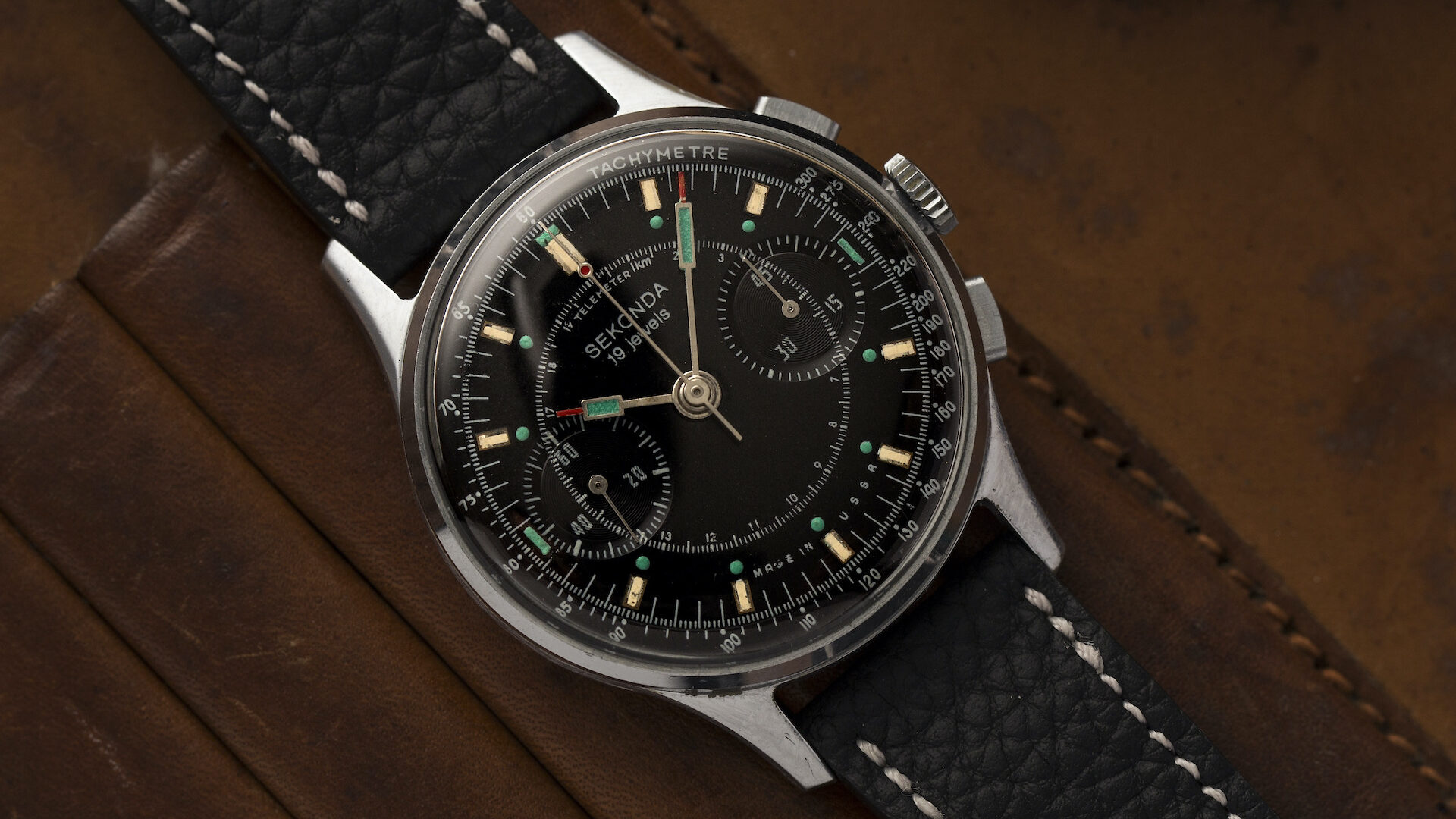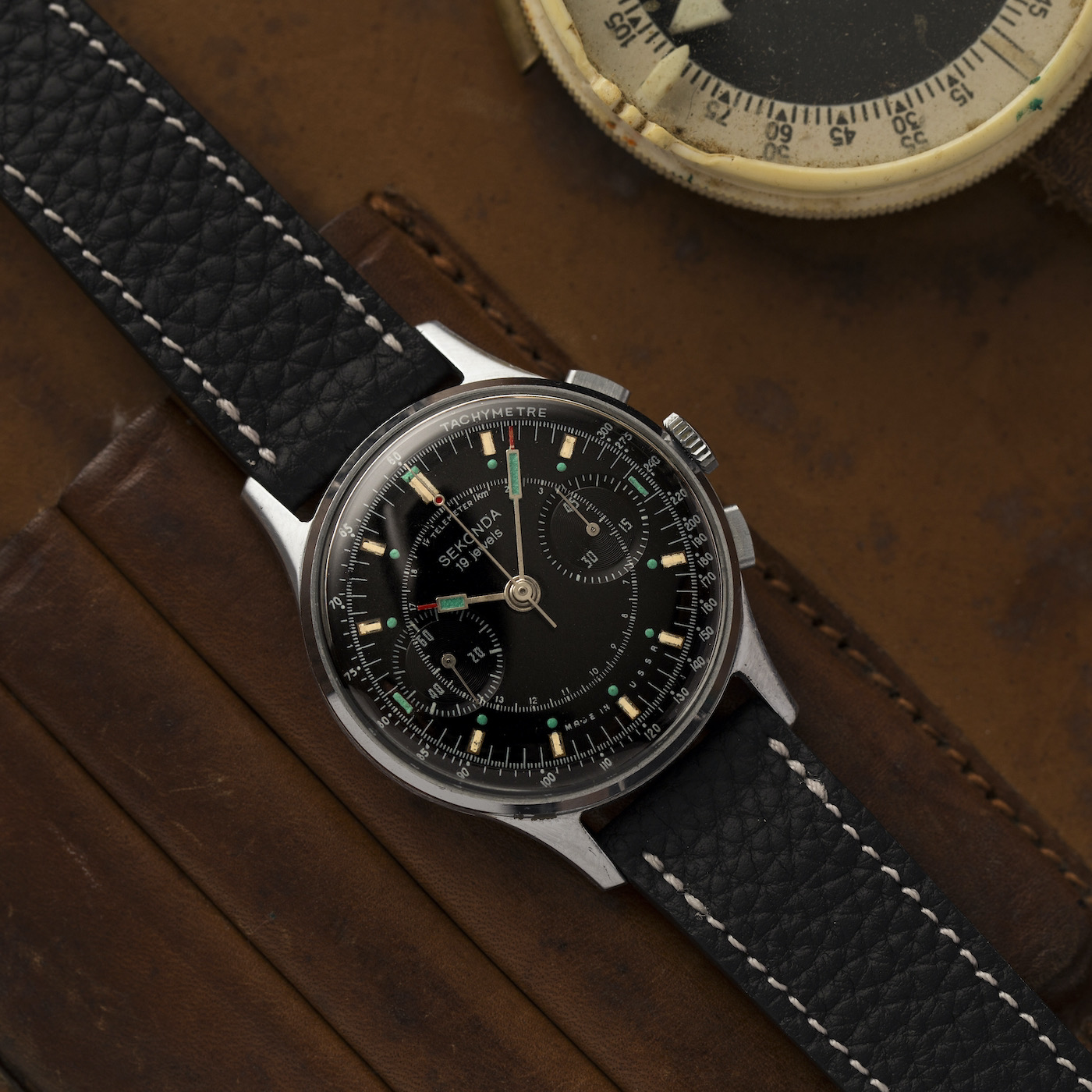
If you’re new to the vintage watch game, chances are you’ll start by looking at Swiss and Japanese watches. And that makes perfect sense; we’re constantly reminded that these two watchmaking behemoths were instrumental in shaping the world of watches. From not-so-subtle reminders of the brand’s historic accomplishments (did you know the Omega Speedmaster was the first watch on the moon?) to the seemingly endless stream of vintage re-issues, the Swiss and Japanese have done an extraordinary job of celebrating their history as a core facet of their brand identity. It’s no surprise, then, that many watch enthusiasts interested in wading into the sea of vintage watches head straight for brands with a rich and well-documented heritage, such as Rolex, Omega, and Seiko…. and then they scamper right back out again after seeing how high the prices are for these vintage pieces and realizing that the vintage market is fraught with danger (fakes, re-dials, frankenwatches, etc.).
For those brave souls willing to venture a bit offshore, the next stop on their vintage search may be some of the smaller Swiss brands or any of the myriad now-defunct brands annihilated by the quartz crisis that were making stellar watches with parts and movements often coming from the same factories as the big boys. Venture a bit further, still, and you’ll find the swirls and eddies in which the collecting subcultures gather. German and British watch collectors, of course, but then there are the sub-sub-cultures – those dedicated to specific eras of watchmaking history, like the Dirty Dozen watches worn by the British Forces, Vietnam War-era Seikos or the East German watches from before Glashütte was razed to the ground.
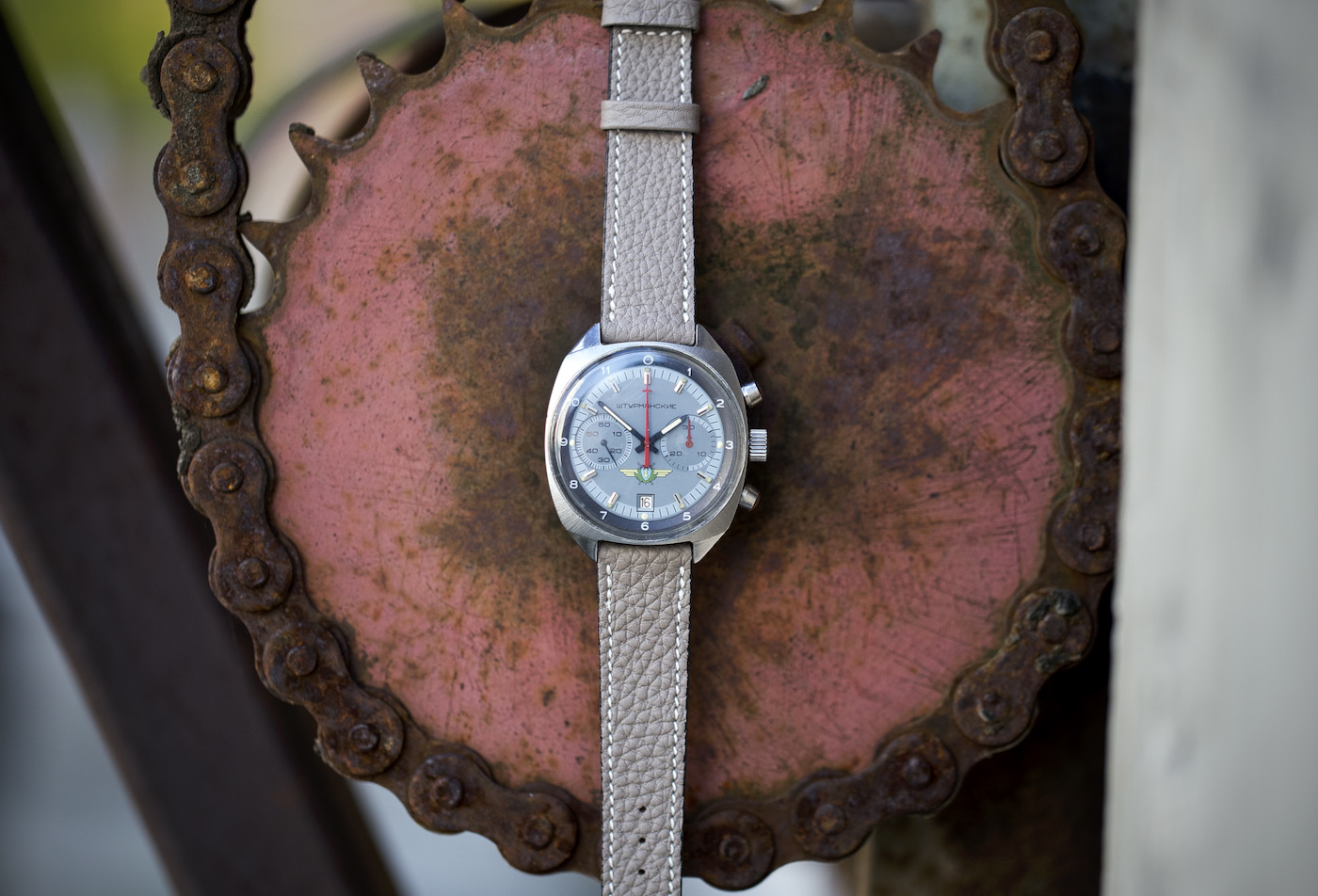
Shturmanskie-branded chronograph with caliber 3133 movement. These watches were made for professional aviation use in 1980s.
It may take some time, but eventually you’re bound to come upon the wild and wonderful world of Soviet watches. But be prepared, the history of Soviet watchmaking and the watches produced during this period (early 1930s until the collapse of the Soviet Union) are so utterly different and unfamiliar that you shouldn’t venture in unprepared. Luckily, we have three of the best minds in the Soviet watch collecting community to guide us on our journey:
Blaz Slamic is a self-trained Slovenian watchmaker and electromechanical engineer who has been obsessed with Soviet watches for the past decade. This obsession quickly turned to madness, and Blaz has been focused on finding and collecting rare Soviet watches, with an emphasis on rare and unique movements.
Yuri Kravtsov blames Blaz for getting him addicted to Soviet watches after years of collecting a vast array of vintage watches from Rolex to GUB to Grand Seiko. A local in the beating heart of vintage Soviet watch collecting (Moscow), Yuri is passionate about both watches and the history of Soviet watchmaking – be sure to check out his Instagram @sovietwatchmuseum, where he shares his love for Soviet watches and can help you with your Soviet watch questions.
Andrew Babanin is a prominent Russian watchmaker operating out of Moscow. His collection of Soviet and non-Soviet watches is extensive (to put it lightly) and ranges from complicated early pocket watches to Soviet LED Electronika watches. Andrew writes extensively on Soviet watches, and you can find his articles here.
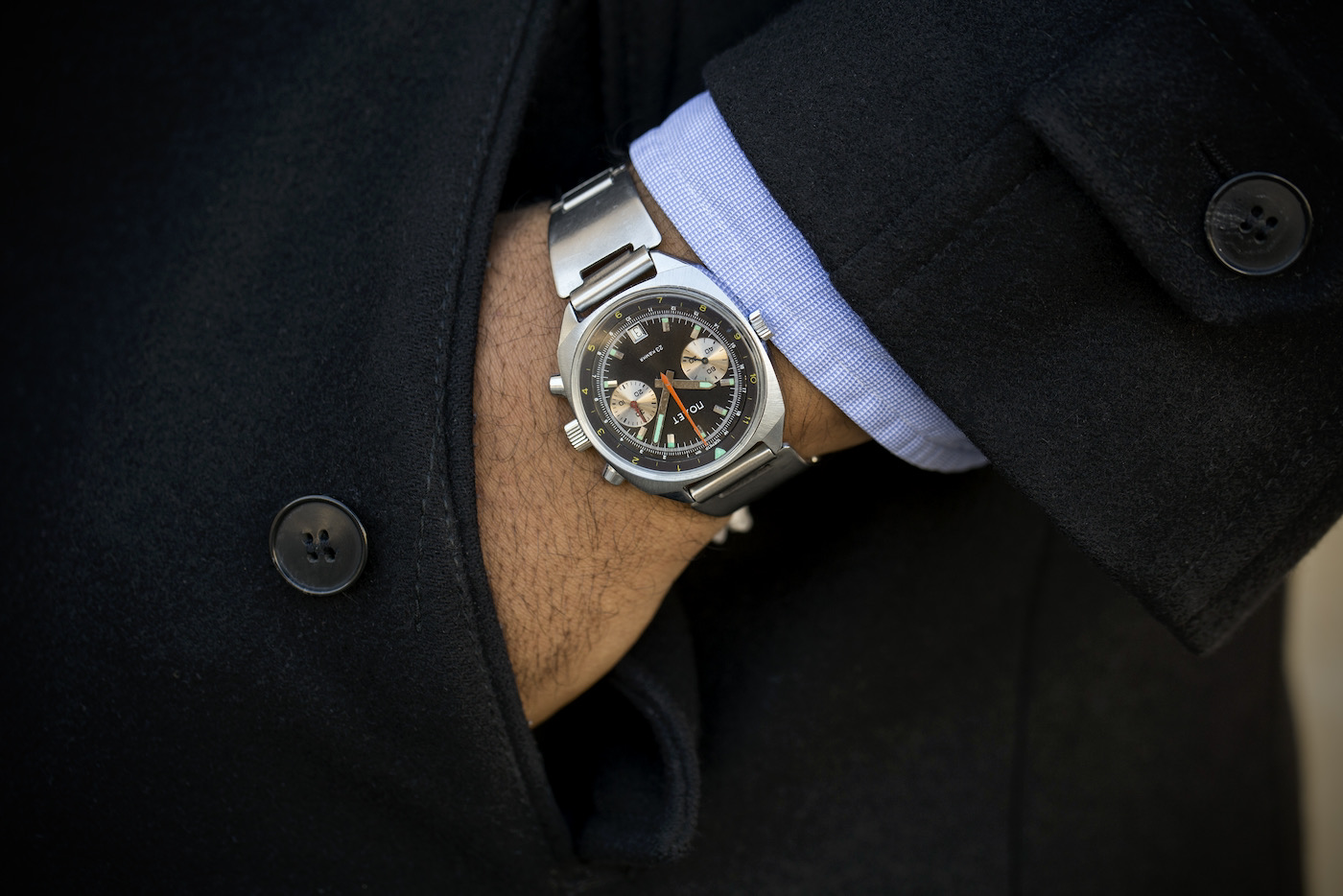
Black dial Poljot chronograph with a 3133 manual wind movement.
If you conjure an image of the early Swiss watchmaking industry and it brings to mind bespectacled artisans working away on aged oak desks, producing watch parts with bespoke hand tools passed on from master to apprentice, you’re really not far off the mark. Early Soviet watchmaking? Not so much. Admittedly, the history of Soviet watchmaking is not nearly so romantic, but it’s no less intriguing.
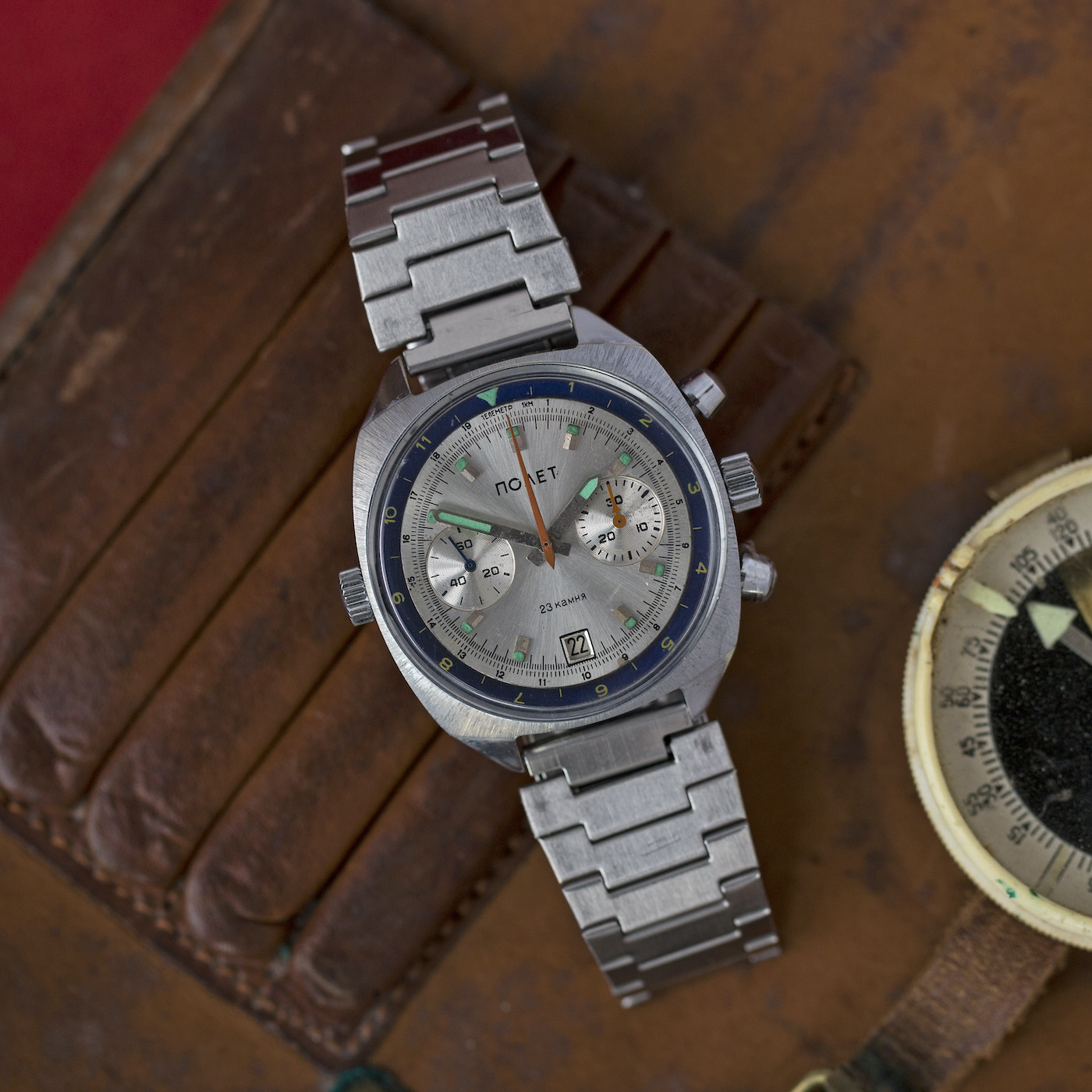
A nice early 3133 chronograph with Cyrillic dial.
As we’ll learn when we dig into the Kirova Type 1, Soviet watchmaking didn’t emerge until the 1930s – with help from America, of all countries. The following decades were a fascinating mix of innovation, scrappy perseverance, and outright plundering of everything from movement designs to entire factories. If you’re looking for intrigue and some seriously fascinating stories, you’ll find them in the history of Soviet watches.
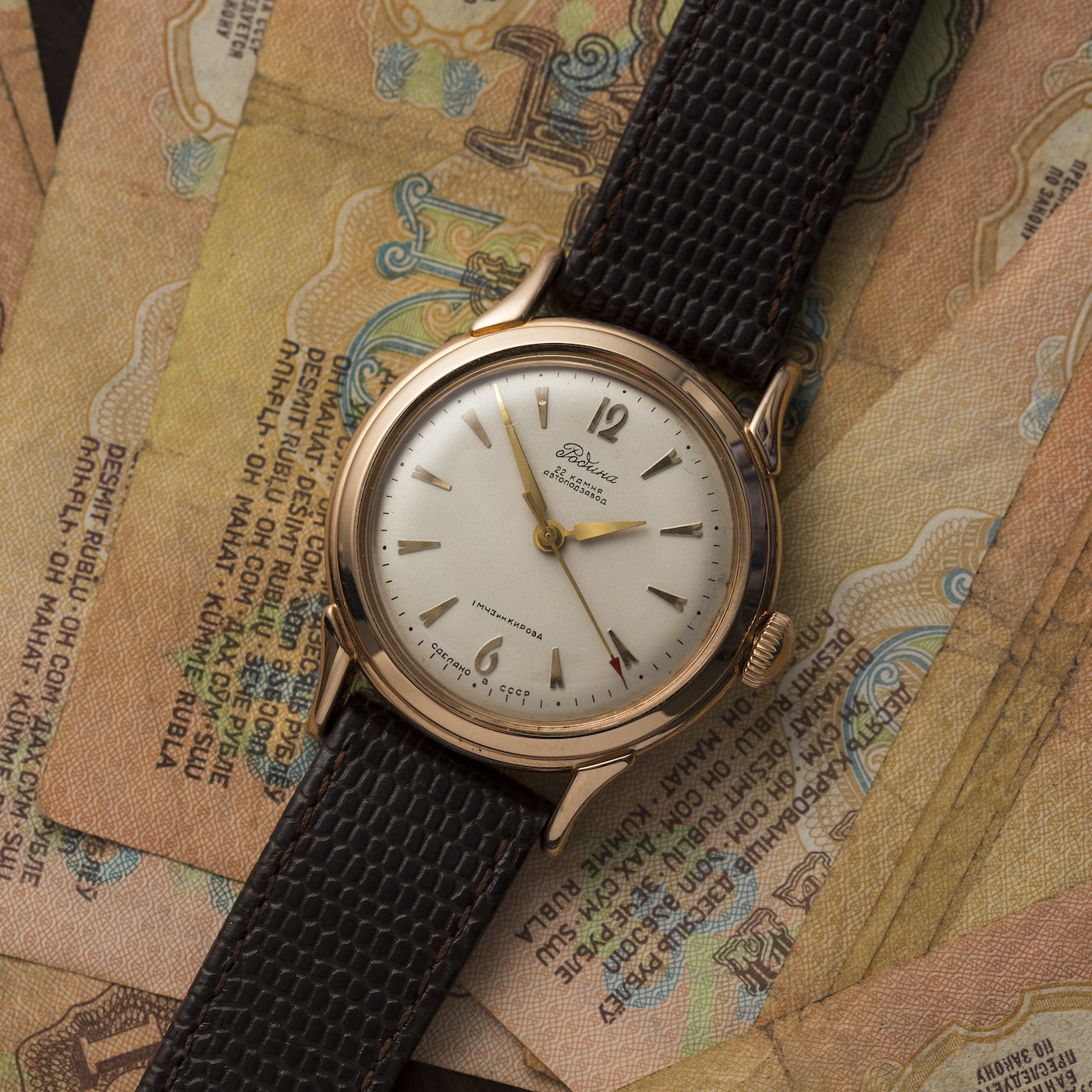
Rodina: the first Soviet automatic watch. This is a rare version with a gold case.
Keep in mind that, like all manufacturing in the Soviet Union, watchmaking was state-run and centralized. The watches produced were purpose-built, and whether for civilians, professional applications, or the military, the watches were produced as tools. This is a fundamental difference from watchmaking in places like Switzerland. Sure, many watches were produced as tools, often through contracts with militaries and governments around the world, but watches were primarily made to be sold on the open market, allowing for significantly more freedom in design, complications, and ultimately innovation. But don’t misunderstand — Soviet watches were nothing if not creative and unique — just see some of our picks below!
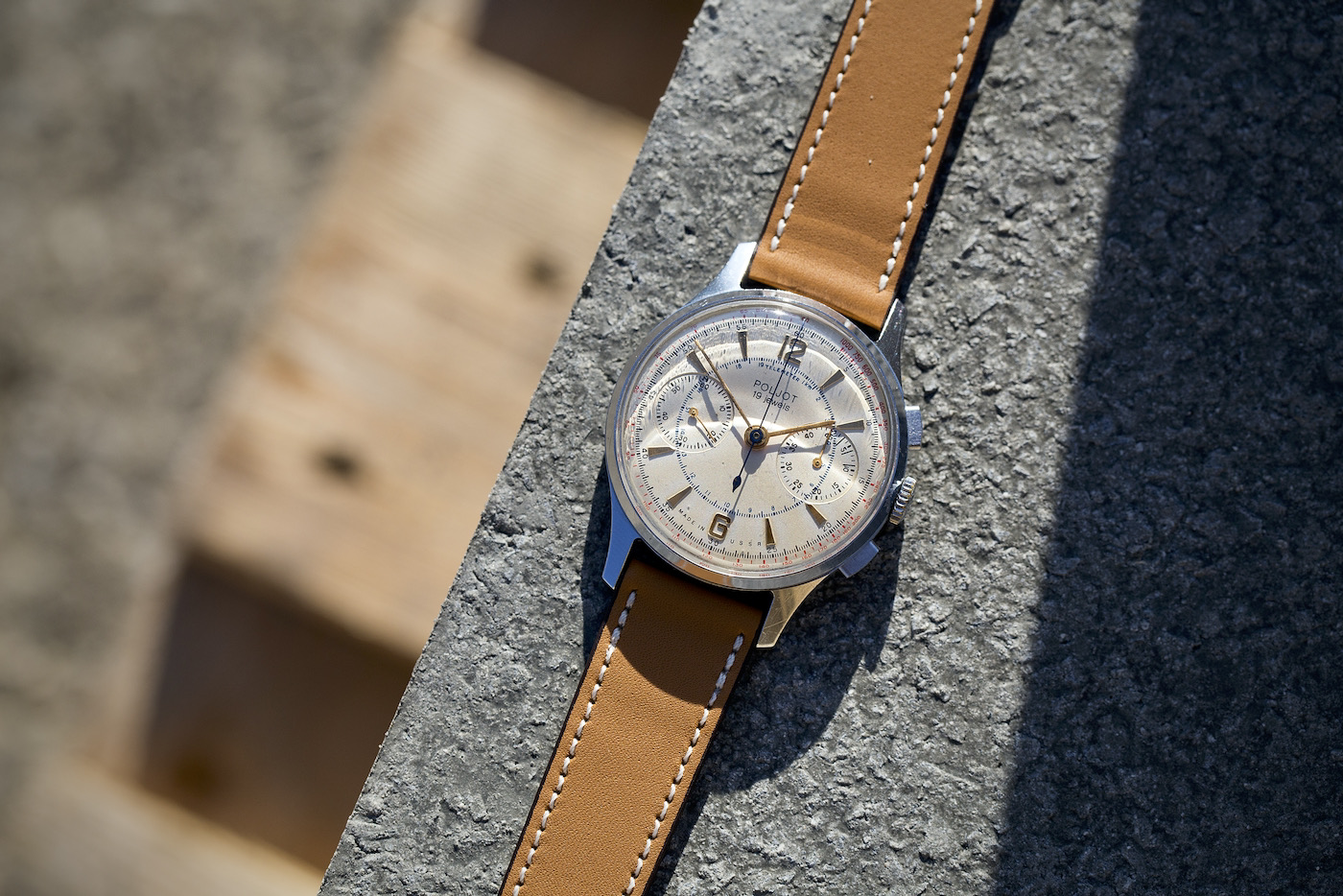
Second generation ”Telemeter” 3017 caliber Poljot chronograph.
We couldn’t hope to do justice to the entire depth and breadth of Soviet watchmaking in a single article (or book for that matter), but hopefully we can introduce you to a few interesting vintage Soviet watches to start you off on the right foot. This is just a snapshot of the breadth of watches you can find when venturing into the world of vintage soviet watches, and one thing you’ll undoubtedly notice is just how reasonable the prices are compared to their Swiss and Japanese counterparts. So, without further ado, let’s get into the watches.
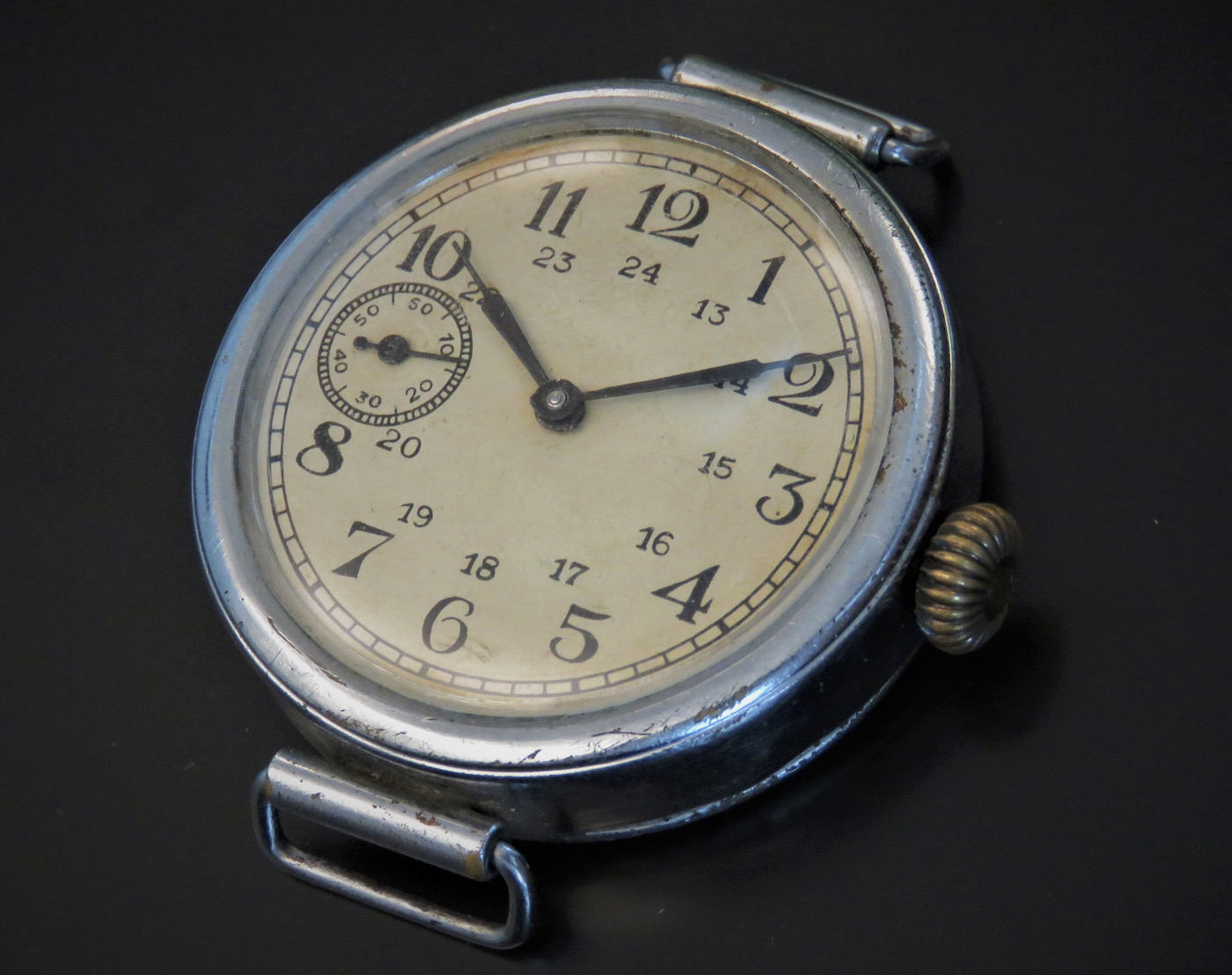
Kirova Type 1
If you’re jumping into Soviet watches, why not start at the beginning of Soviet watchmaking? The Kirova Type 1 was the first watch produced entirely in the Soviet Union, with early models moving off the factory floor in the 1930s. Soviet watchmaking was essentially nonexistent in the 1920s, so rather than start from scratch, the Soviet Union purchased the entire Hampden manufacturing plant and had it shipped from Canton, Ohio all the way to Moscow. Not just the machines, mind you, the Soviets purchased everything from spare parts to expertise – Hampden workers were sent to Moscow right along with the machinery in order to spend a year teaching Soviet workers how to manufacture watches.
The Kirova Type 1 (the Type 1 appellation bestowed upon the watch because it represented the first true Soviet caliber) came in both pocket and wristwatch versions in a variety of styles depending on the application. However, what unifies the Type 1 watches are the movements housed inside – Soviet reproductions of the Hampden size 16 “McKinley” caliber. In fact, during the first few years of production, many of these watches still contained spare parts that came over on the ship with the factory (take a look for American markings on these early movements). Like so many things concerning Soviet watches, however, the origin of any one particular Kirova Type 1 can be a challenge to track.
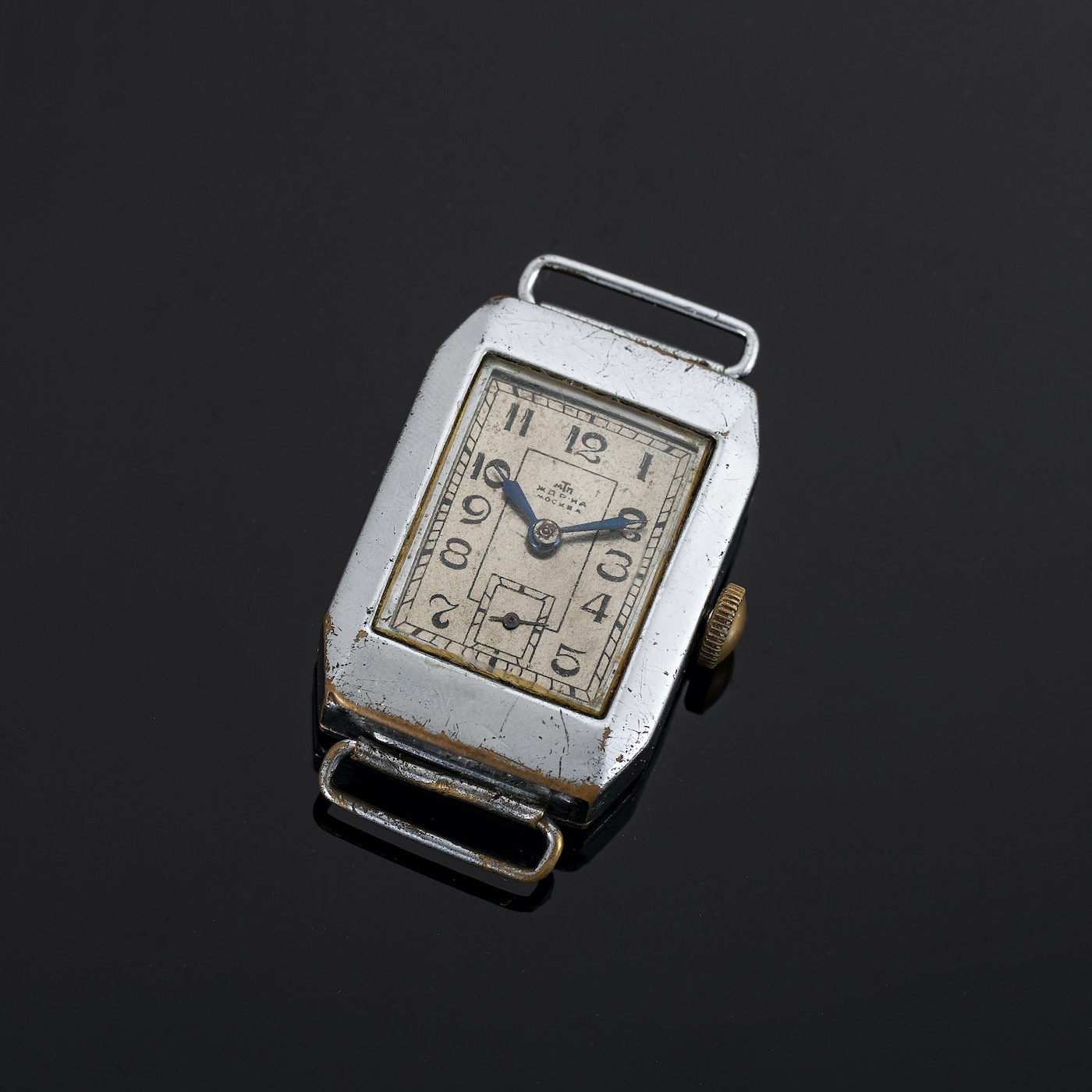
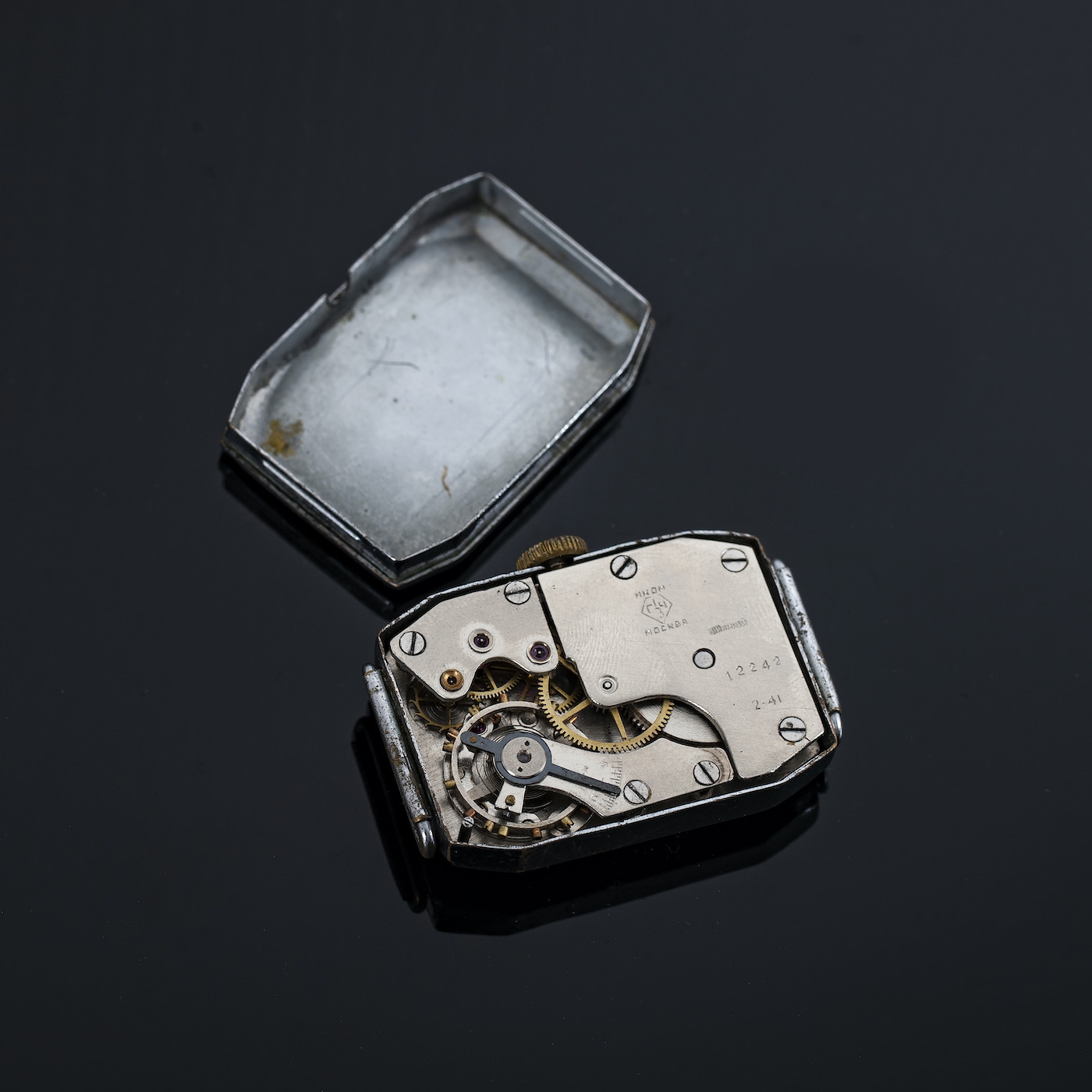
The Kirova Type-17 watch was the first truly Soviet-designed watch, with a completely Soviet-designed and manufactured movement. Very few were ever produced and, sadly, examples in good condition are nearly impossible to find today.
Though the first Type 1 watches to roll off the line came from the original facility in Moscow, or the First Moscow Watch factory (also known 1GChZ, 1MChZ, Kirova, and eventually Poljot), the demand proved too much for a single factory and the Second Moscow Watch Factory (2MChZ, now known as Slava) started production of wrist and pocket watches in the late 1930s. That Moscow location was short-lived, however, as the bombings of Moscow during World War II forced a relocation of both factories…then the history gets complicated with production moving to different cities and locations across the Soviet Union and two more factories beginning to produce Type 1 watches – ChChZ (Chistopol Factory, now known as Vostok) and ZChZ (Zlatoust Factory).
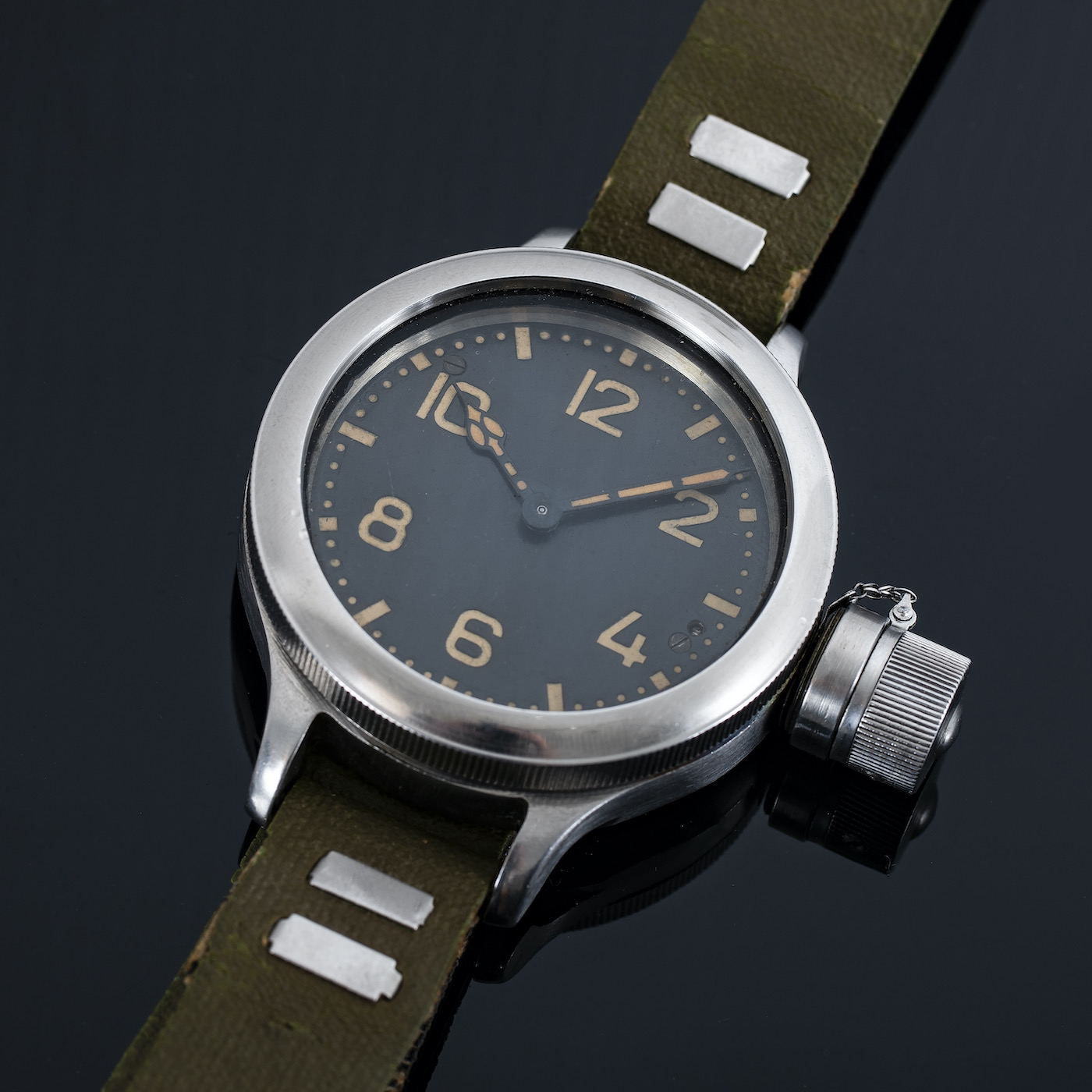
The “Vodolaz” Zlatoust diver Type 1 was produced for hard hat divers and can withstand extreme water pressures. The large size (~60mm diameter) won’t be for everyone.
Despite this tumultuous history, Type 1 watches were produced continuously until the 1960s, with Zlatoust being the last of the factories continuing to produce Type 1 watches for the military. With a massive amount of variation in style and type – everything from field to dive watches – the Type 1 watches remain united by their history and movement. If you’re looking for a place to start your search and are interested in military watches, be sure to check out the black-dialed Paratrooper. The paratroopers are housed in a distinctive two-piece “sauce pan” case (the bottom looks like a cheap cooking pan), massive numerals and hands coated with radium lume, and you’ll find a military record number stamped or just painted on the dial (although some examples don’t have these numbers at all).
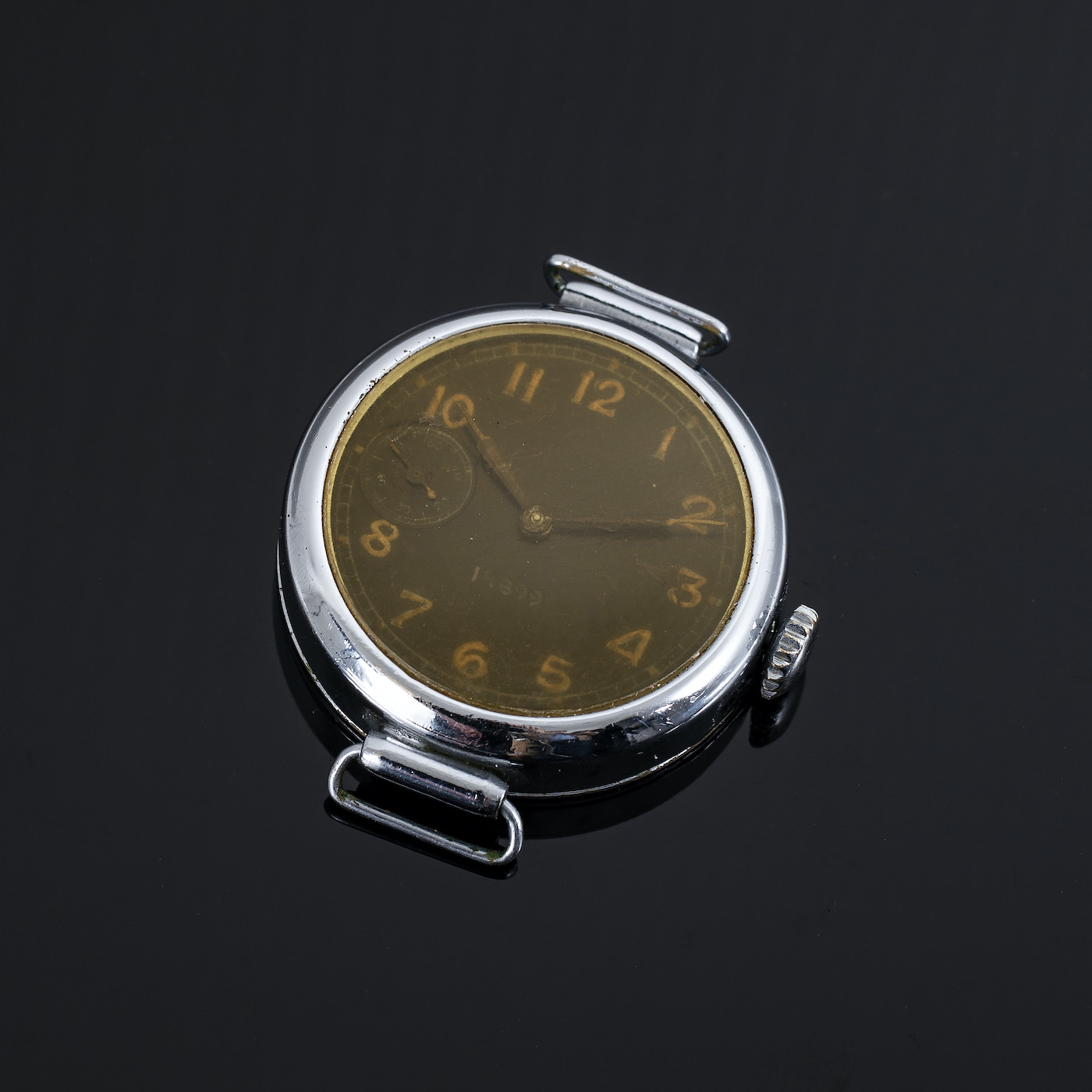
The “Paratrooper” Type 1. These lumed, black dial versions that bear unique soldier’s numbers on the dial are difficult to find.
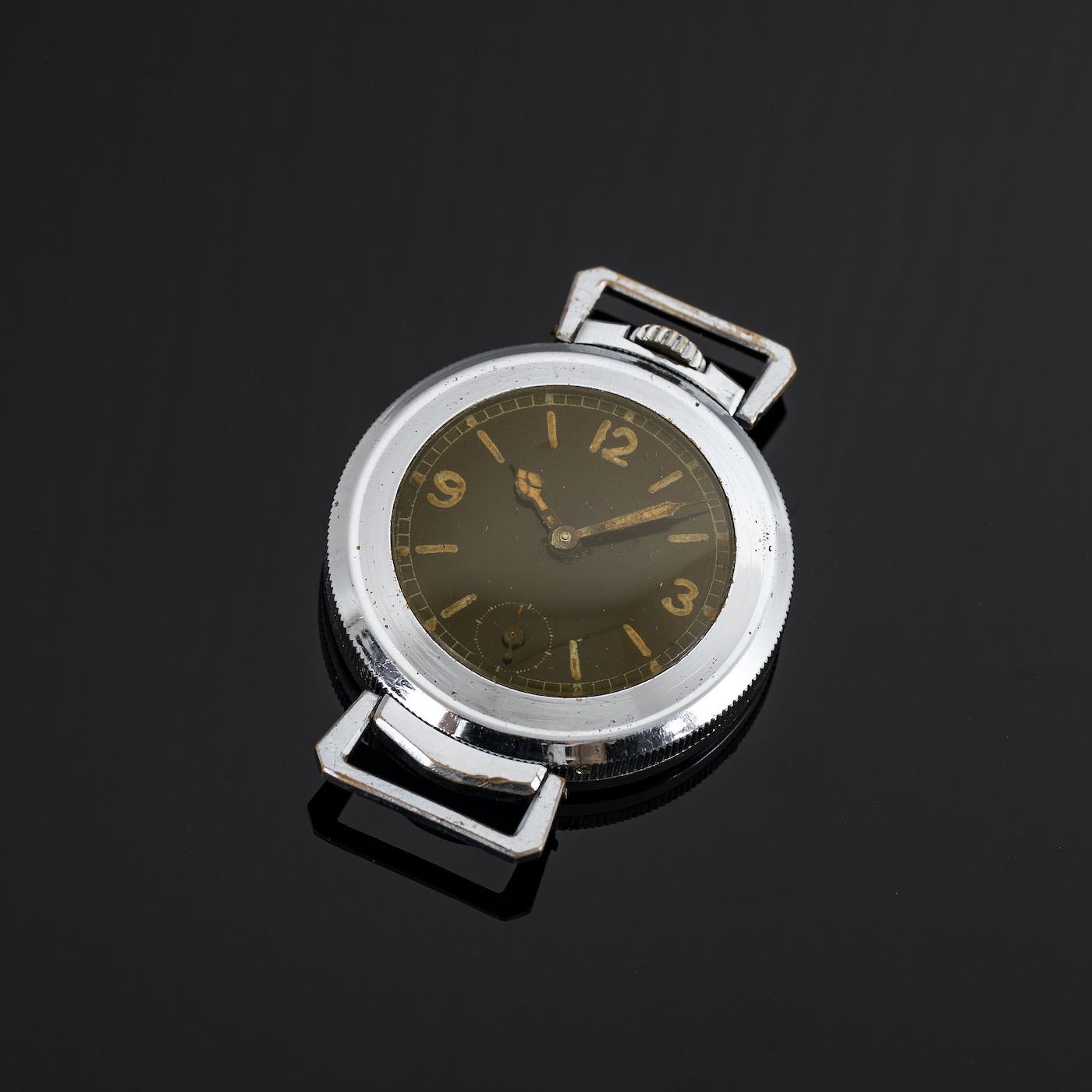
Ultra rare example of special black lume dial Type 1 in a special case. Only a few examples of this watch are known to exist.
Movements on the paratroopers typically don’t bear any signs or gravures but be sure to look for the brass-colored upper balance jewel plate indicative of being made in the 2MChZ or ChChZ factory. Keep a close eye out for redials – the original Paratrooper dial will be in rough shape and will definitely not have any logos, deathheads, red stars on the dial, only a faint white handwritten military record number. Depending on the quality, Paratroopers can be found starting at around $300 USD.
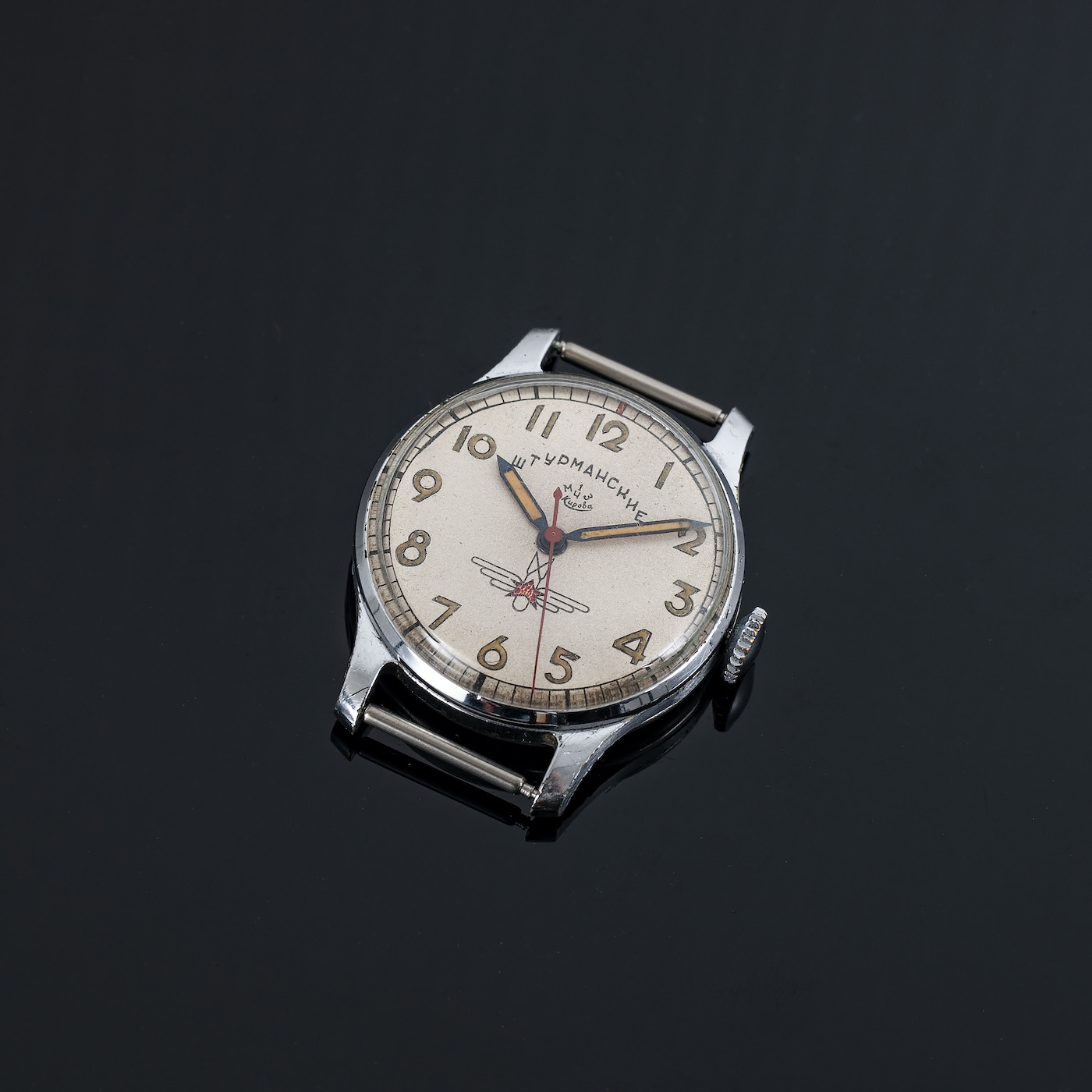
1st and 2nd Generation Shturmanskie
The Kirova Type 1 launched the Soviet watchmaking industry, but after World War 2, it was time for innovation. After all, the Kirova Type 1 watches were based on a movement initially developed in the 1800s. By this time, the Europeans and Japanese had developed movements that well-surpassed the Type 1 in both accuracy and durability. Luckily, the Soviets had planned ahead – prior to the war, the Soviets partnered with French Watchmaking giant LIP to build a new watch factory in the town of Penza. After successful completion of the T-18 (Zvezda, translation: Star) caliber, the Soviet/LIP team set their sights on a new, modern movement codenamed Pobeda (translation: Victory). The result of this collaboration was a manual-wind, 15-jewel sub-seconds movement ideally suited to wristwatches of the era.
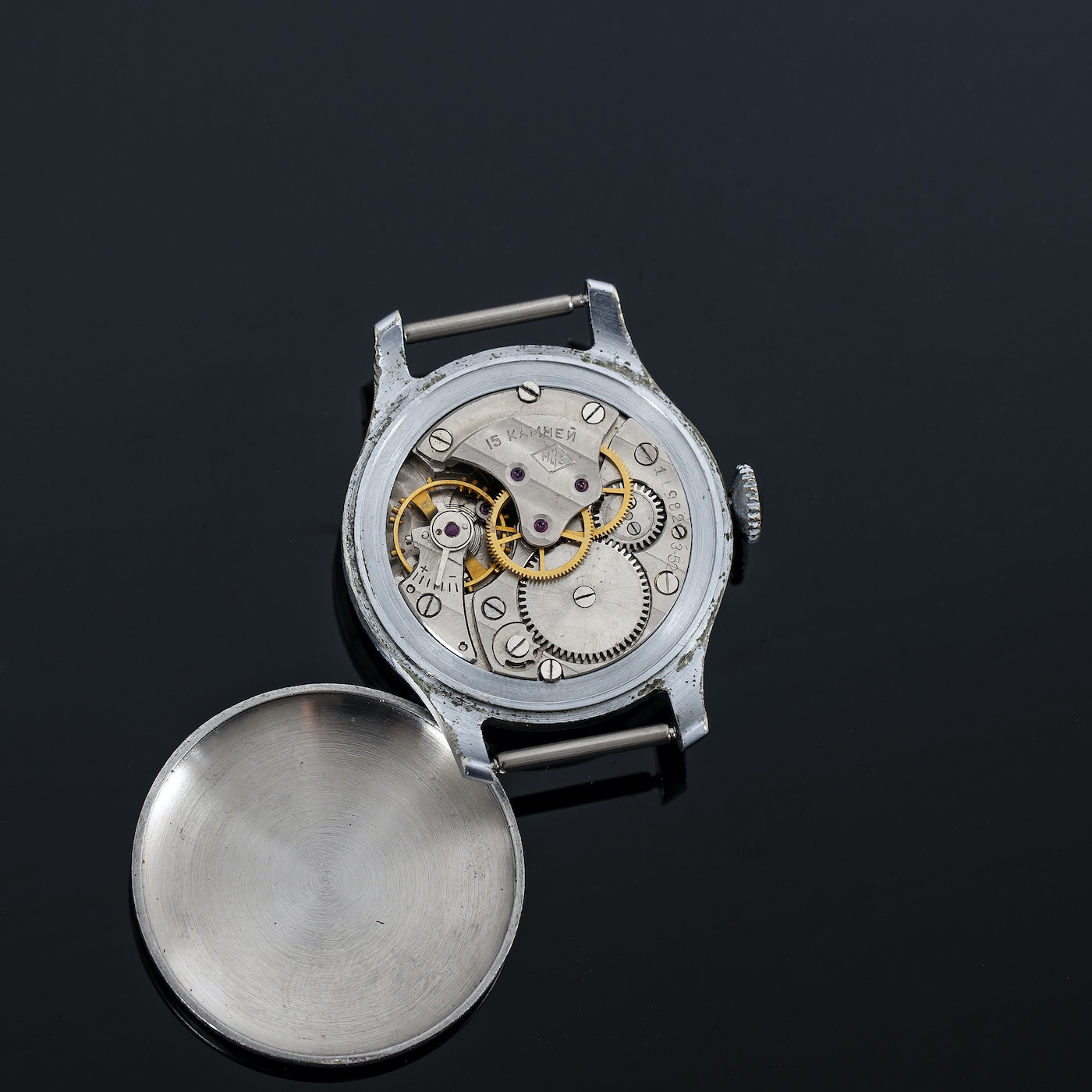
Shturmanskie 1st generation with a distinctive “pillow crown”, and non-water resistant case. These watches, with their rich history and gorgeous designs, are one of the nicest Soviet watches that still be had for a reasonable price (though you’ll have to look carefully).
Production of the Podeba caliber began in Penza in 1945, but due to demand production was moved to the First Moscow Factory (1MChZ) in 1946 (and later to other factories) with the goal of improving the caliber to suit the needs of military personnel, especially pilots. Until this point, the Soviets didn’t have a watch that was accurate and reliable enough for pilots – hence the name Shturmanskie (translation: navigator or pilot). A few short years later, in 1949, the first Shturmanskie watch rolled off the line, complete with a direct-drive central seconds hand, hacking functionality, and accuracy that was up to military standards. That said, the Soviets were now getting into their stride and were making constant strides in improving their watchmaking.
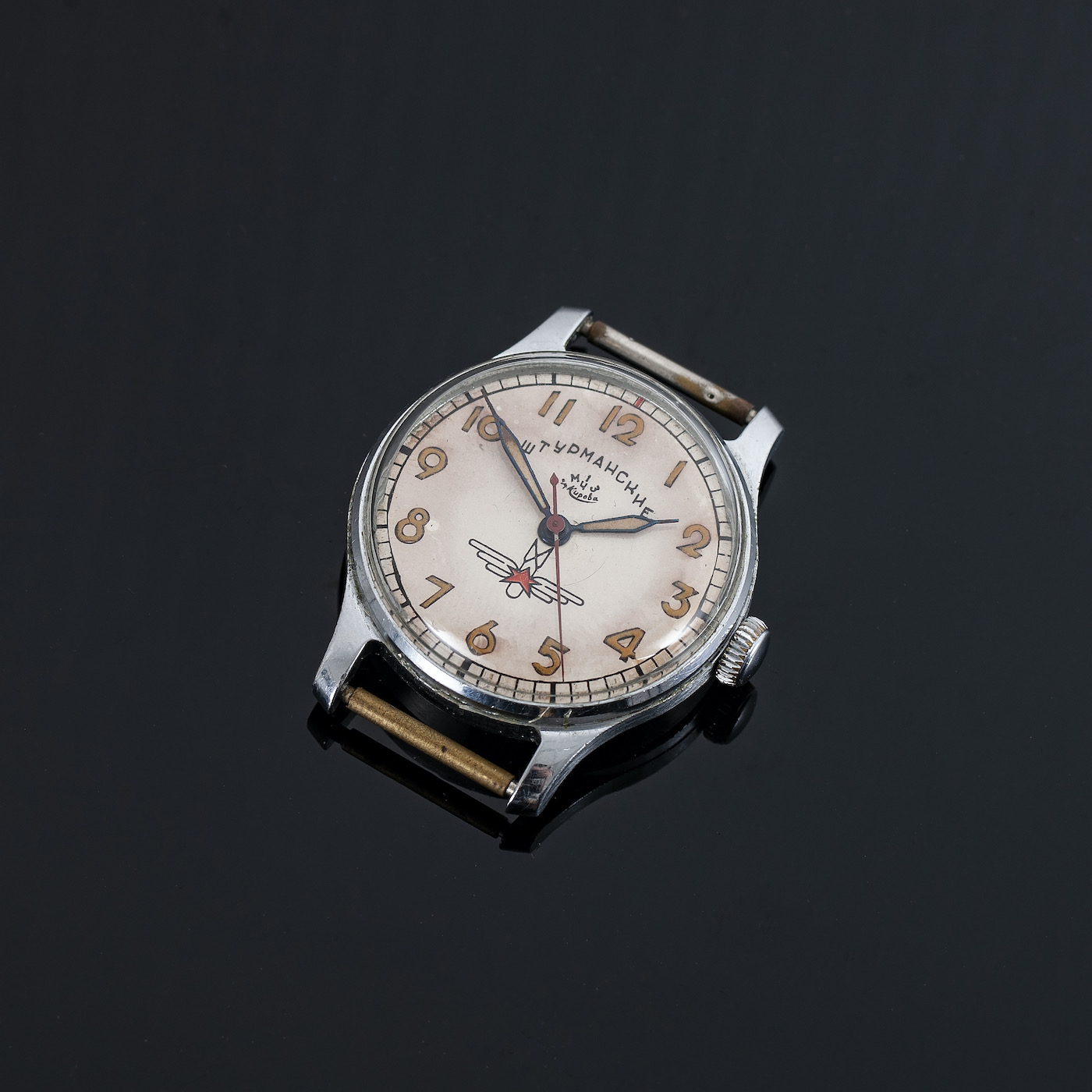
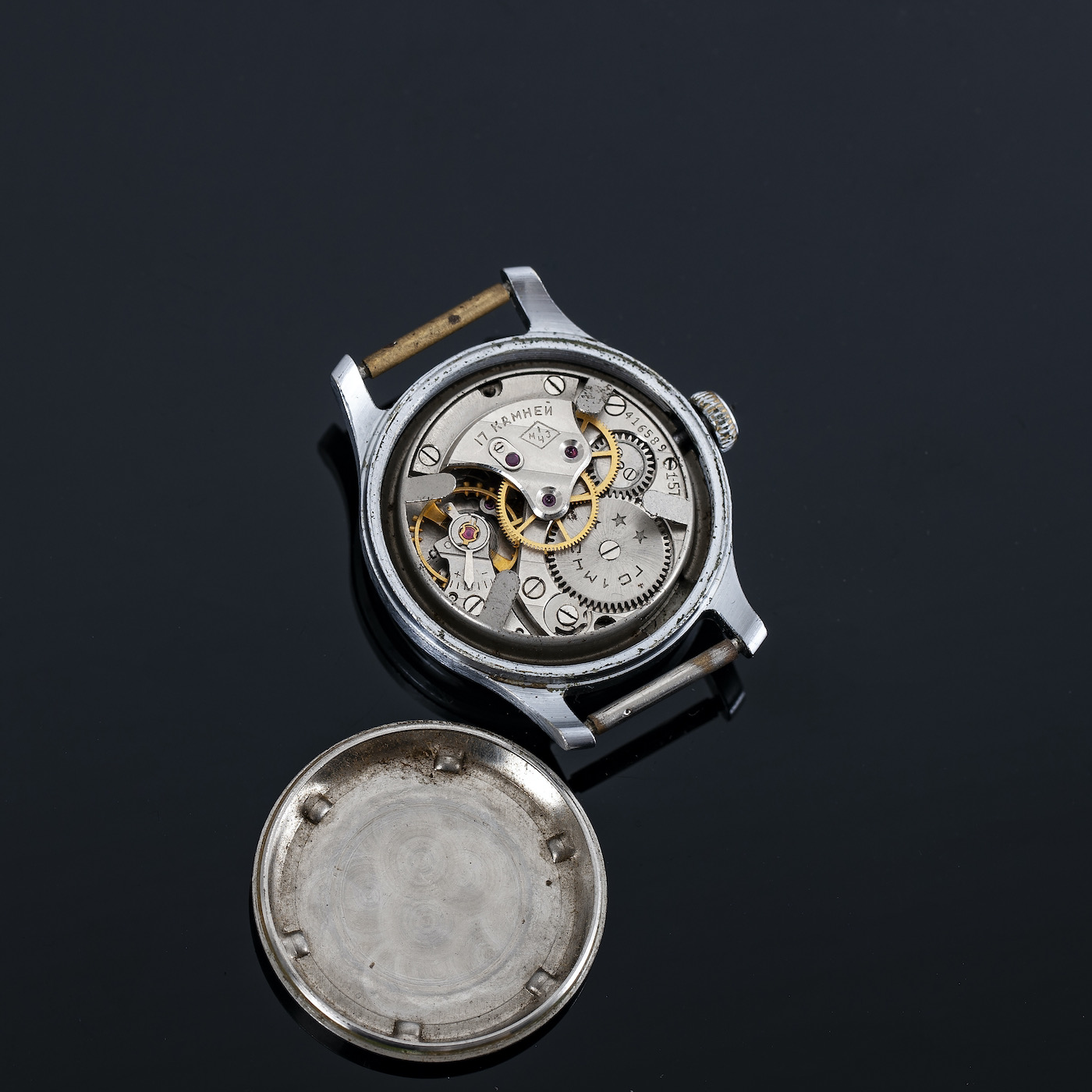
The second generation Shturmanskie is the rarer of the two versions and the true Gagarin watch.
Over the years, the Shturmanskie saw several different improvements, with the most important occurring in 1954, when a new line of Shturmanskie watches were launched. In collector circles, this year marks birth of the second generation Shturmanskies – these included 17 jewels, incabloc shock protection, a new water and dust resistant case (including screw-down caseback), and the loss of the first generation’s pillow crown. Though small by today’s standards, the watches came in an era-typical 33mm with 16mm lug-width.
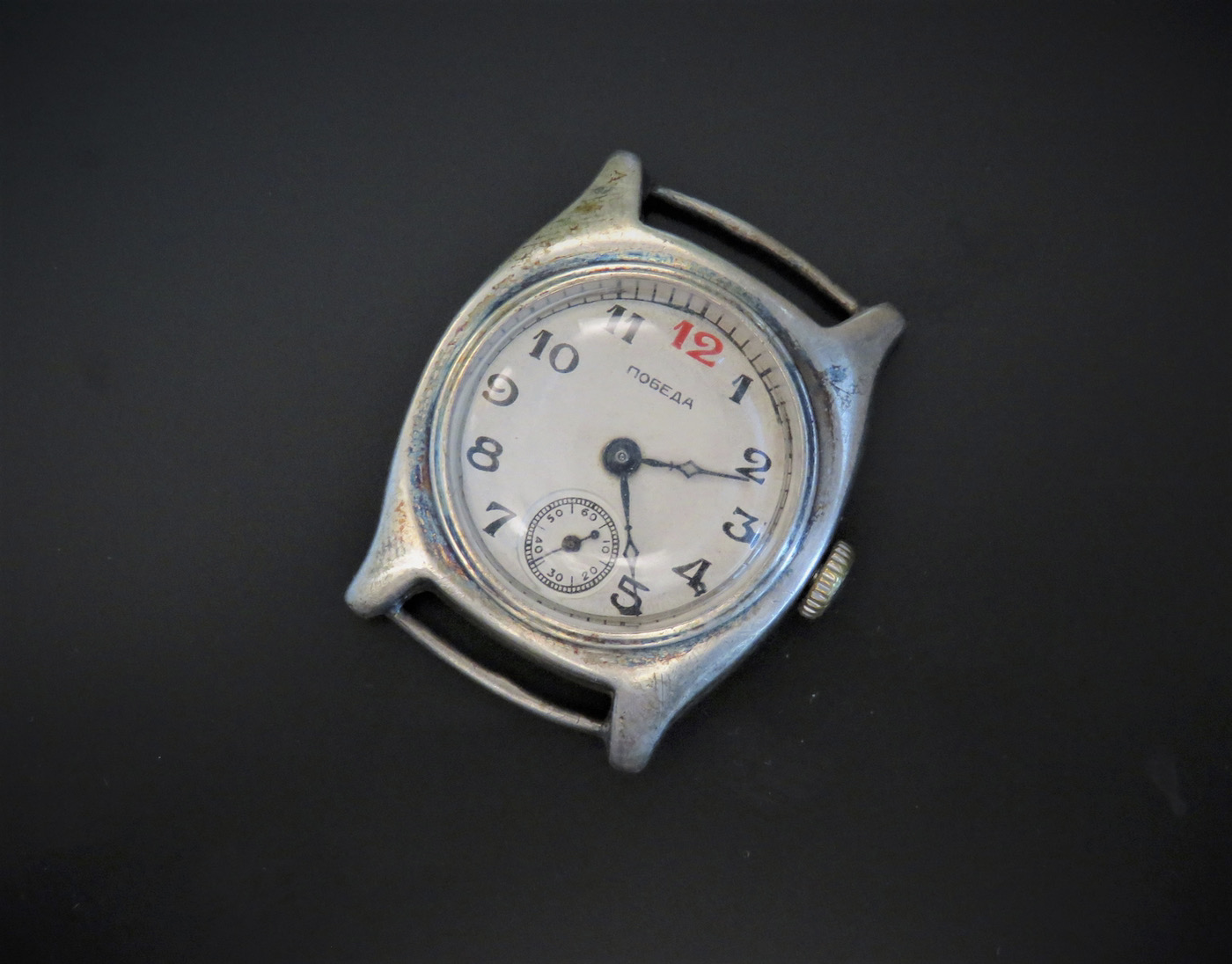
Early (1947) example of a Pobeda watch, with solid silver case and a dial referred to as “Red Twelve.”
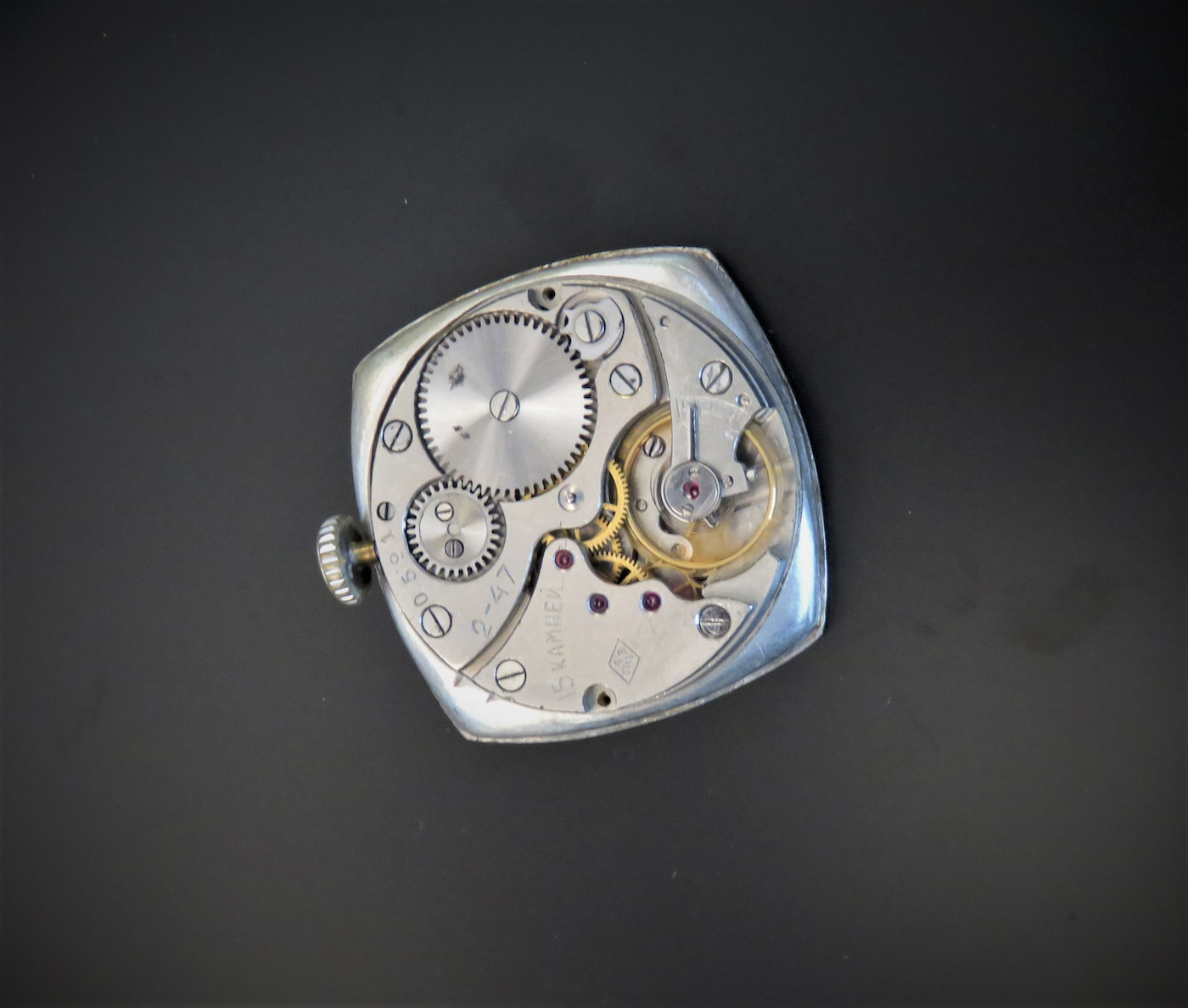
Movement from an early Pobeda. In the early stages, these movements were high quality, but the quality gradually dropped. The Zim factory Pobeda movements were produced almost until the fall of the Soviet Union.
Of all the watches on this list, the Shturmanskie is almost certainly the most famous, thanks to its association with the one and only Yuri Gagarin, the first human to journey into outer space. Now, whether or not Gagarin wore a Shturmanskie when he broke the bonds of earth’s gravity remains a mystery, what is certain is that Gagarin (a General and Army pilot in addition to being a cosmonaut) wore a 2nd generation model when planted on terra firma. Hence, the Shrumanskie is also referred to as the Gagarin Shturmanskie or Gagarin watch.
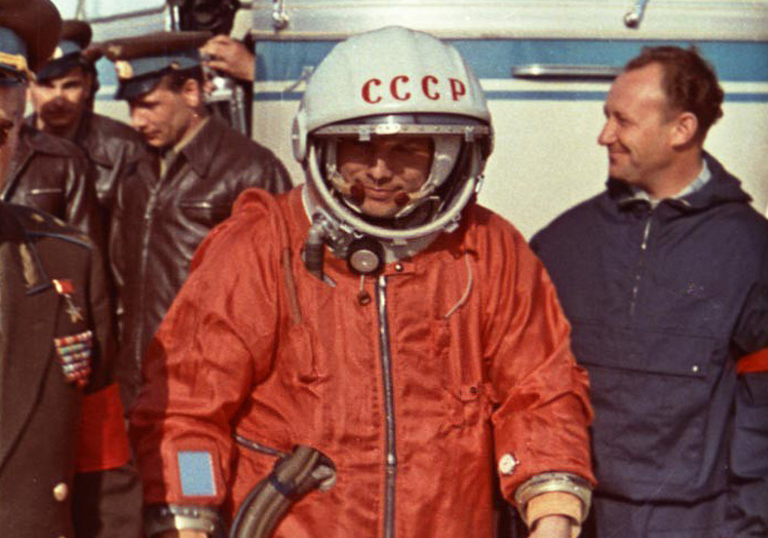
Yuri Gagarin wearing what is likely a Shturmanskie on his left wrist.
Unfortunately, getting your hands on a 2nd generation is considerably more difficult than finding a first generation for sale. If you’re on the hunt for a Shturmanskie, you can certainly find examples, but finding them in decent condition is a near impossible task. Part of the issue is that Shturmanskie watches were only given to professionals and never made available to the public (well, mostly anyway…the Shrturmanskie did make its way onto the wrists of some high-ranking party members and other VIPs), meaning that these were often put to hard use. In addition, the dial quality was quite poor, resulting in massive patina. Given that radium was used for lume on the dial, if you happen to have a dosimeter, that’ll help you determine whether it’s an original dial. The biggest issue is that most of the watches you’ll find for sale have been redialed or “frankened” to some degree. For some tips and tricks for finding a decent example, check here, but expect to spend $300 or more, depending on the condition.
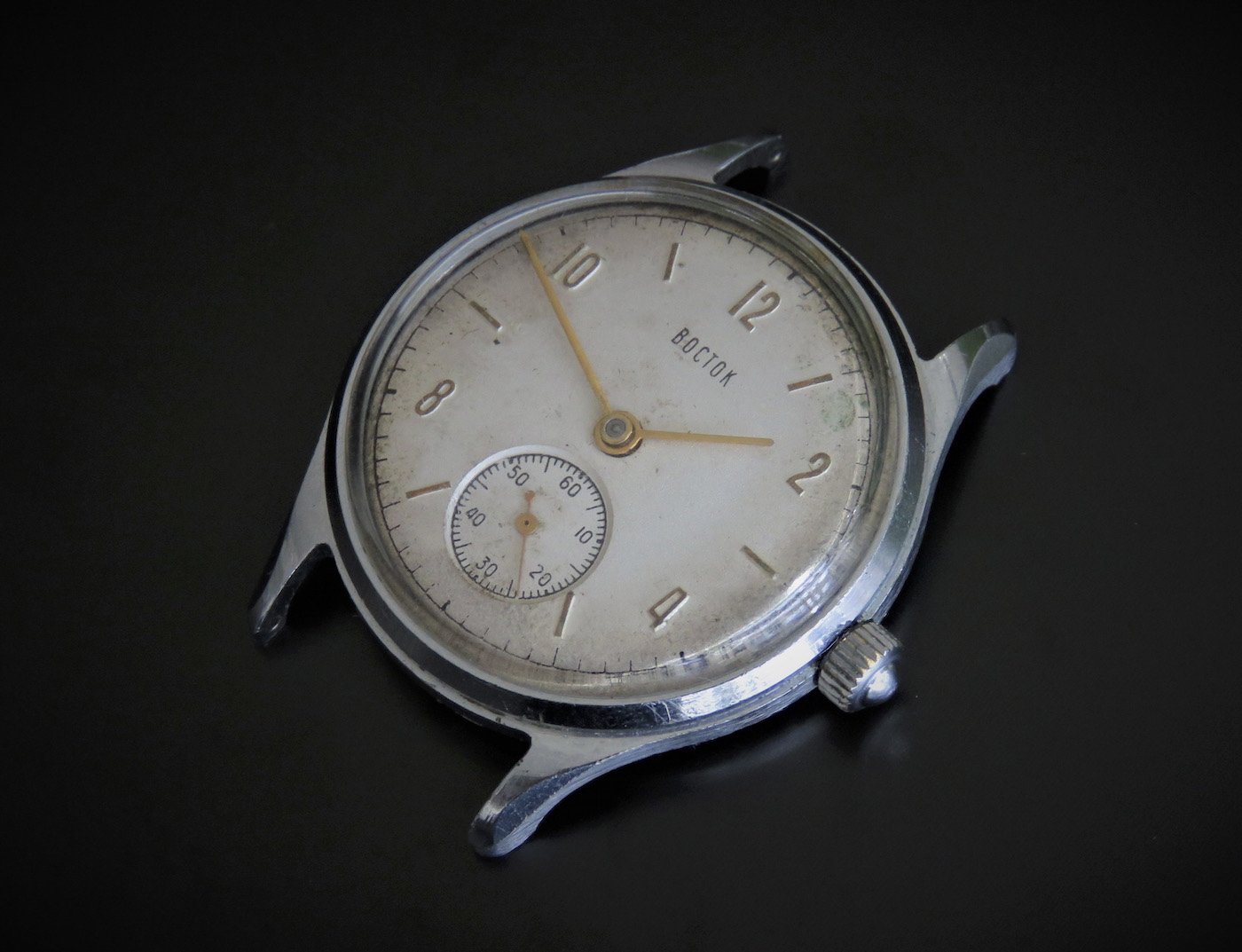
Vostok Precision
By the 1950s, the Shturmanskie was widely deployed across the military and beating away reliably on the wrists of Soviet pilots. However, major innovations in horology were taking place just west of the Iron Curtain with companies from across Europe (and later Japan) competing in the Neuchatel chronometer trials – a celebrated 30-50 day event that tested the limits of accuracy (well, well beyond modern COSC certification). Though the Soviets weren’t looking to compete directly in these trials, they didn’t want to be left behind in the race to achieve chronometer-level accuracy. To do so, a new movement was required.
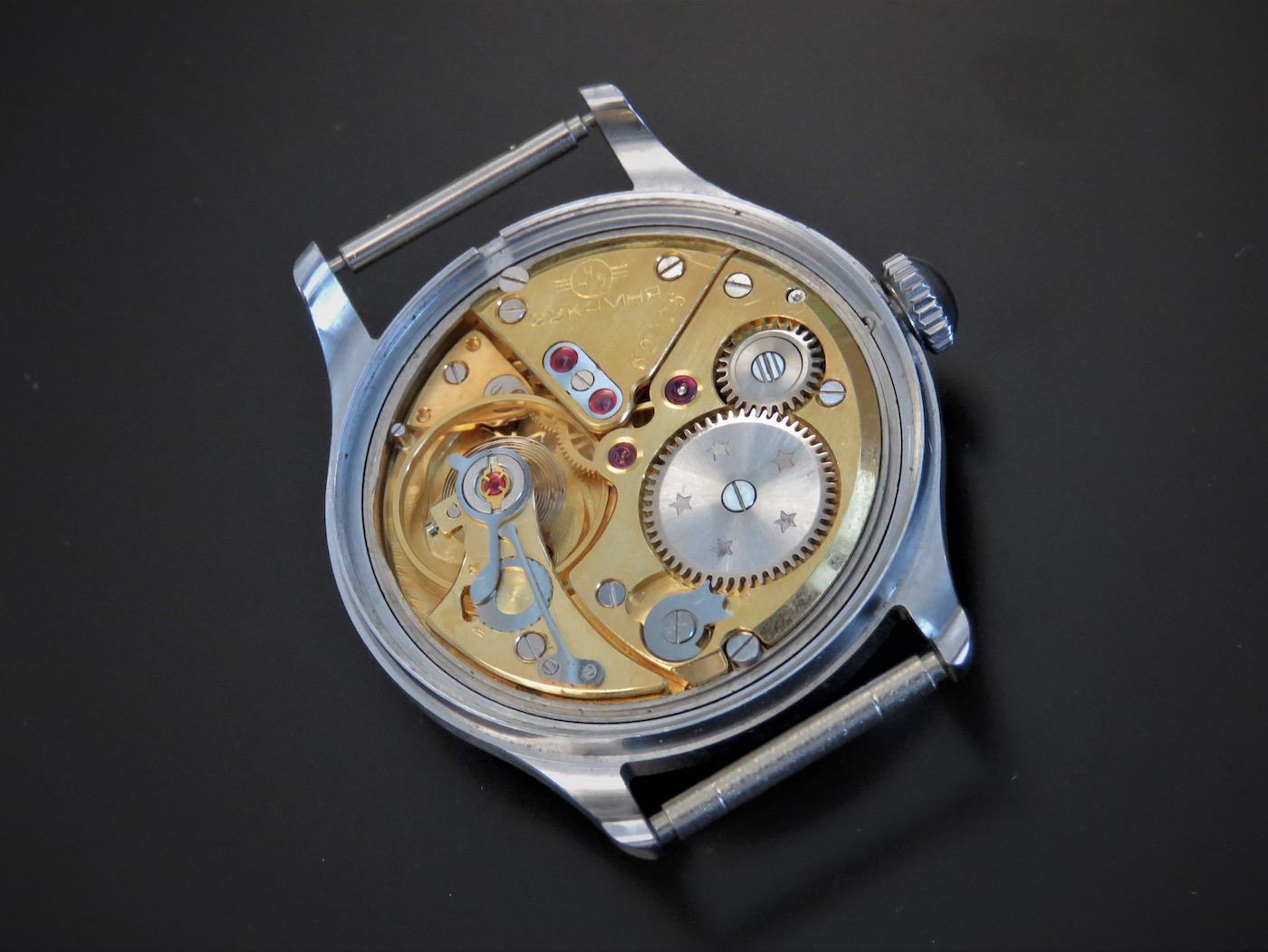
You can easily see how well the Precision movement is built: 22 jewels, micro regulation, and chronometer standard are the main features of this gem.
Rather than start from the ground up (and stretching the limits of intellectual property and patent law), the Soviets decided to reverse engineer the Zenith caliber 135. A good choice, considering Ephrem Jobin’s caliber was one of the most highly awarded movements ever built. Among other innovations, in the Zenith caliber 135 the center wheel was moved to the side in order to create a larger mainspring barrel and balance wheel to improve accuracy. Now, to be fair, the Soviet versions of this caliber (the 2809 and 2802) were not complete copies. Sure, there are similarities in design since both were aiming to have the largest balance wheel with escapement underneath the balance, and the Soviets certainly borrowed a few design decisions, but the Soviets modified the movement extensively and the calibers are certainly distinct (take a look at the layered photo of the the two movements below).
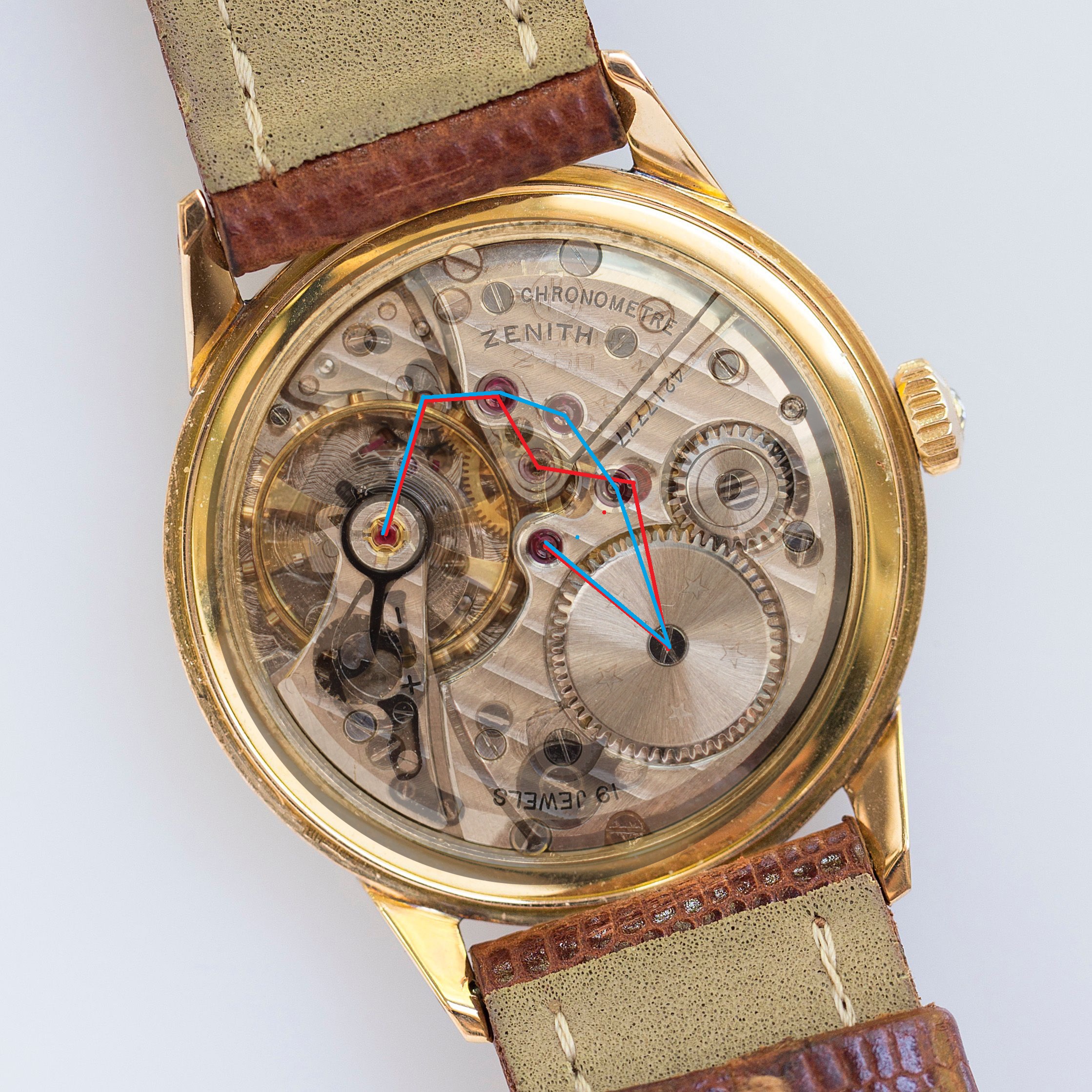
The comparison above shows that even if though the concept for the layout of the watch is same, the Soviet 2809 movement is far from being a copy of the Zenith 135. The movements have been resized for this image because because of the differences in movement diameters.
A note on soviet caliber designations: Every Soviet watch has a four-digit number designation; the first two digits stand for the diameter of the movement and the second two digits describe the properties of the movement. The 2809 was 28mm in diameter and had a central second hand, manual wind, and balance shock protection (09), while the 2802 had the same diameter, sub seconds, and no shock protection.
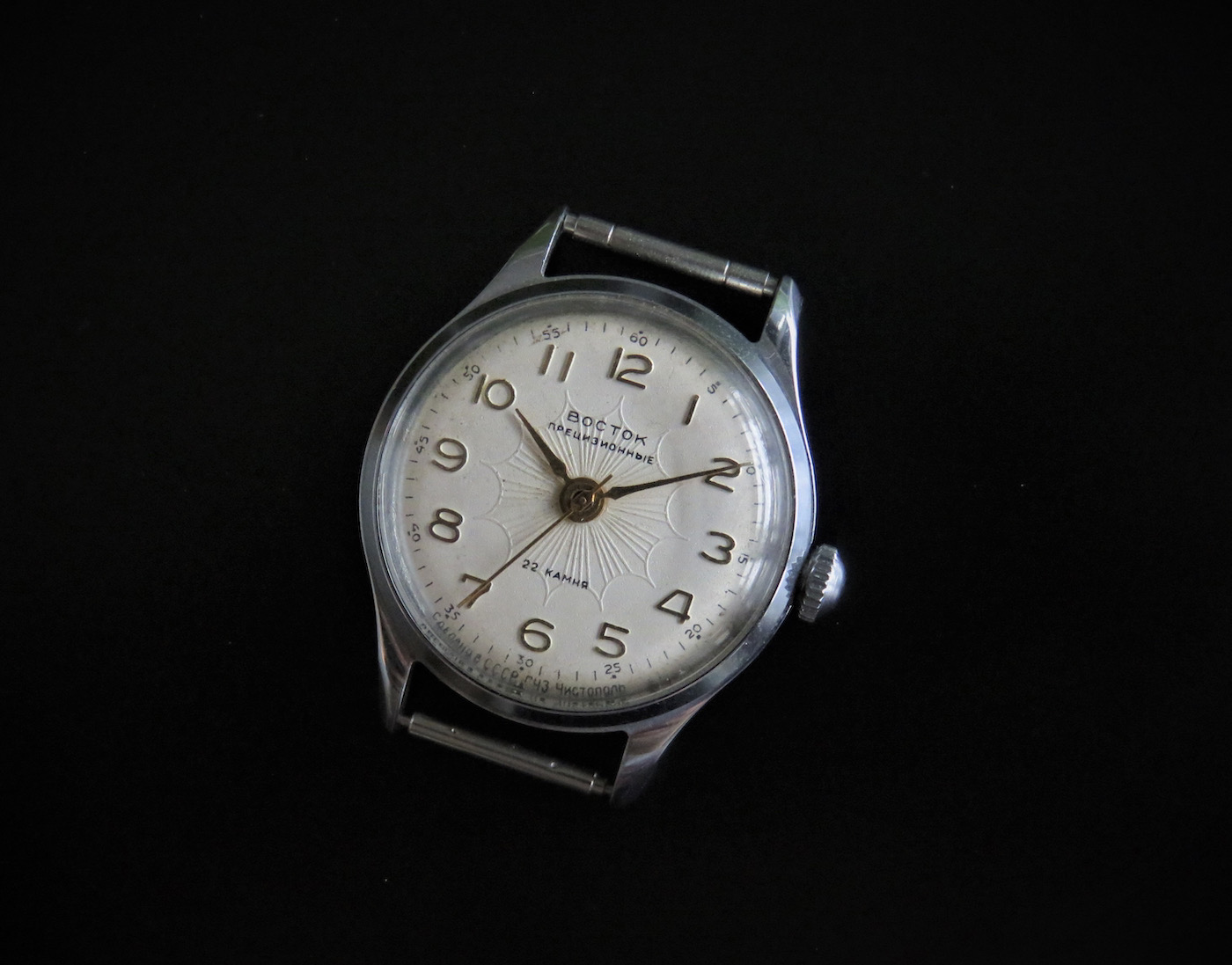
Nice example of a typical Vostok Precision watch.
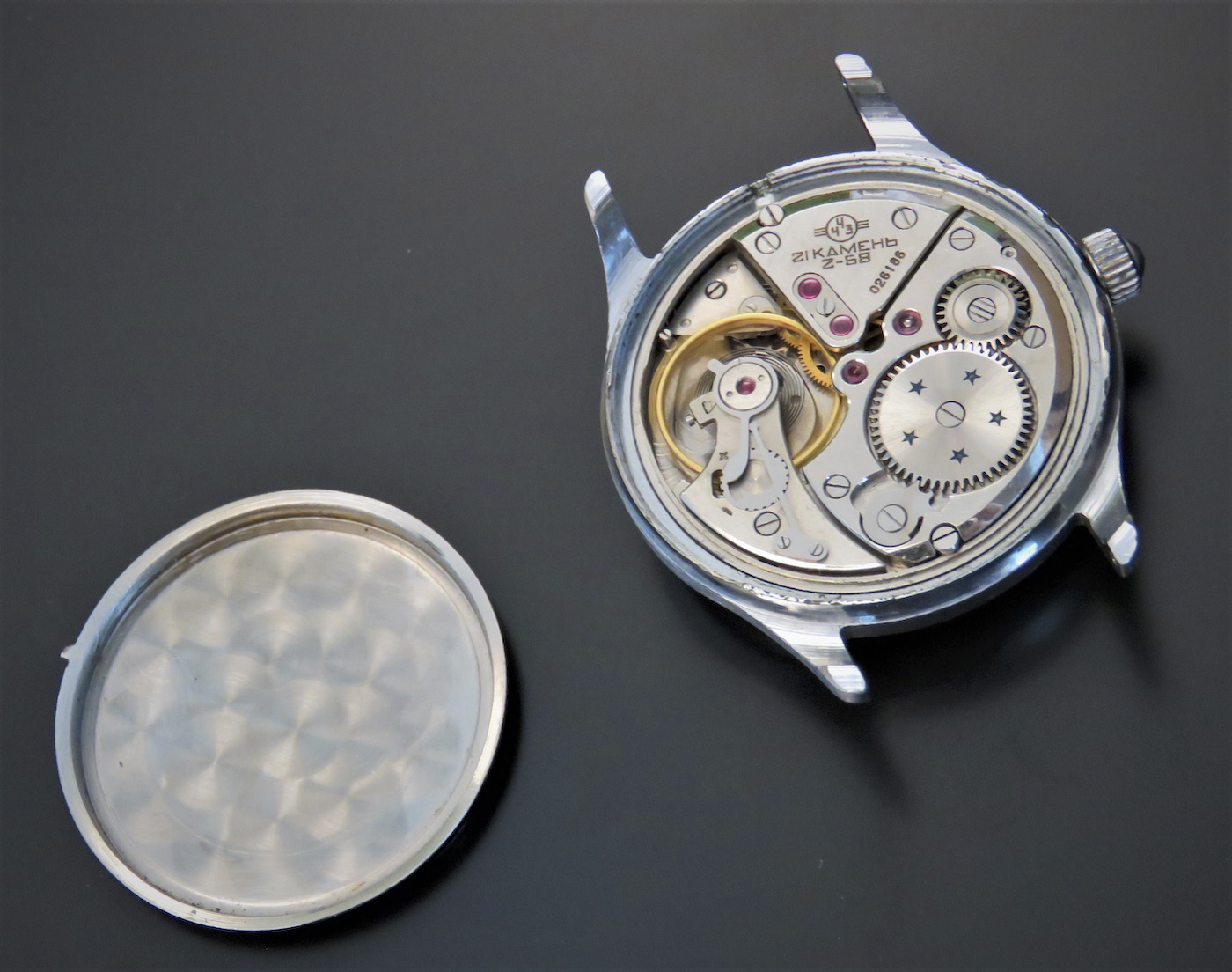
Vostok 2802 movement that features a micro regulator and, in contrast to caliber 2809, does not have balance shock protection.
The first movements (2802 and 2809) rolled off the line at the Chistopol factory (ChChZ, now known as Vostok) in 1956, though the lifespan of the 2802 was quite short (good luck finding one, these are the grails of Soviet watch collecting). The short lifespan of the 2802 likely resulted because by this point the 2802 was outdated, lacked shock resistance, and still contained a subsidiary dial. Switching over to the 2809 (which was based on the 2802 and required few modifications to production), with its added shock resistance and central seconds hand (helpful if you want to know exact seconds) was simply a matter of time. Regardless, the 2809 became a major success and was produced until 1970 with three dial names: Vostok, Volna, and Almaz. Each of these watches clocks in around 34-35mm in diameter with 16mm lugs in the first generation watches and 18mm lugs for later generations. Because of the high precision of these watches, many were utilized in industrial applications and even sat on vehicle dashboards in special holders rather than solely on wrists. Between the three primary types (details below) and the many dial variations, there’s plenty to discovery in the Precision watch family. Decent condition versions start around $100 USD with prices increasing for rare, new old stock, or early versions.
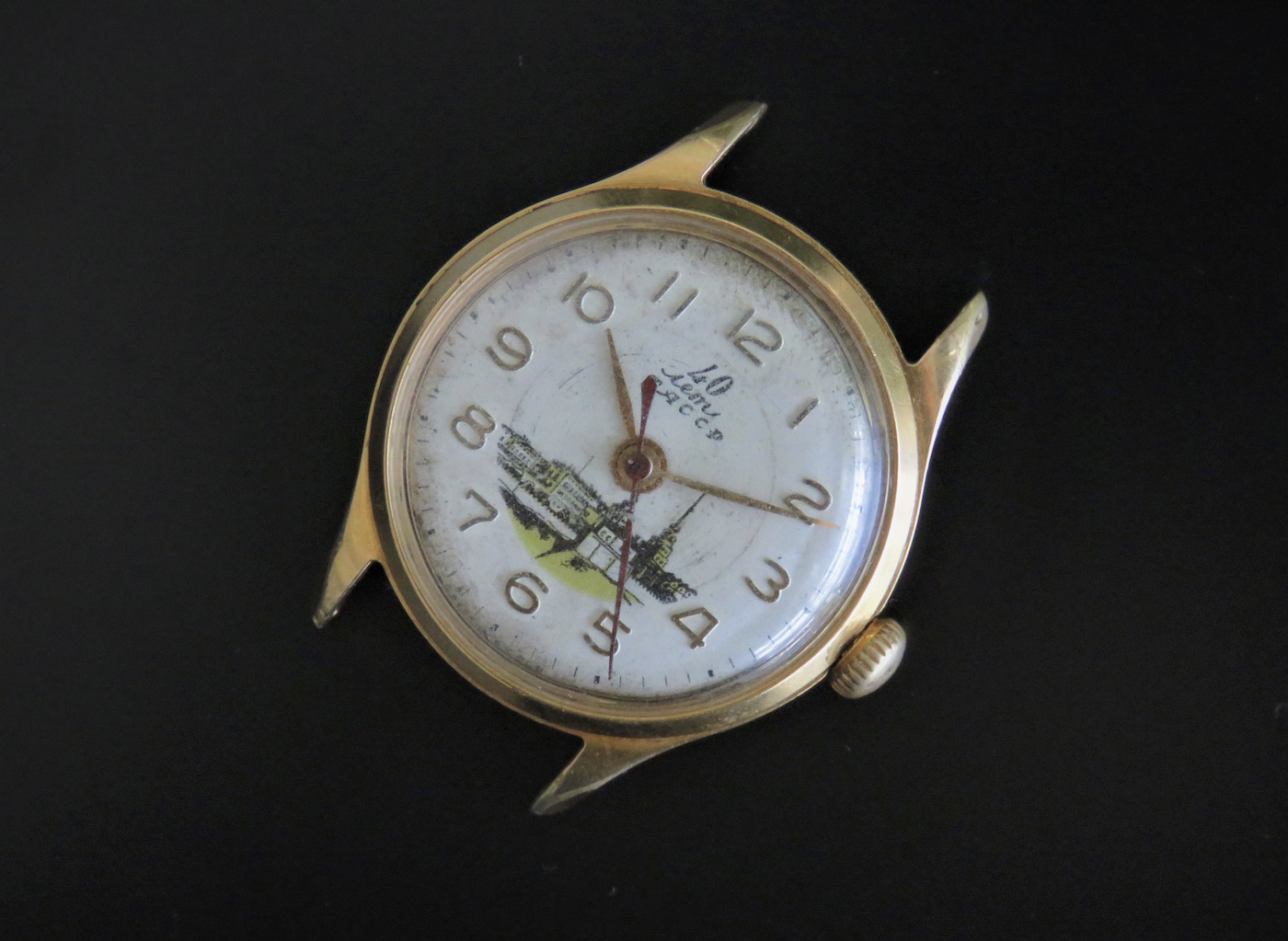
Special issue Volna watch made for celebrating 40 years of the Tatarstan Republic. There is a picture of the Kremlin in Kazan on the dial.
Vostok Precision – These are the most accurate and well-tuned of the bunch; though it never received chronometer trial certification, official specs listed them as running between -10 to +5 seconds/day. These watches had swan neck regulators, 22 jewels, and a central seconds hand. The Soviet testing system differed from COSC certification, but all watches went through a series of tests with timing tracked for ten days, in four positions, and three temperatures (0ºC, 20ºC, 40ºC).
Volna – Similar in most respects to the Precision, but less finely tuned (+/- 30 seconds/day), you’ll find slight differences in the movement (different font on the movement inscription, different recess holes for the train jewels) to distinguish the two. The Volna also had 22 jewels and a swan neck regulator, but the Volna was produced in much greater quantities and in different styles – keep an eye out for the Jubileinie versions, which were created for the 40-year Jubilees of the Tatarstan and Kazakhstan Republics.
Almaz – This is the low-end version of the Precision, containing only 18 jewels and no micro regulation.
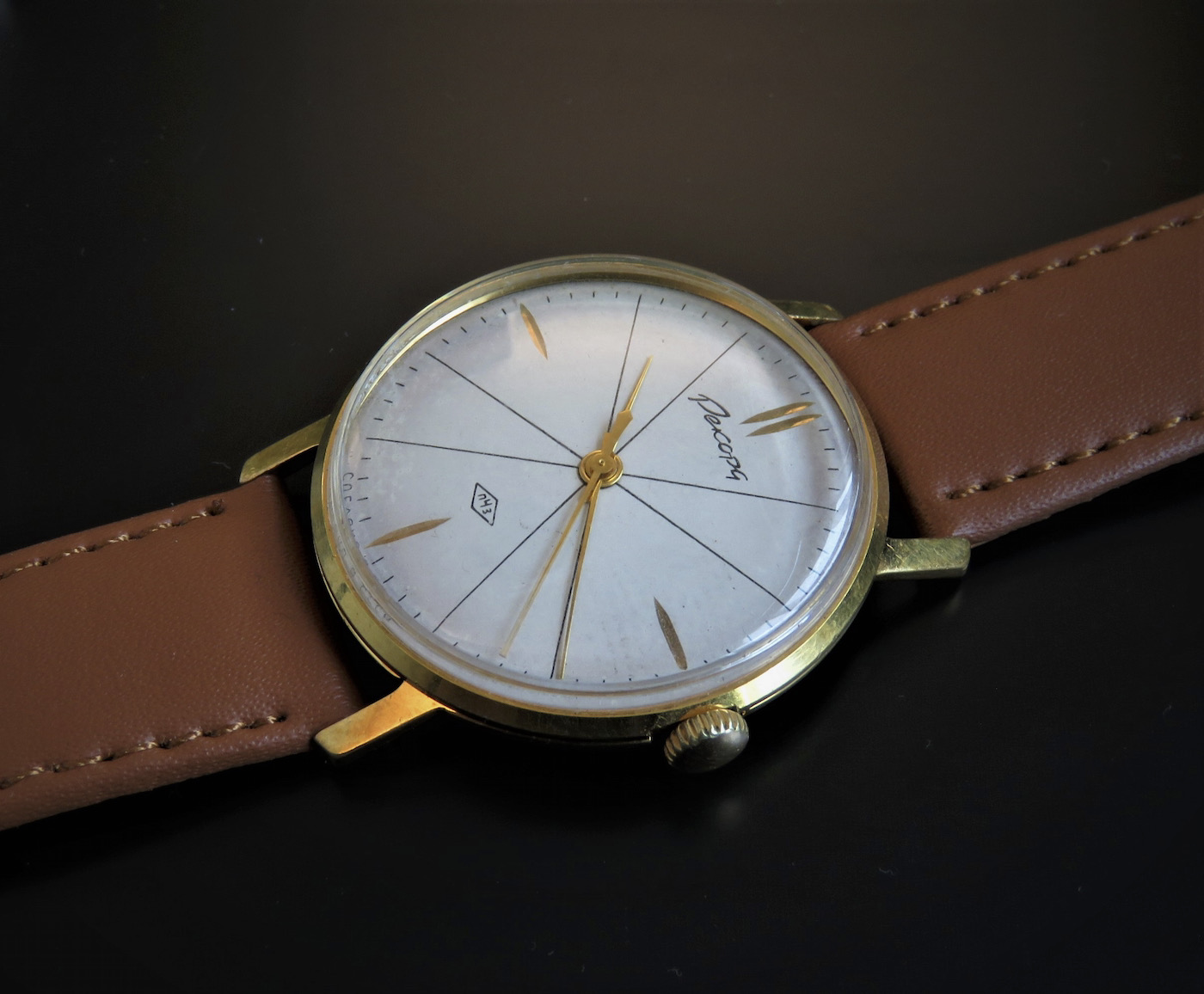
Slim Watches (Vimpel 2209 and Ultra-thin 2200)
By the late 1950s and throughout the much of the 1960s, Soviet watchmaking was at its apogee. Gone were the days of outsourcing (or downright copying) movement plans – the Soviets were now producing truly in-house calibers from initial planning, to movement design, to final production. All was done in the Soviet Union. Despite the factories all being state run and centralized, there was still plenty of competition and bragging rights on the line for producing the best watches possible.
Up until this point, most Soviet watches were utilitarian in nature: military watches, chronographs, and precise chronometers for industrial applications. The missing piece was a compact caliber for slim, elegant watches that could go head-to-head with the Swiss. Three factories (ChChZ, PChZ, and 1MChZ) set to work and, in short order, produced the 2209 movement (22mm in diameter, with the “09” indicating shock protection, central seconds, and manual winding). Though the specifications were the same, each factory’s solution to producing this slim caliber was entirely different.
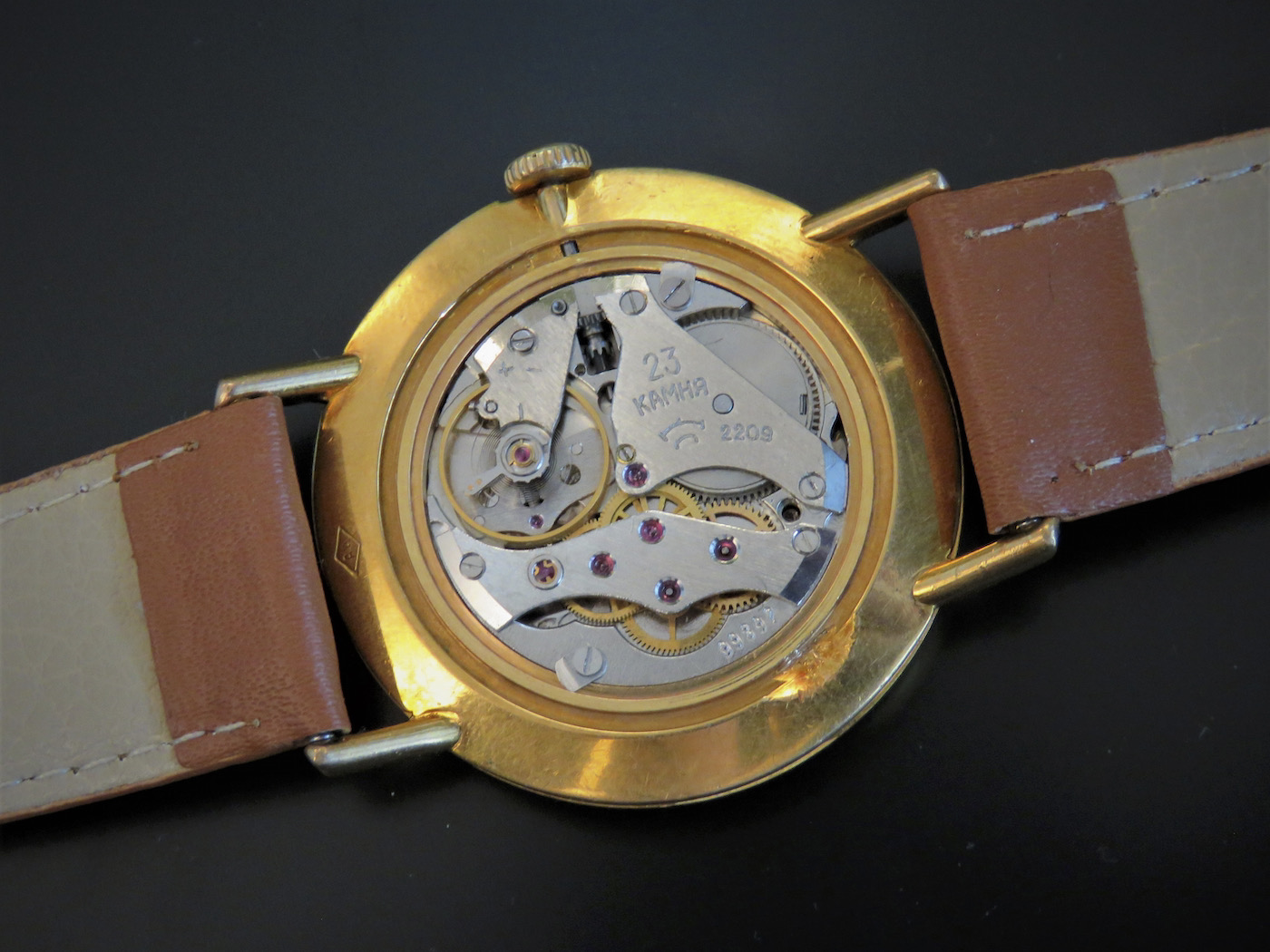
2209 movement from the Raketa “Rekord.”
ChChZ (Vostok) 2209: The Vostok factory took the approach of improving upon the precision caliber 2809, or Almaz caliber. Nicknamed Mir (“Peace” or “World”– though this simple translation doesn’t do justice to a word that resonates with history and meaning), this movement, launched in 1960, kept the basic architecture of the 2809 caliber but slimmed it down by 60%. The movement, which included 18 jewels and a 3.3mm height, was hugely successful and eventually went on to power the famed Amphibia line of Soviet dive watches.
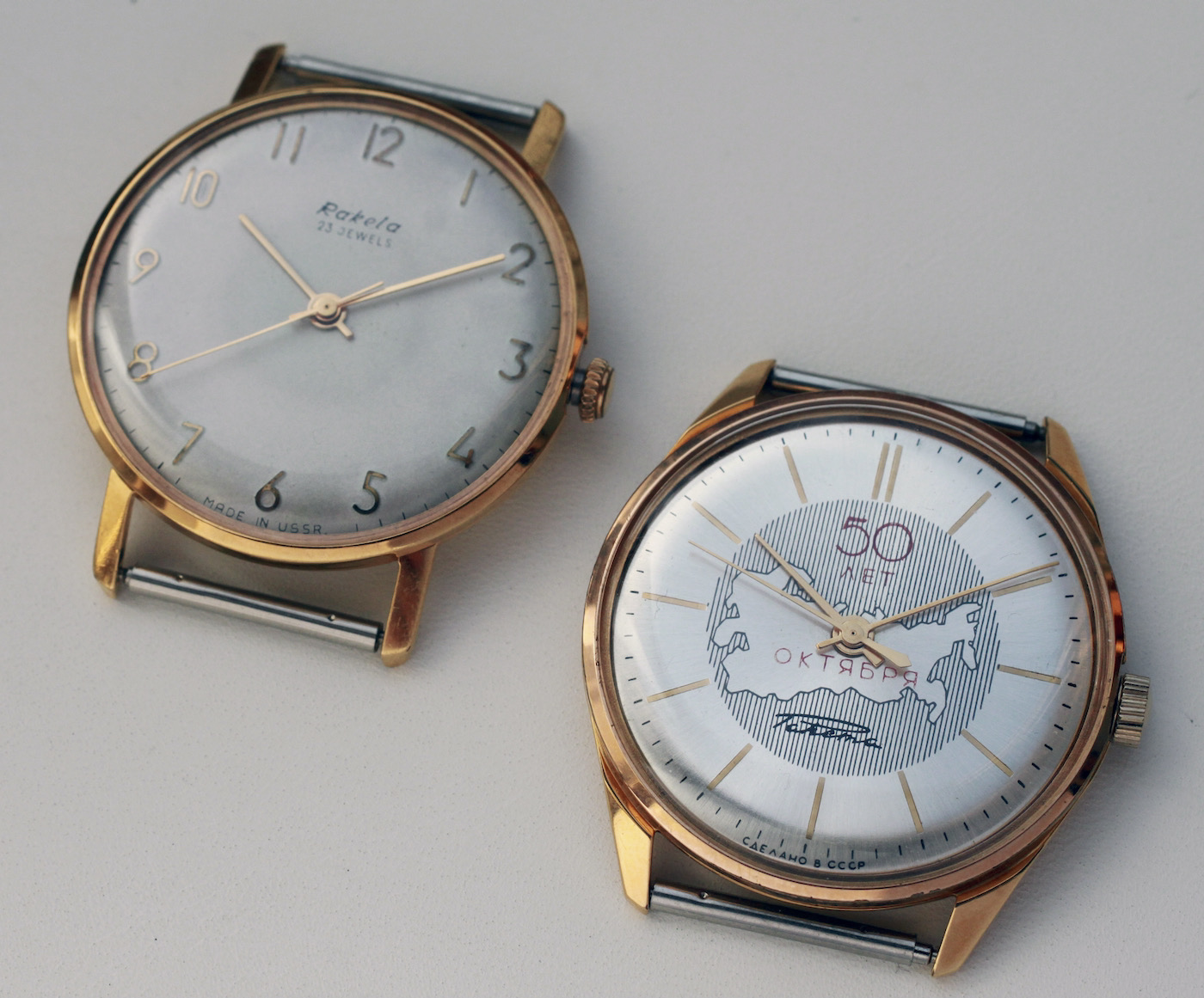
Two Raketa 2209 slim watches; the watch on the right was made for the 50th anniversary of the October Revolution.
PChZ (Raketa): The Raketa factory took a radically different approach than the other two, creating what may be one of the most unusual movements in the history of watchmaking. The entire winding mechanism is located on the dial side over top of the stem mechanism, with train wheels off center so as to allow the mainspring barrel to sit next to the balance wheel – both of which are quite large for the diameter of the movement. Originally released in the early 1960s under the Rekord brand (these watches are unicorns, almost impossible to find today), this caliber later powered other Raketa watches. As interesting as this slim, 2.7mm high movement was with its 23 jewels, it sadly was not as reliable as the slim calibers from the other factories and was not nearly as successful.
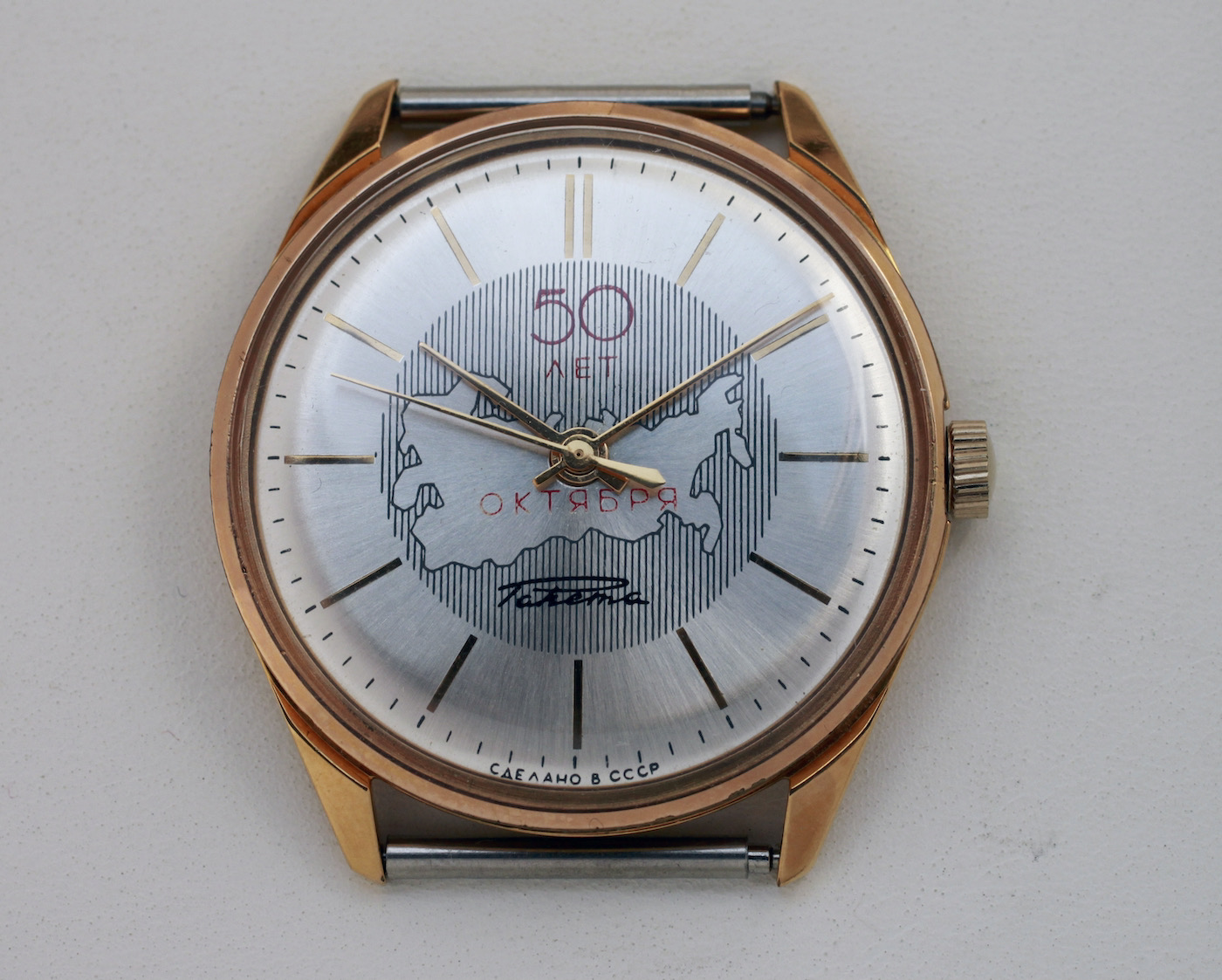
Raketa slim watch with 2209 movement and October Revolution commemorative dial.
1MChZ (Poljot): First produced in 1961 and branded the Vimpel (“Pennant”, after the small flags given to factories to celebrate an achievement), Poljot’s caliber featured a four-wheel winding mechanism (rather than the standard two belonging to the crown and ratchet wheel). This layout, which had never been seen before, won first prize at the 1963 Leipzig Trade Fair and powered numerous Pojot dress watches. The Minsk Luch factory later took up production of this 2.9mm high, 23 jewel movement and kept producing the caliber until the 1980s.
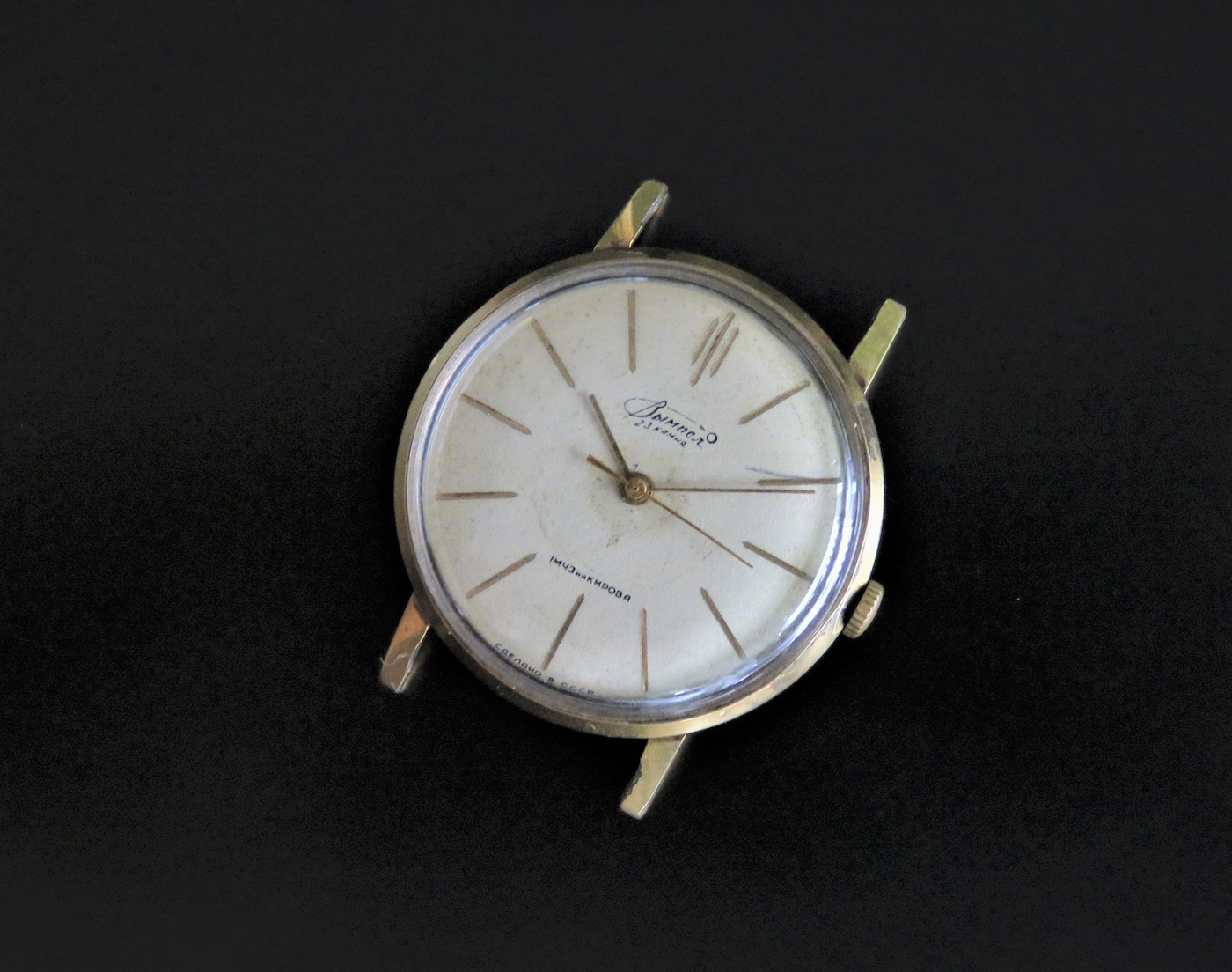
Typical example of a Vimpel 1MChZ watch – a slim and elegant watch, which can easily be worn as a dress watch today.
If you’re interested in vintage dress watches, the 2209 watches are the way to go. This was the height of Soviet watchmaking and the quality of the 2209 watches easily rivalled the Swiss. You’ll find these watches branded under the Vimpel name, but also Orbita, Poljot De Luxe, Poljot, and even Sekonda and Cornavin. Most will be gold plated, but they were also produced in steel, with most case sizes around 33-35mm in diameter with 18mm lugs. You can easily pick up a nice example Vimpel for around $100 – or about half that for a similar Luch version.
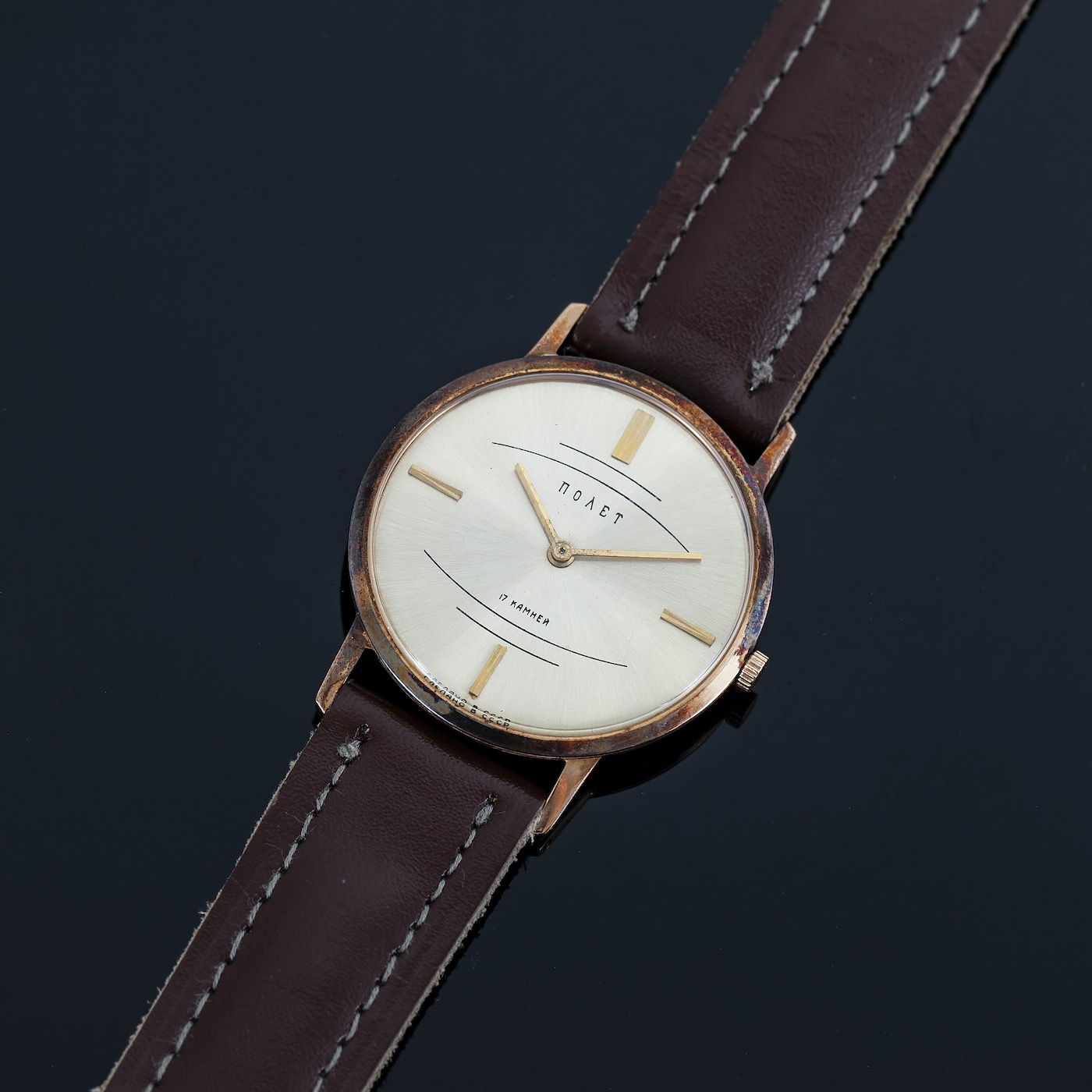
The famous Poljot 2200 – if you ask a Soviet watch collector to name one ”grail” watch, this will be the first watch they name. With less than 3 mm thickness, this watch is amazingly slim even by today’s standards.
Now, we can’t talk about the 2209 without bringing up the 2200. Given the success of the 2209 watches, the watchmakers at 1MChZ were feeling at the top of their game and decided to produce a high-end watch that, for the first time, was never intended as a tool for the common folk. This watch was to be the height of prestige and luxury and as slim as it was humanly possible to make. The watchmakers stuck with a 22mm diameter, but slimmed the movement down to an incredible (even by today’s standards) 1.85mm height. Every watch was housed in a full 14k gold case that measured in at 33mm in diameter with 18mm lugs. Because this was a time only watch (no shock protection and not even a seconds hand), it received the “00” designation.
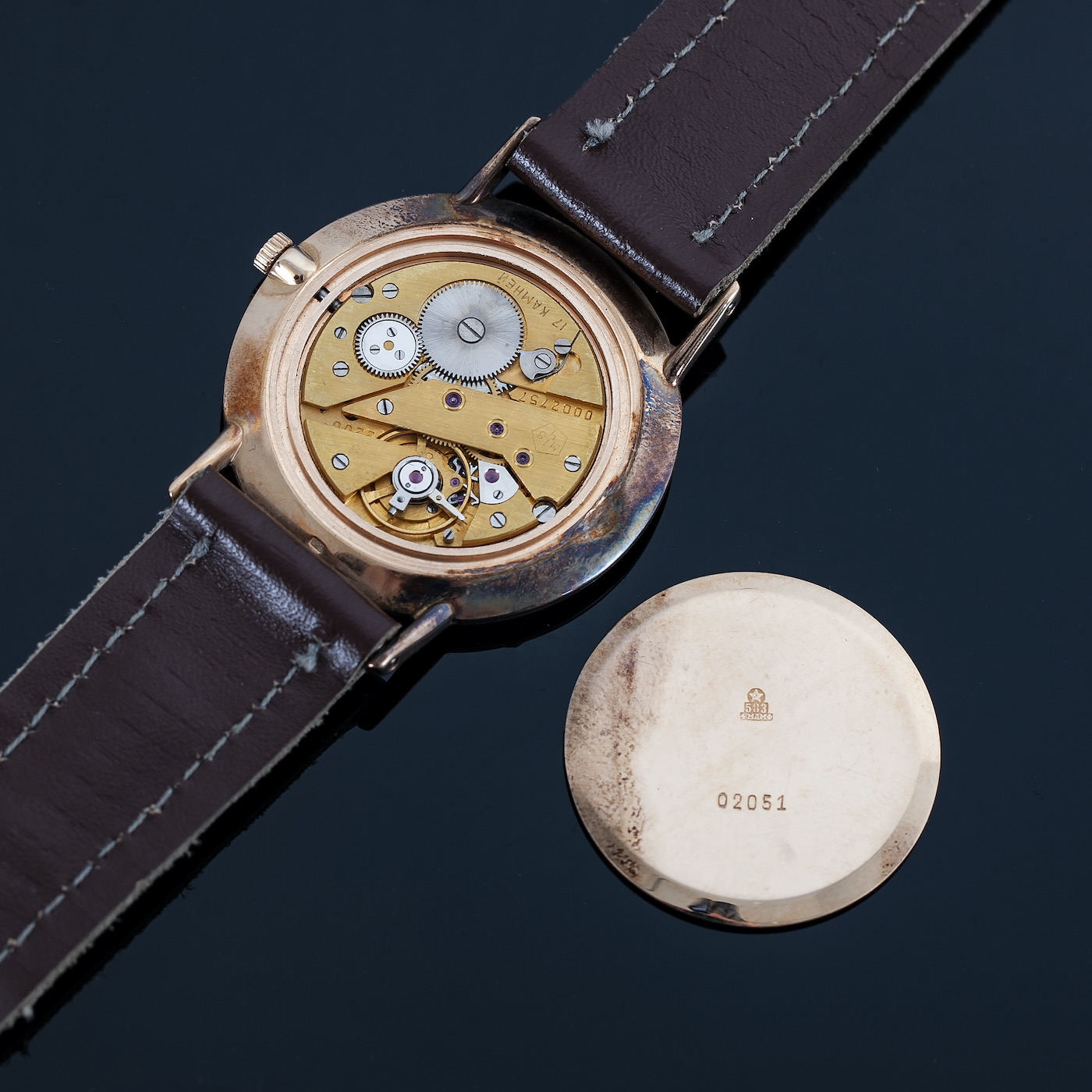
2200 movement, which was inspired by the VC 1003 calibre. The movement is only 1.85 mm thick and is quite fragile. The movement has no shock protection and no seconds hand.
Now, how did the watchmakers at 1MChZ come up with this movement? Well, seeing as he’s fully serviced both movements, Blaz can tell you that it’s no coincidence that the 2200 caliber bears striking similarities to the Vacheron 1003 caliber. In any case, the production life of the 2200 was short lived, starting in 1965 but only lasting two years. The problem with such a slim watch was their extreme sensitivity – you can literally bend the watch with your fingers. Plus, they were a bear to repair. The number of watches produced is debatable (probably only a couple thousand or so), but there are likely only a few hundred at most left in the world. In Soviet watch collecting circles, this is the Holy Grail. They do come up occasionally and if you happen to be in the right place at the right time, you’re still looking at a hefty $6-10k price tag. That said, not bad when you compare it to trying to purchase a vintage Rolex Daytona Paul Newman.
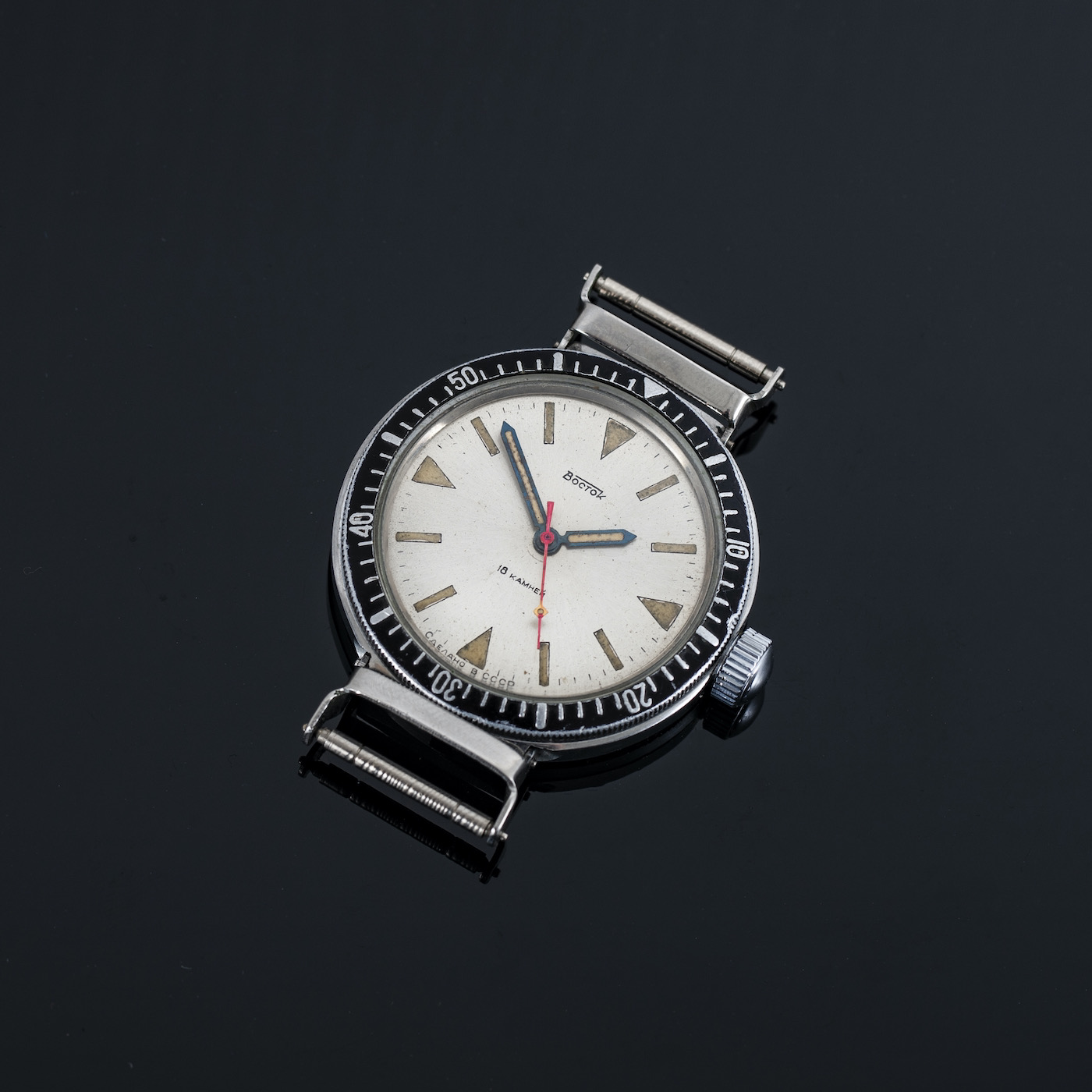
Amphibias
No list of Soviet watches would be complete without including Amphibias. While the term today refers to many different watches from the Soviet (and later Russian) brands and come in a mind-boggling array of styles, these dive watches tend to conform to a few key characteristics: 200m of water resistance, compressor case, screw down crown, rotating bezel, lume (at least for the hands), and a stainless-steel case.
The first of the Amphibias mass-produced by the Chistopol (Vostok) factory were released in 1967, though other factories later created their own versions of the Amphibia. That said, there are some examples that suggest there was an early Amphibia made before 1967 in a very small run; however, we’ve been unable to find supporting documentation. For purists, the Vostok Amphibias are the “true” Amphibias. The first watches produced at Chistopol contained the manual wind 2209 (Mir) caliber found in the precision watches. By the late seventies, the 2209 was swapped out for the manual wind Vostok 2409 caliber – a caliber that’s only seen a few minor changes over the decades and is still in production today. Interestingly, this movement was first designed by the Petrodvorets (Raketa) factory, which later handed production over to Chistopol.
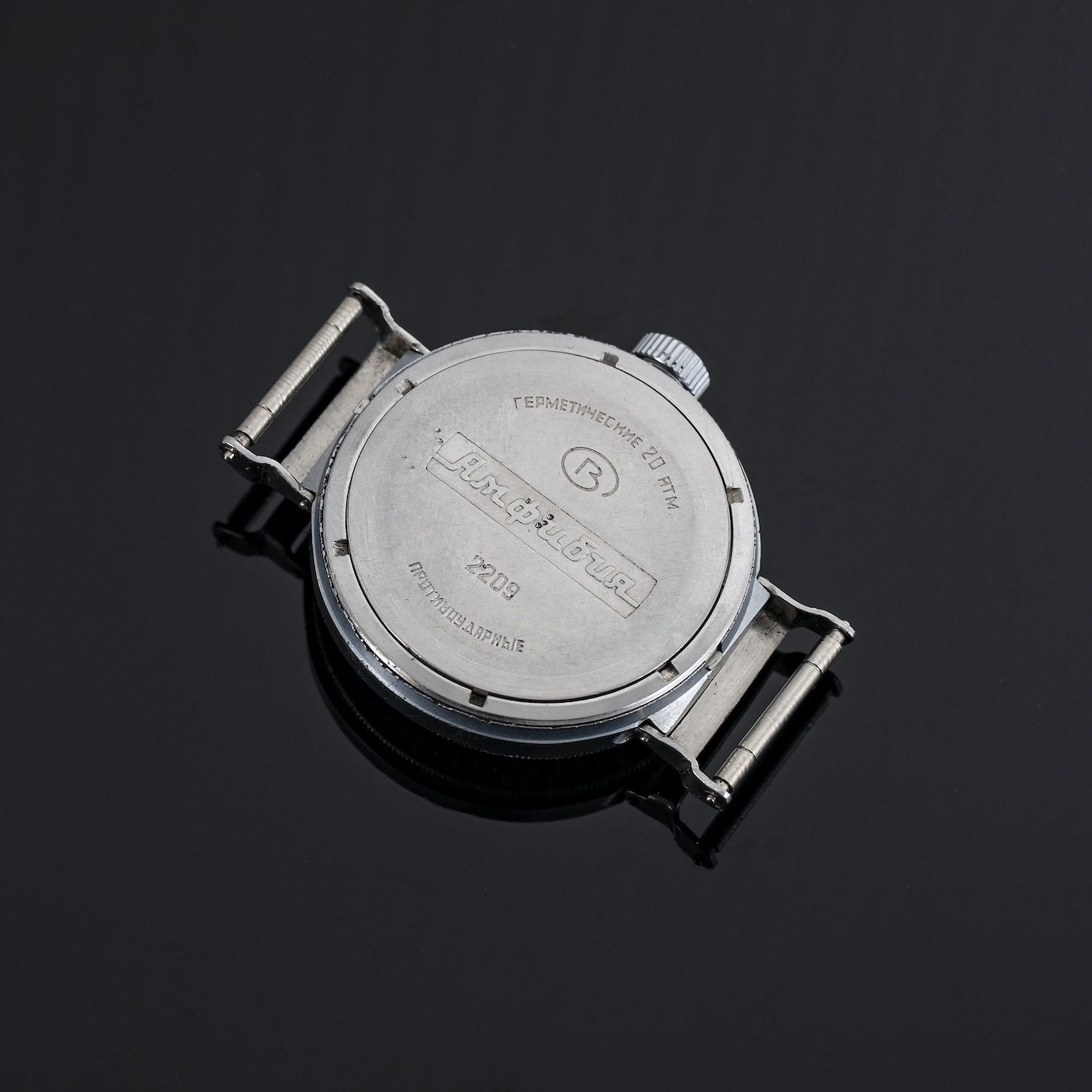
Back side of the first issue Amphibia. The style of these engravings are unique to this watch; be sure to check the engravings to avoid frankenwatches.
Technically, the 2409 was a step backward compared to the 2209 – it’s larger, but more importantly, has an indirectly driven second hand (rather than direct drive). If this sounds like a bad idea, it is. It’s a notoriously bad design that frequently results in rough movement and erratic behavior of the seconds hand. Unfortunately, the quality issues of Amphibias don’t end with the movements; the build quality of the entire watch suffered a marked decline over the years, despite the massive popularity and production numbers. In many ways, you can consider the story of the Amphibia as an allegory for the decline of the entire Soviet watch industry after the 1960s. Yet, despite all the objective quality issues, these watches remain almost absurdly robust. Watch stopped running? Squirt some engine oil in the movement, give it a good smack, and it’s back to new. Joking, joking, but the point remains that these watches just keep running despite the odds stacked against them.
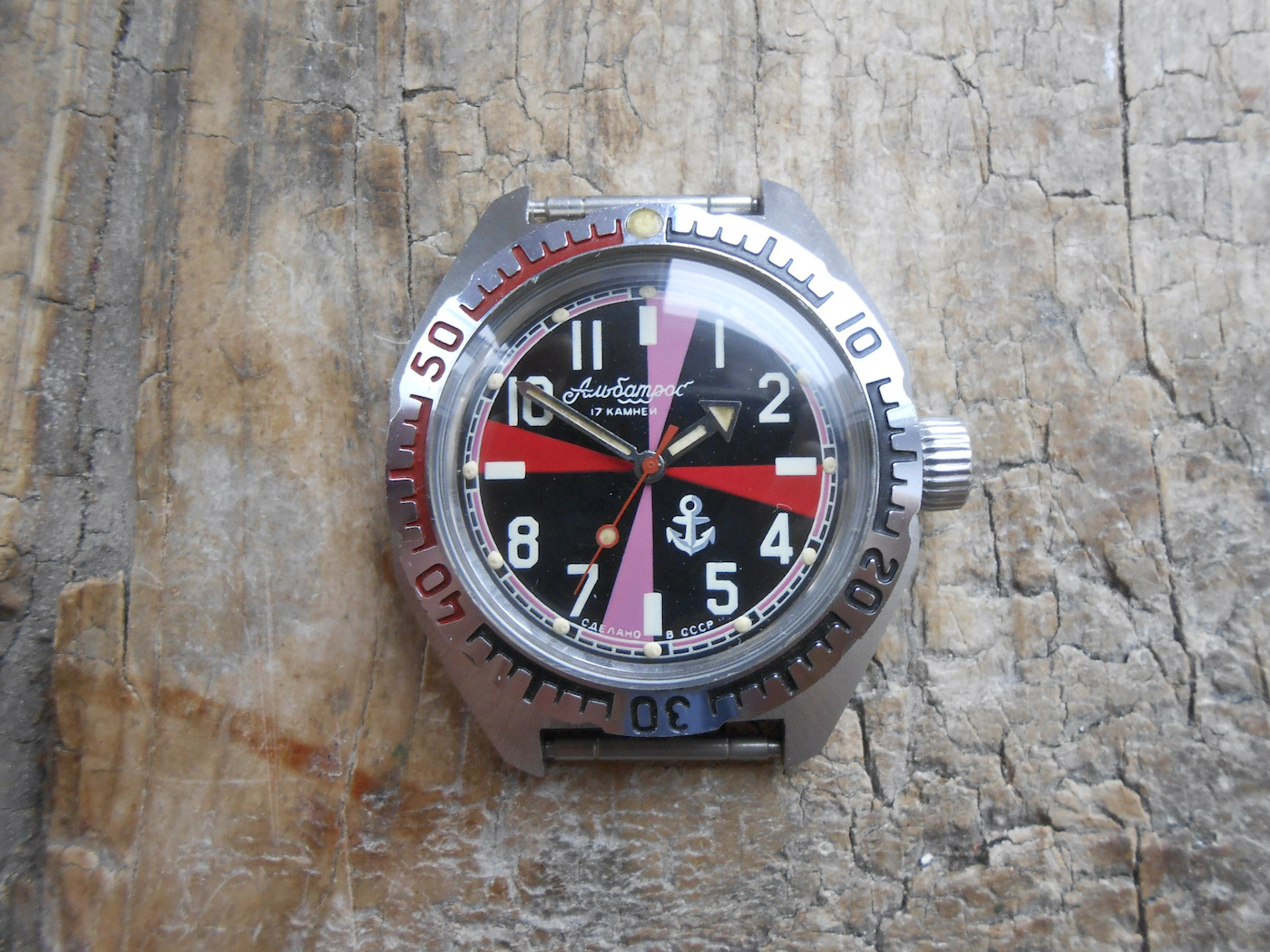
Amphibia Albatross with a “Radio Room” dial, named for the red dial indicators showing the periods at every hour when the non-distress naval radio frequency is banned.
Though the Soviets had already created the Type 1 Vodolaz professional watch for military divers, it was massive and not suitable for everyday use. The Soviets needed a smaller, water-resistant watch. At this point, the Swiss had already created various designs to attain high water resistance, but most required the type of production accuracy that the Soviets simply couldn’t produce at the time…not to mention the fact that most case designs were protected by patents. To solve the problem, the Soviets took their tried-and-true path of finding a simple and effective solution — one which would take the form of a compressor case. This was not a new idea, but it was straightforward, cost-effective, and avoided pesky patent issues. In a compressor case, the caseback and crystal are not fixed but can move in the direction of the rubber gasket. As you go deeper, the increase in pressure pushes the case parts together, increasing the strength of the seal.
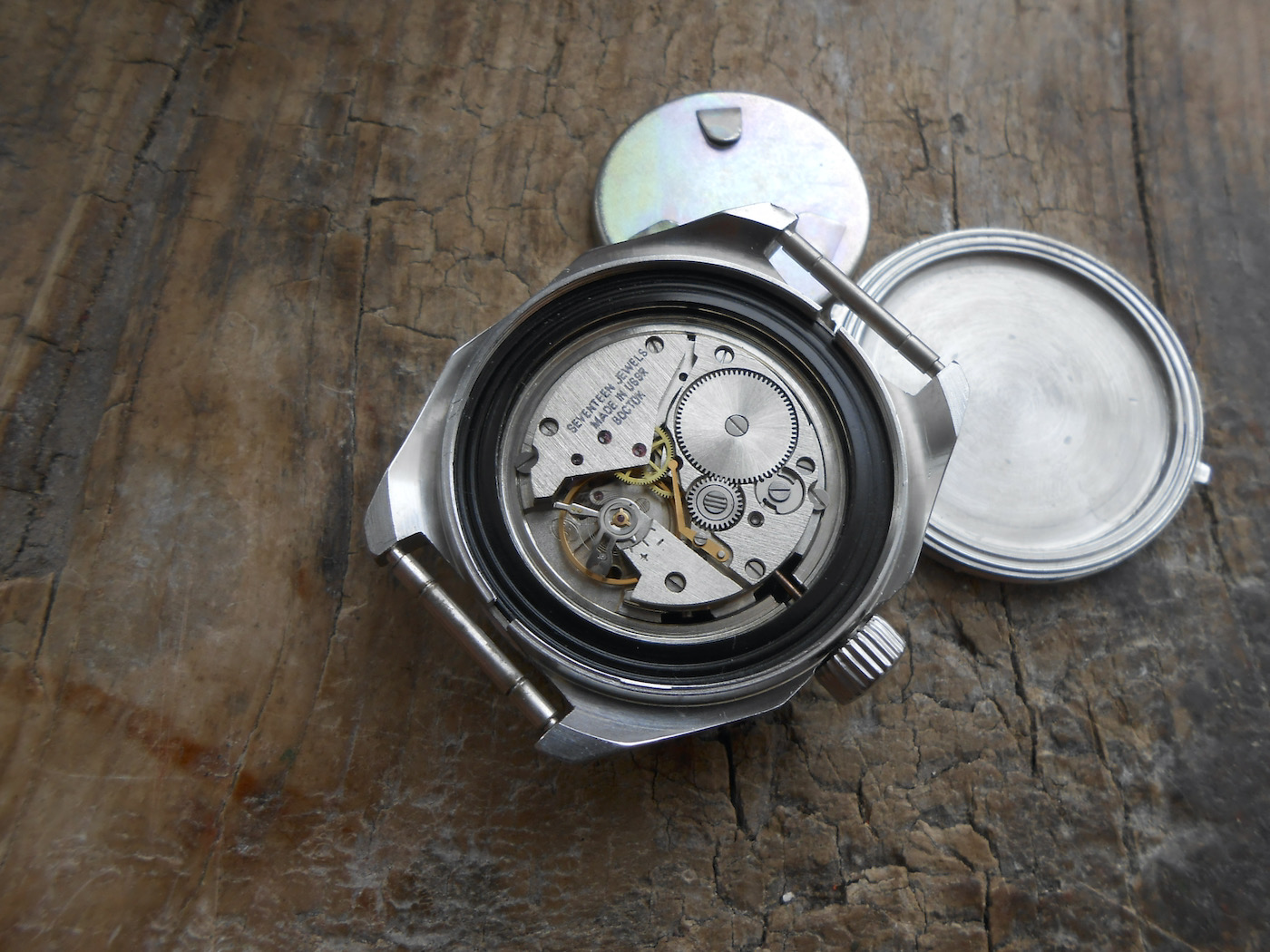
The Albatross is a later era of Amphibia with a newer Vostok 2409 movement.
One of the many quirks of the Amphibia watches is the screw down crown. If you’re used to high-precision Swiss or German screw-down crowns, you’re in for a surprise. The Amphibia crowns are wobbly and you’d be forgiven for thinking the crown is broken. Keep in mind, most Amphibias are hand-wind, so even though the crown will feel wobbly and, well, broken, they’ve stood up to decades of regular use. As the saying goes, if it’s stupid and it works, it’s not stupid.
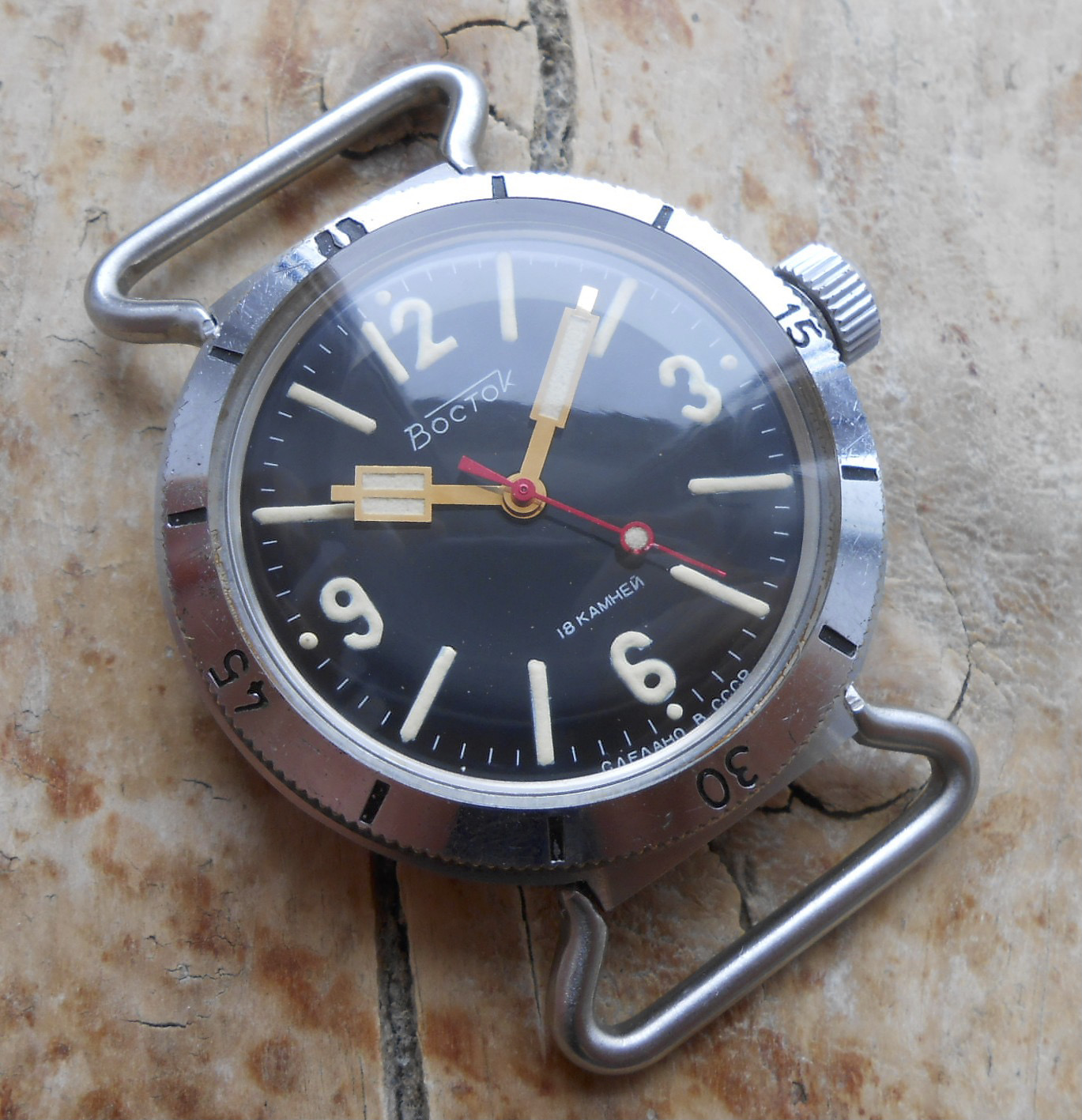
“Wire Lugs” version of 1st generation NVCh-30 Amphibia.
The Amphibias are dive watches and, as such, all are equipped with a rotating bezel. Typically, these are bidirectional friction bezels, a departure from typical unidirectional 60-click or 120-click bezels. The bezels are often painted with distinct markers, numerals, and designs. Swapping bezels is easily done, making these a go-to for the modding community, but also a danger for collectors looking for Amphibias in all-original condition. While the Vostok factory was certainly the first and most prolific of the factories producing Amphibias, other factories soon followed suit, Poljot chief among them. The Poljot Amphibias typically have plastic two-tone bezels and automatic movements, but they’re relatively rare and hard to find. You’ll also find Amphibias from Raketa (including a quartz version), Slava (nice to look at, terrible to maintain), Chaika (quite small by today’s standards), and Zaria (also small).
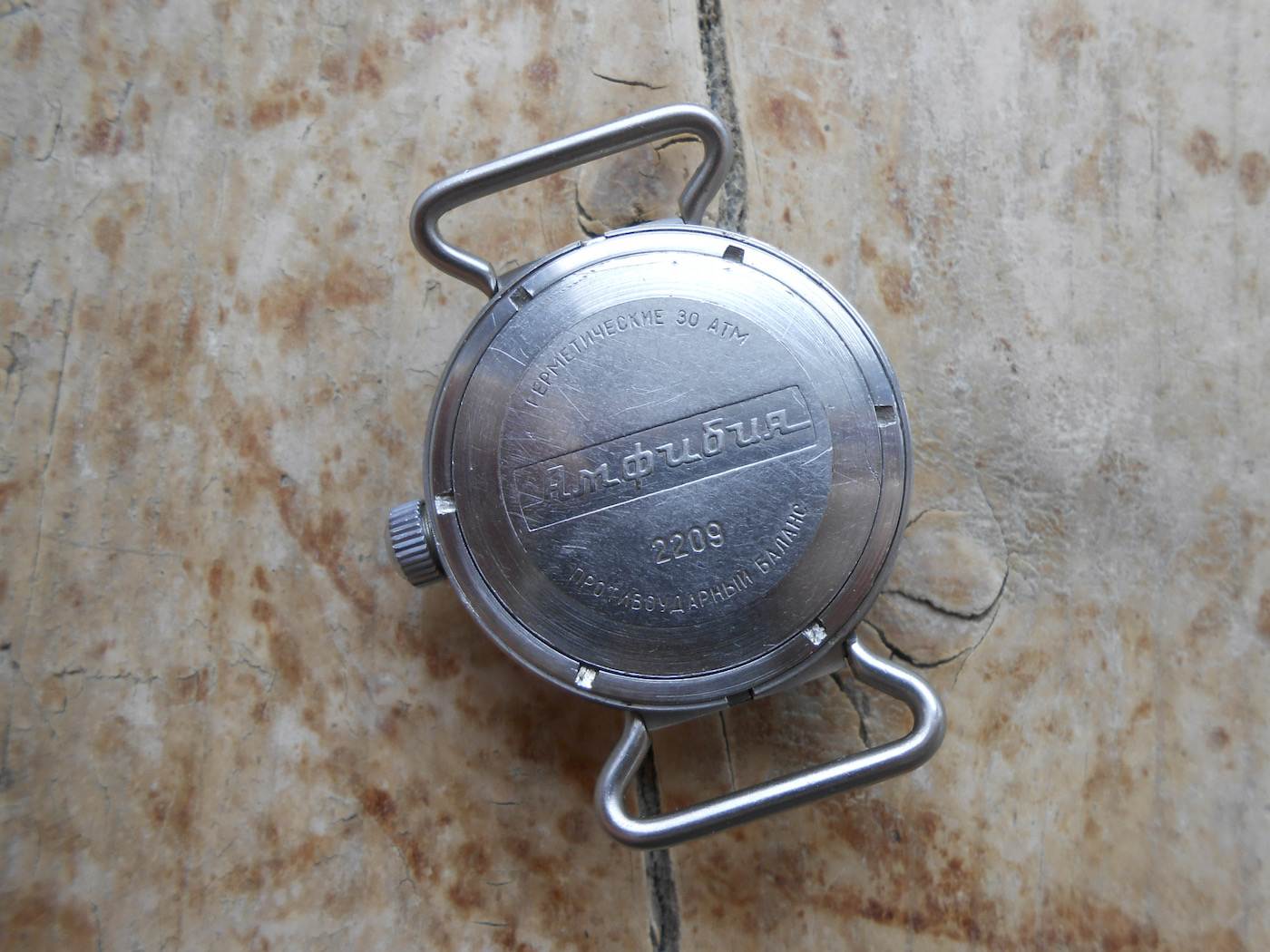
Case back of the “Wire Lugs” version of a 1st generation NVCh-30 Amphibia.
If you’re on the hunt for an Amphibia, early models out of the Chistopol factory will only feature Amphibia or Vostok branded dials and feature handwinding movements. In later years, you’ll find plenty of sub-branded dials like Komandirskie, Generalskie, Admiralskie, Ministerskie, Albatross, and Neptune, some of which will also feature a 2409 movement with manual winding. For an affordable, fun, and historically interesting option, take a look at the Albatross “Radio Room” – a distinctive black, red, and pink dial that demarcates four 3-minute periods in order to replicate ship radio room clocks used for monitoring maritime distress calls.
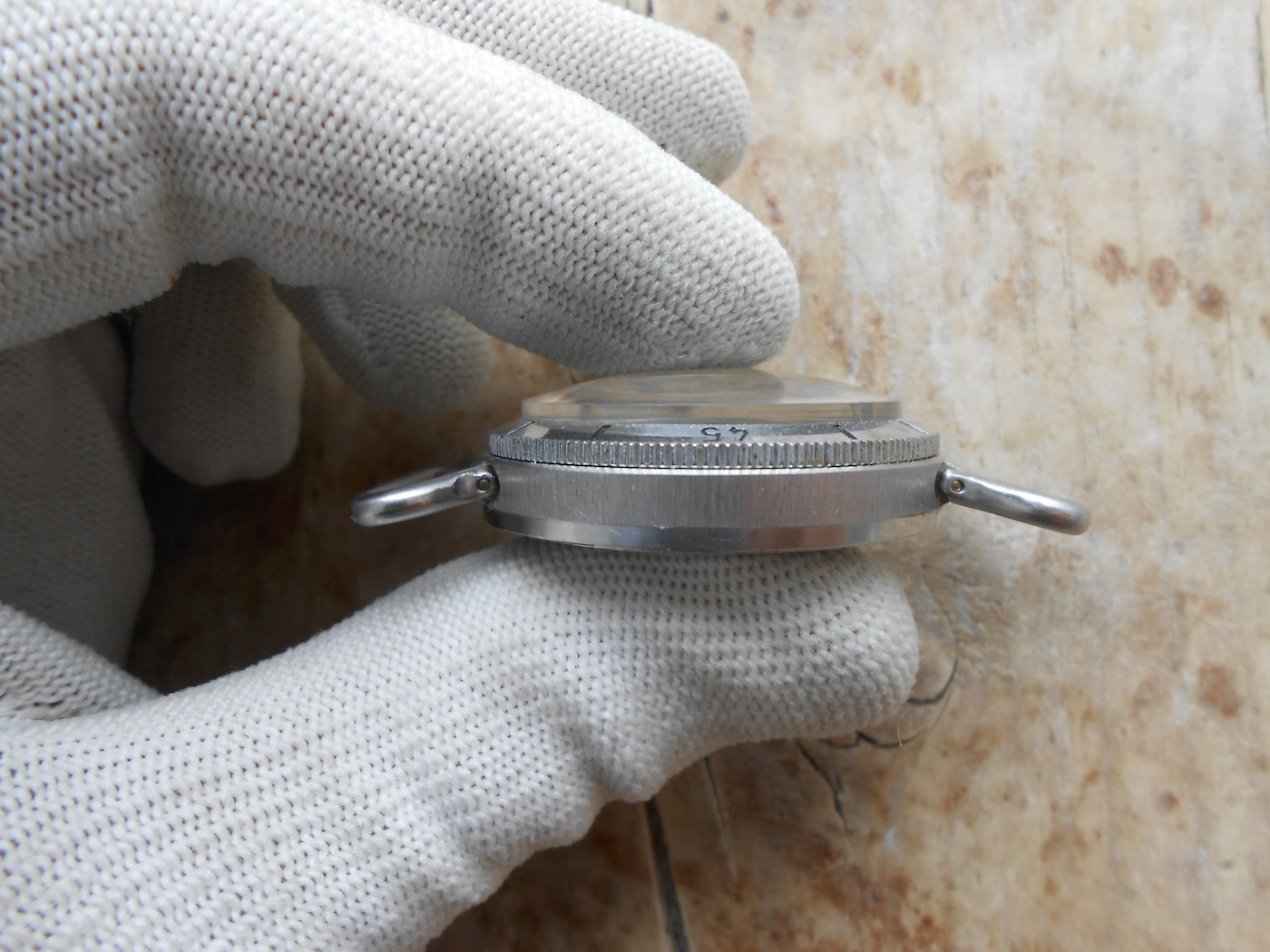
“Wire Lug” Amphibia seen from the side.
There are plenty of Amphibias to pique the interest of just about any collector. Simply search around on eBay and you can find a decent-condition piece for $50. However, we suggest exercising caution, especially if you’re after a rarer model, as there are plenty of fake and franken watches in the mix. A word of advice: if the watch has anything more than letters, numbers, and lines on the dial (say, images of tanks, submarines, stars, logos, faces, etc.) – stay away! The exception to the rule, however, is the Scuba Dude dial. If you’re looking for something truly special and you’re more interested in military history, take a look at the NVCh-30 watches – these were the first generation of military Amphibias, first produced in the late 1960s, with production continuing until the fall of the Berlin wall. Superficially, these don’t look much different from a standard Amphibia, but the thicker caseback and crystal allowed them to gain 300m of water resistance. Those will set you back at least $1000.
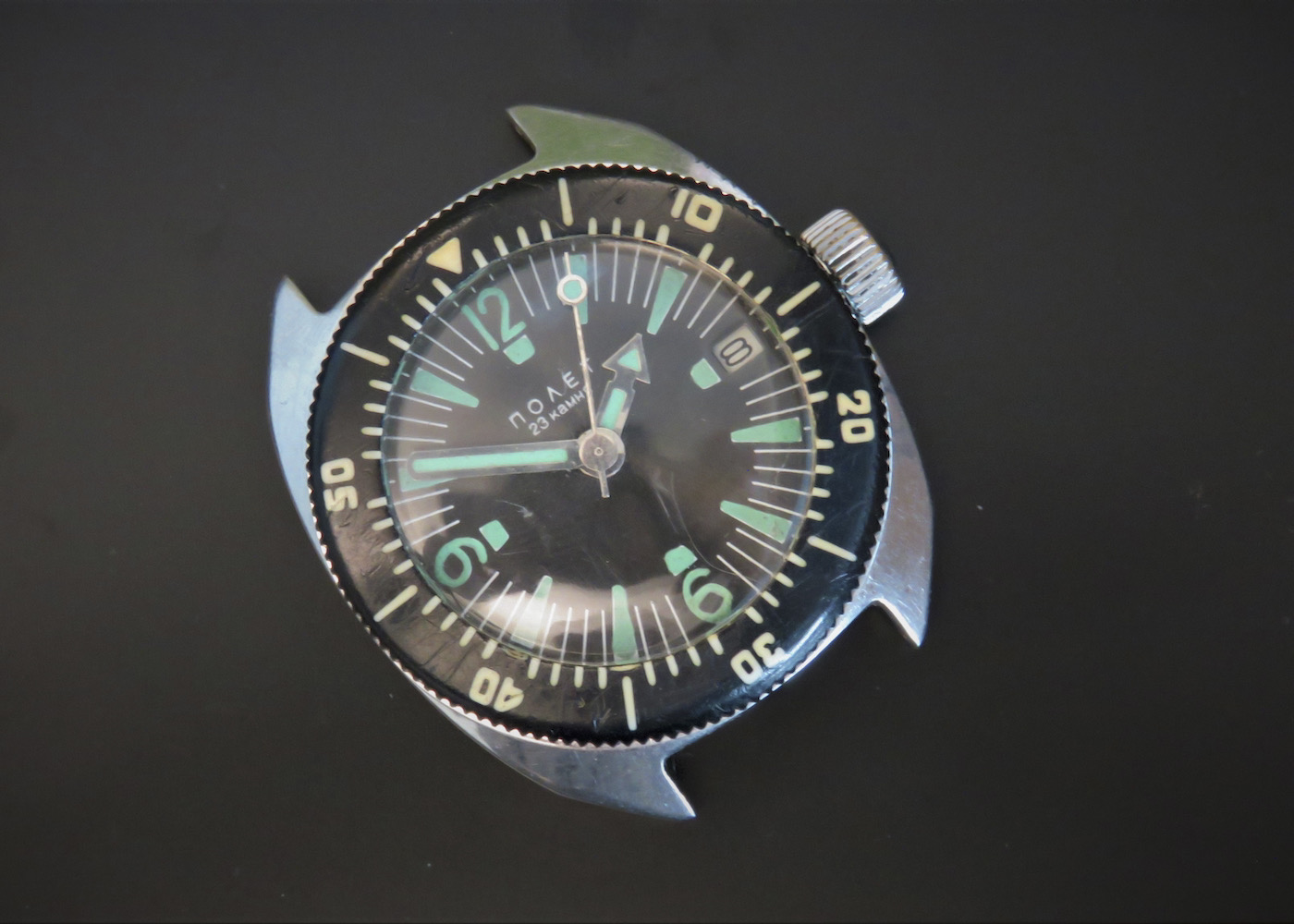
Typical 1970s Poljot Amphibia with an automatic Poljot movement inside. A nice balance of price, performance, and rarity for a new collector.
Finally, if you like the Amphibias, but don’t want to deal with the minefield of fakes and frankens on the vintage market, keep in mind that Vostok continues to produce many different versions of the Amphibia for around $100. You don’t have to go vintage to enjoy the history of Soviet watchmaking.
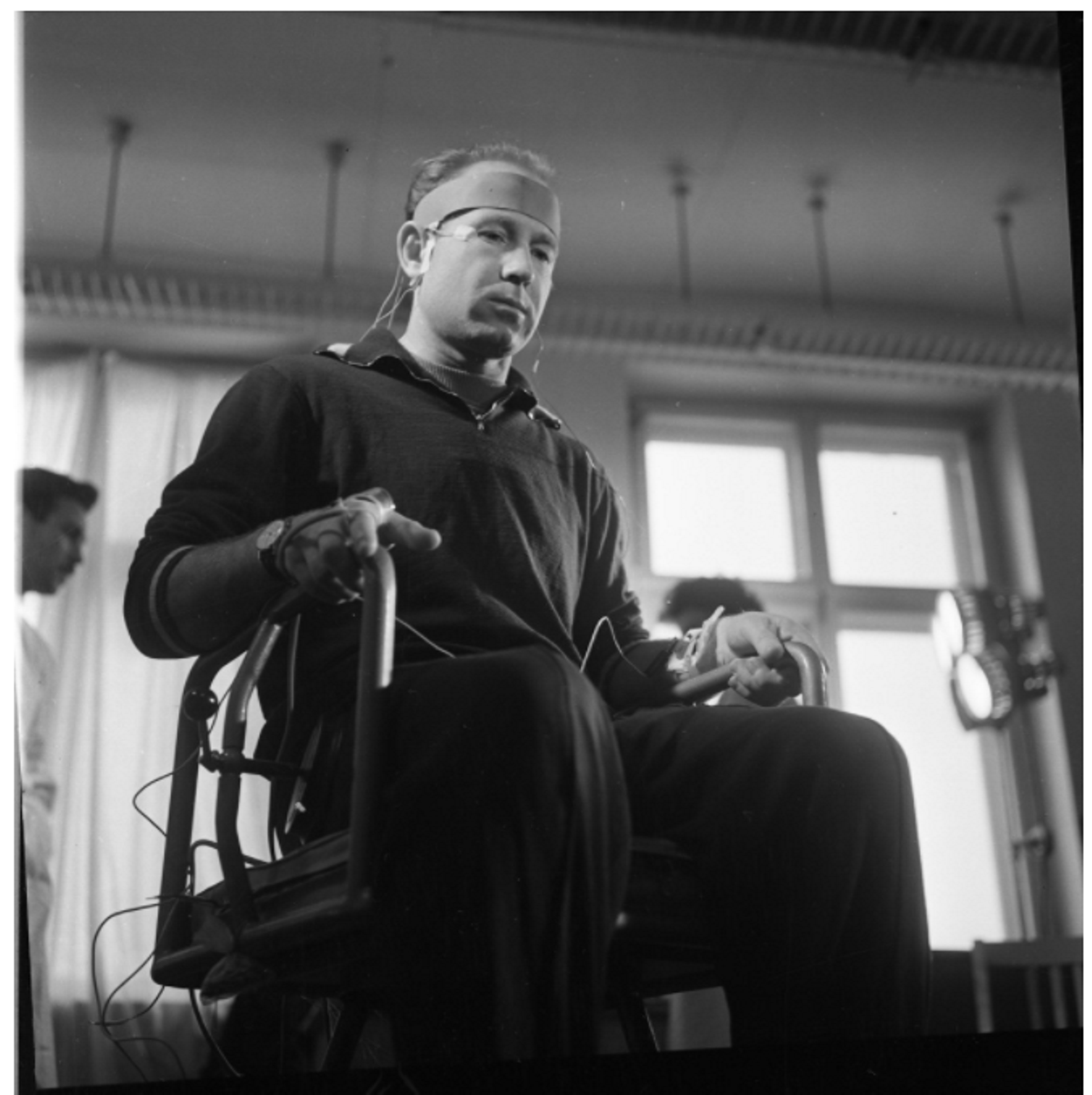
Strela Chronograph
If there’s one watch that stands out from all the rest on the list, it’s undoubtedly the Strela chronograph. Sure, the Shturmanskie is often described as a Soviet space watch due to its association with Cosmonaut Yuri Gagarin, but the Strela chronograph was the true space watch, built explicitly for Cosmonauts in the Soviet Space Programme as well as members of several branches of the military. Launched in 1959 and equipped with the new caliber 3017, the Strela chronograph was born at the height of Soviet watchmaking and displays a maturity of design and craftsmanship that truly sets it apart.
The stories behind the watches are one of the most captivating parts of vintage watch collecting and, frankly, it’s hard to find a more romantic story that captures our collective imagination more than space exploration. It’s this indelible link to history that created the monolithic success of the Omega Speedmaster Professional (or the Moonwatch). But, in Soviet watch collecting circles, it’s the Strela chronograph that is seen as the true space watch. In 1965, Soviet cosmonaut Alexey Leonov became the first person to brave the vast emptiness of space on a spacewalk outside Voskhod 2 that lasted over 12 minutes. On his wrist — a Strela chronograph equipped with the calibre 3017 movement…probably. There is some debate and speculation that Leonov may have worn an early Omega Speedmaster Professional, but documentation from the mission reveals that Leonov and fellow cosmonauts were issued Strela watches for the Voskhod 2 mission, making it much more likely that Leonov was indeed wearing the Strela underneath his suit on mankind’s first spacewalk. And Leonov certainly wasn’t the only famous cosmonaut to wear a Strela—others, such as Vladimir Komarov (the first man to travel to outer space more than once) proudly wore a Strela chronograph before his untimely death in 1967.
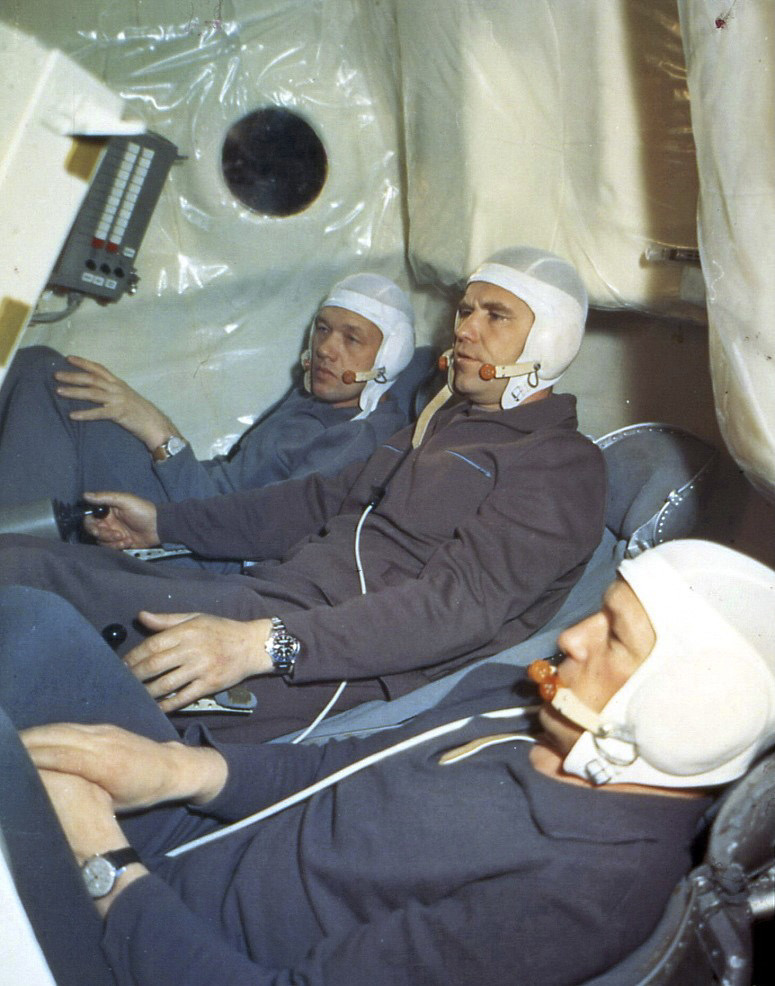
Cosmonauts Aleksei Yeliseyev, Vladimir Shatalov, and Nikolai Rukavishnikov onboard the Soyuz-10 spacecraft on April 22, 1971. Yeliseev and Rukavishnikov are wearing cal 3017 chronographs.
To get back to the origins of the Strela chronograph, we need to consider the period in which it was developed. By the late 1950s, the space race was in full swing; the Soviets were flexing their muscles in the realm of technological development, and a chronograph that could keep up with the demands of military aviation and space missions was sorely needed. The stakes were high and national pride was on the line. Cosmonauts and Soviet aviators needed a watch they could count on; one that could handle everything from flights in experimental aircraft to space walks in microgravity. In other words, it was time for a new watch and a new movement. It was time to welcome the caliber 3017.
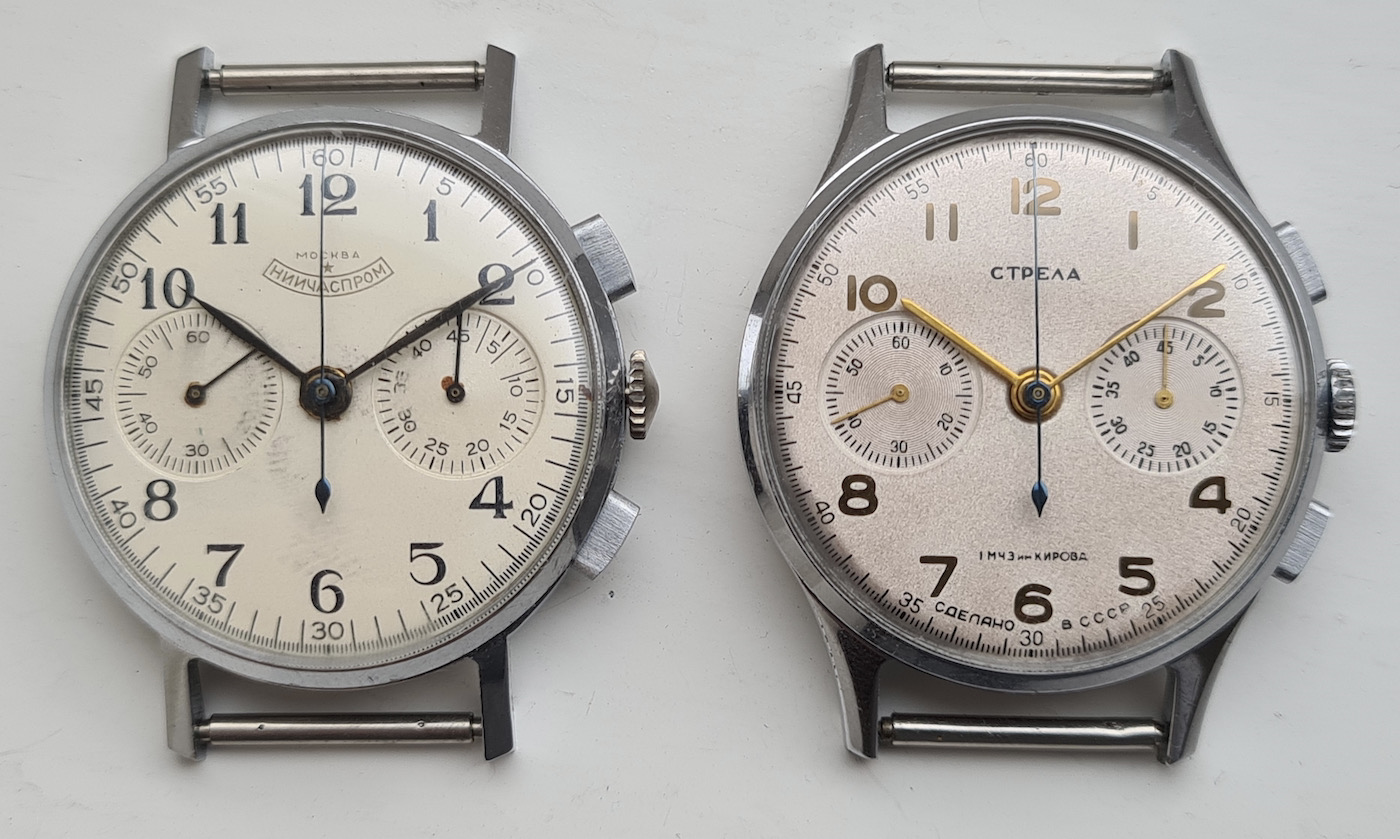
Left: a prototype 3017 watch made at the NII Chasprom. Right: the first official massively produced series were made in 1MChZ factory.
Keeping with the traditional 4-digit nomenclature for Soviet watches, the 3017 movement featured a 30mm diameter (the first two digits), while the 17 designated a manual wind chronograph movement with no date or shock protection. Whether the Soviets licensed the design or “borrowed” it, there’s no doubt that the 3017 was based on the Swiss caliber Venus 150. At this point, the Soviets had plenty of practice reverse engineering Swiss movements, so the latter is certainly a strong possibility. Regardless of its provenance, caliber 3017 was most probably designed at NII Chasprom (the main scientific research institute for Soviet watchmaking) prior to 1958 and made in a very small trial run. Production was then transferred to 2MChZ where it also had a short run and finally moved to the First Moscow Watch Factory (1MChZ) for mass production. The 3017 was an absolute workhorse and was produced largely unchanged for two decades until eventually being replaced by the even longer-standing caliber 3133. The 3017 had a slow beat rate (18,000 kbph) with the chronograph driven by a standard style clutch and column wheel. The small running seconds hand is positioned at 9 o’clock, while a 45-minute register is positioned at 3 o’clock. The only real changes to the 3017 you’ll find over time are on the logo stamped on the mainplate and a change to the chronograph minute intermediate wheel.
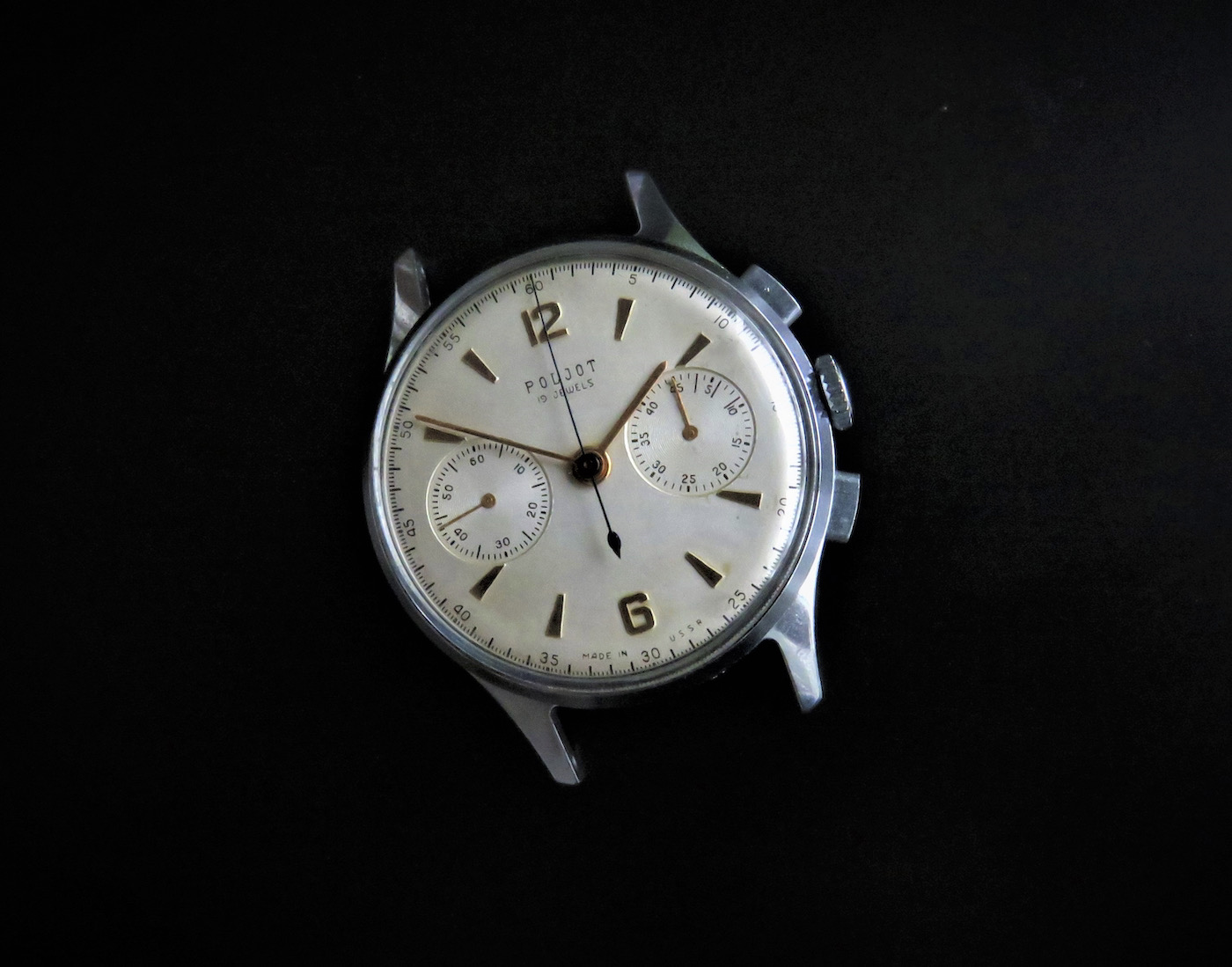
Another first-generation 3017 chronograph, referred to as the “12-6 Strela.” Great watches, but hard to find.
Aesthetically, what really sets the Strela chronograph apart is its maturity of design. With the Strela, the Soviets moved away from bold colors and wild designs to an aesthetic that had more in common with their Swiss counterparts. The cases were simple and elegant with a 36mm diameter that will look right at home on most wrists today. Almost without exception the cases were chrome plated, though there were a few limited editions produced with gold plated cases and possibly solid gold (if you’re searching for a Strela chronograph, we strongly recommend you stick with chrome plated examples since so few of the gold were ever made and the risk of getting an overpriced fake is too high). As a quick indication of when the watch was produced, take a look at the caseback. The first (and early part of the second) generation chronographs feature linear brushing while later generations feature circular brushing on the caseback. Along with the circular caseback brushing, the later generations also saw a change in the lug shape from faceted to straight lugs. Speaking of different generations of the watches, let’s break those down a bit:
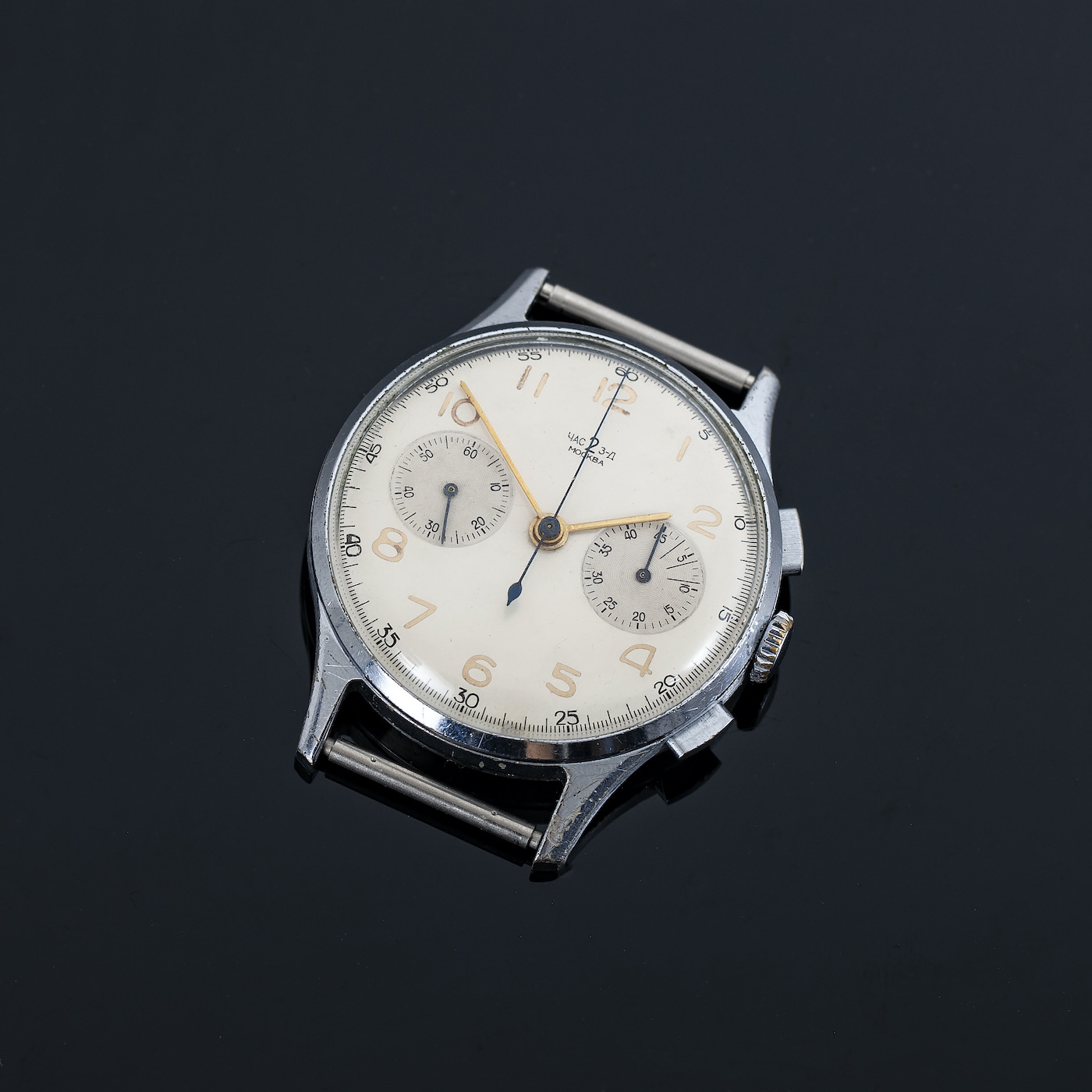
The 2MChZ 3017 chronograph is one of the rarest Soviet watches.
1st generation: The first prototypes of the Strela chronograph rolled off the line in 1958, though the watch went into full production in 1959 and continued into the latter half of the 1960s. At the start of production, these watches were made solely for professional use and were issued to pilots, special military personnel (and of course, some high-ranking functionaries). On the dial of these early watches, you’ll find Strela written in Cyrillic (СТРЕЛА), with Arabic numerals for the hour counters. That said, there are a few unicorn versions out there if you get lucky, including one with a brass color movement inscribed with NII Chasprom on the dial and the platine, and another with 2MChZ on the dial and the platine (even though it was produced in the 1MChZ factory), a split-second chronograph designated K-30, and a super-duper-maybe-not-even-real version with the 1MChZ logo on the dial.
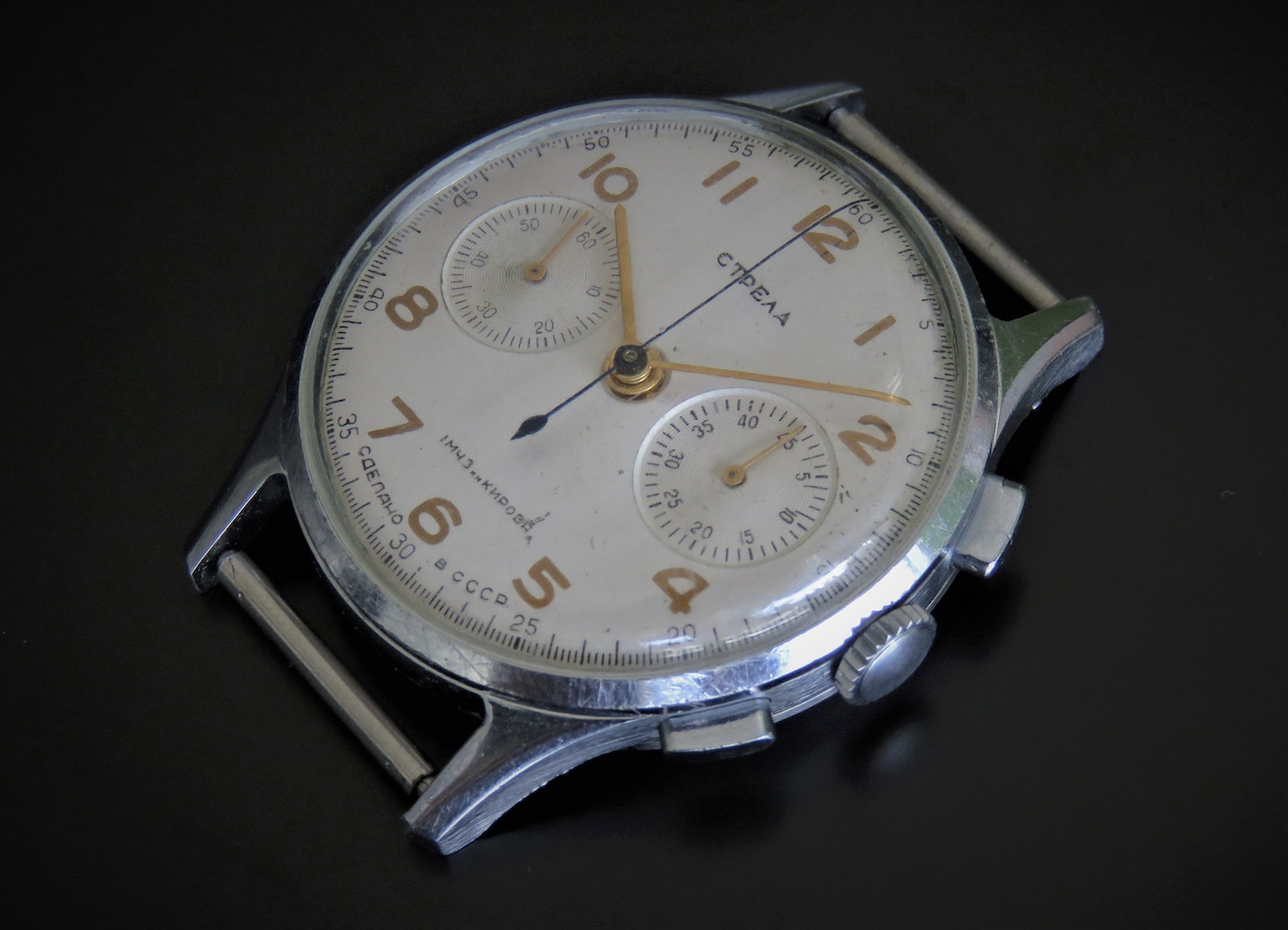
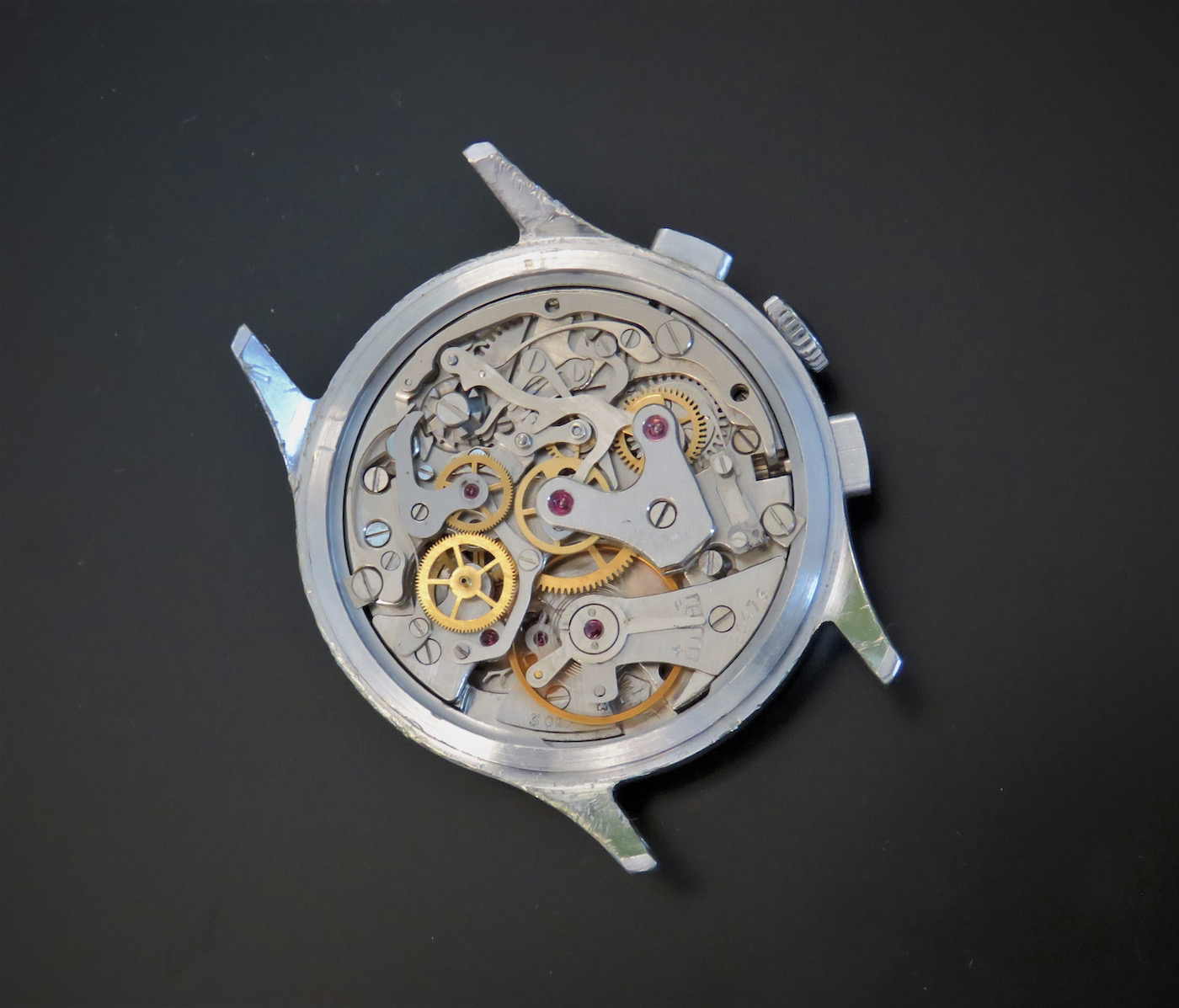
First generation 1MChZ Strela chronograph. After the NII Chasprom prototype and 2 MChZ experimental run, this was the first line of 3017 watches. This line was made in relatively low numbers, so finding a good quality example is challenging.
As production ramped up, the Strela chronographs quickly gained a reputation for being better made than any previous chronograph and, frankly, a damn fine-looking watch. The Soviets quickly saw an opportunity and began pushing forward with new designs and made the chronographs available to the public. When these were launched for the public, the Arabic numerals were dropped from all the markers except 12 and 6 o’clock. This new version, also referred to as the “baton,” came with three names on the dial:
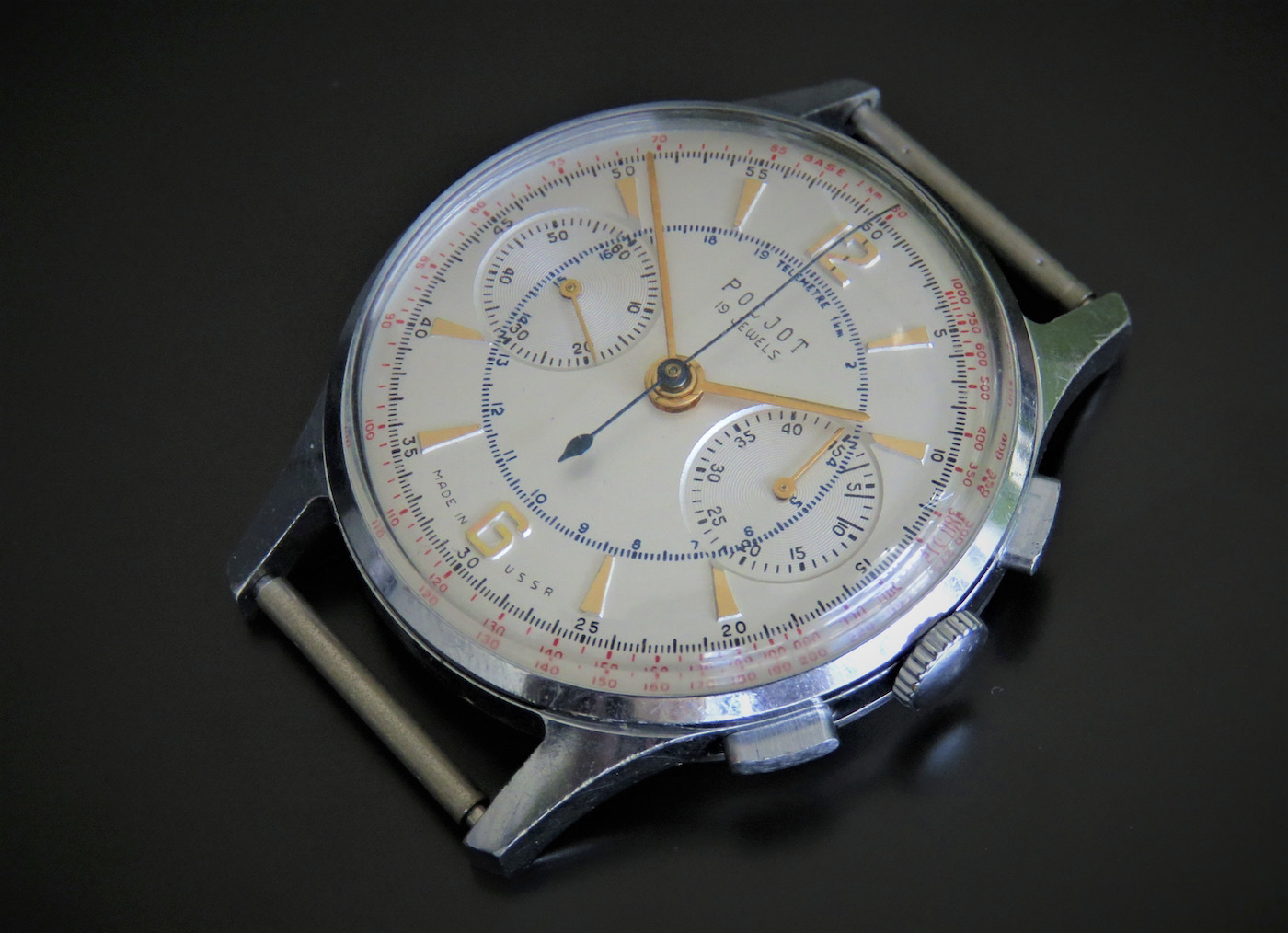
Second-generation 3017 chronograp, called the “Telemeter,” with one of the most distinctive designs of the 3017 series.
Strela (in Cyrillic) — These watches were made for professionals, but also available to the domestic market and was only available for a few years during the mid 1960s. Some of these watches also featured an inscription of KL 1, which stood for first class, indicating that these were the best pieces that were subject to additional testing for accuracy (similar to COSC chronometer testing). Not surprisingly, these KL 1 versions were destined for the wrists of professionals.
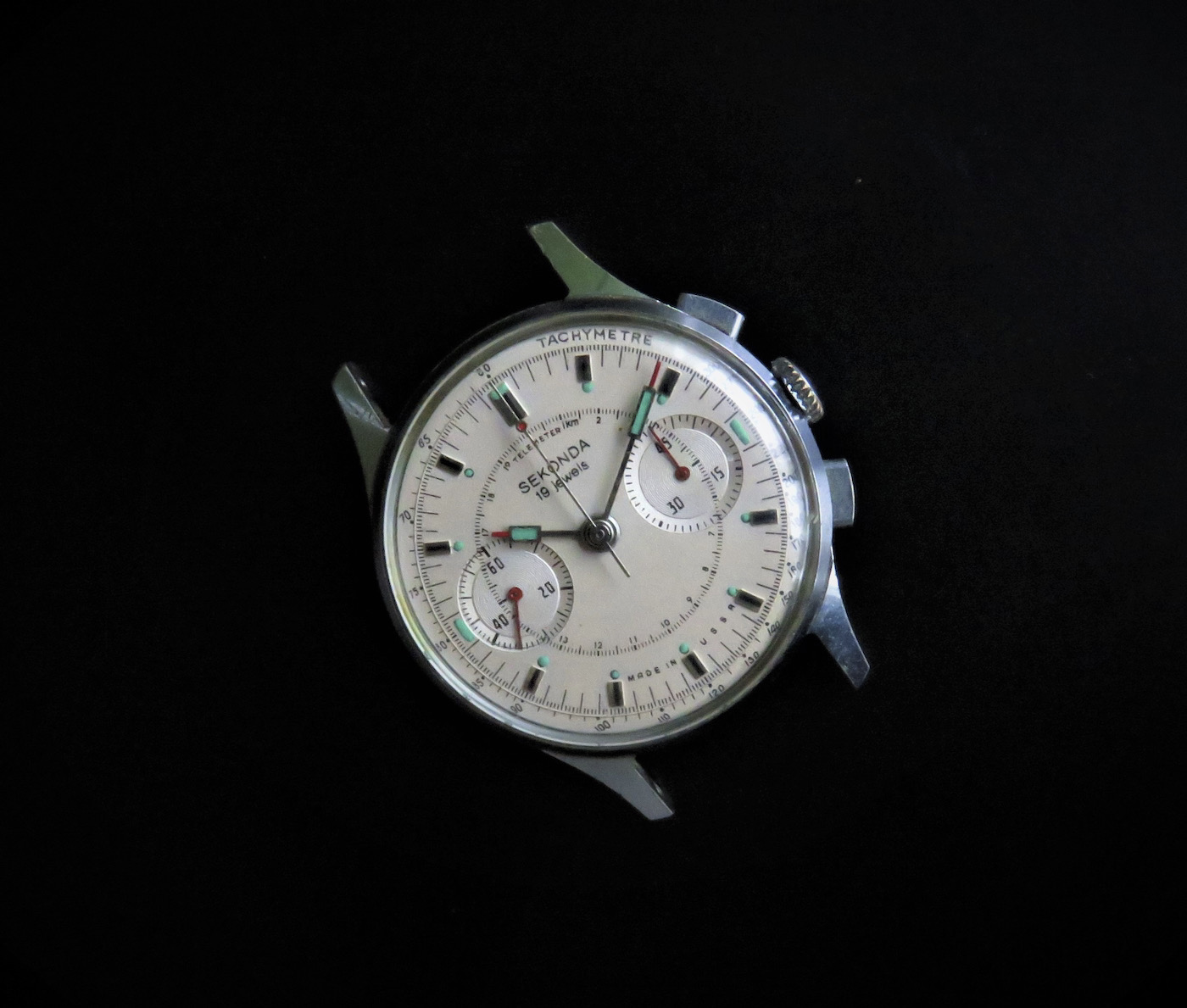
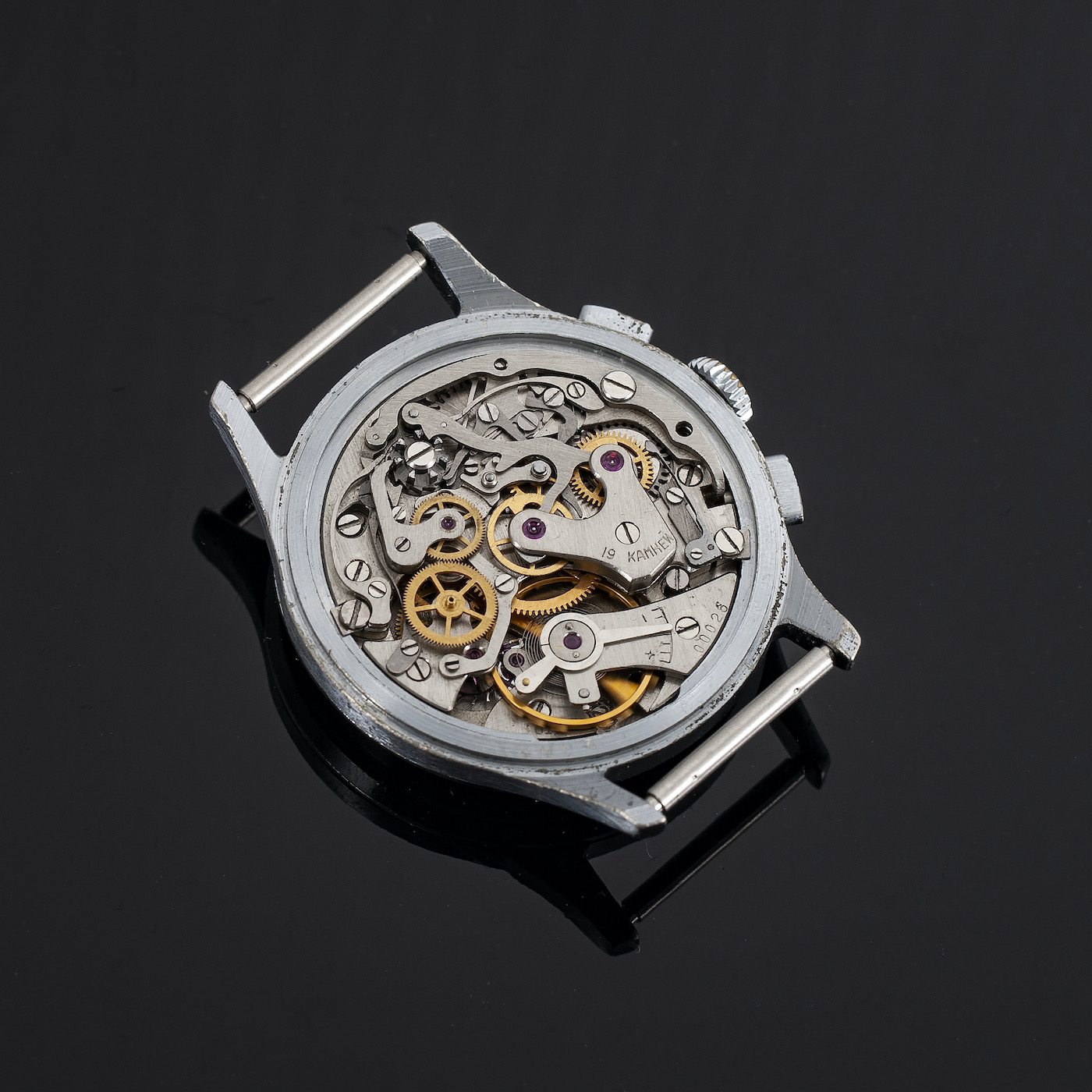
Third-generation 3017 with lume dial and hands. The watches branded Sekonda were made for the foreign market.
Poljot and Sekonda (both names written in Latin script) — These models were introduced in the mid-1960s and were primarily produced for the export market. However, these watches were still available domestically – primarily because demand for exported goods was high, fuelled by a false belief that factories applied higher standards to exported goods. Sekonda-branded watches were destined primarily for sale in Great Britain.
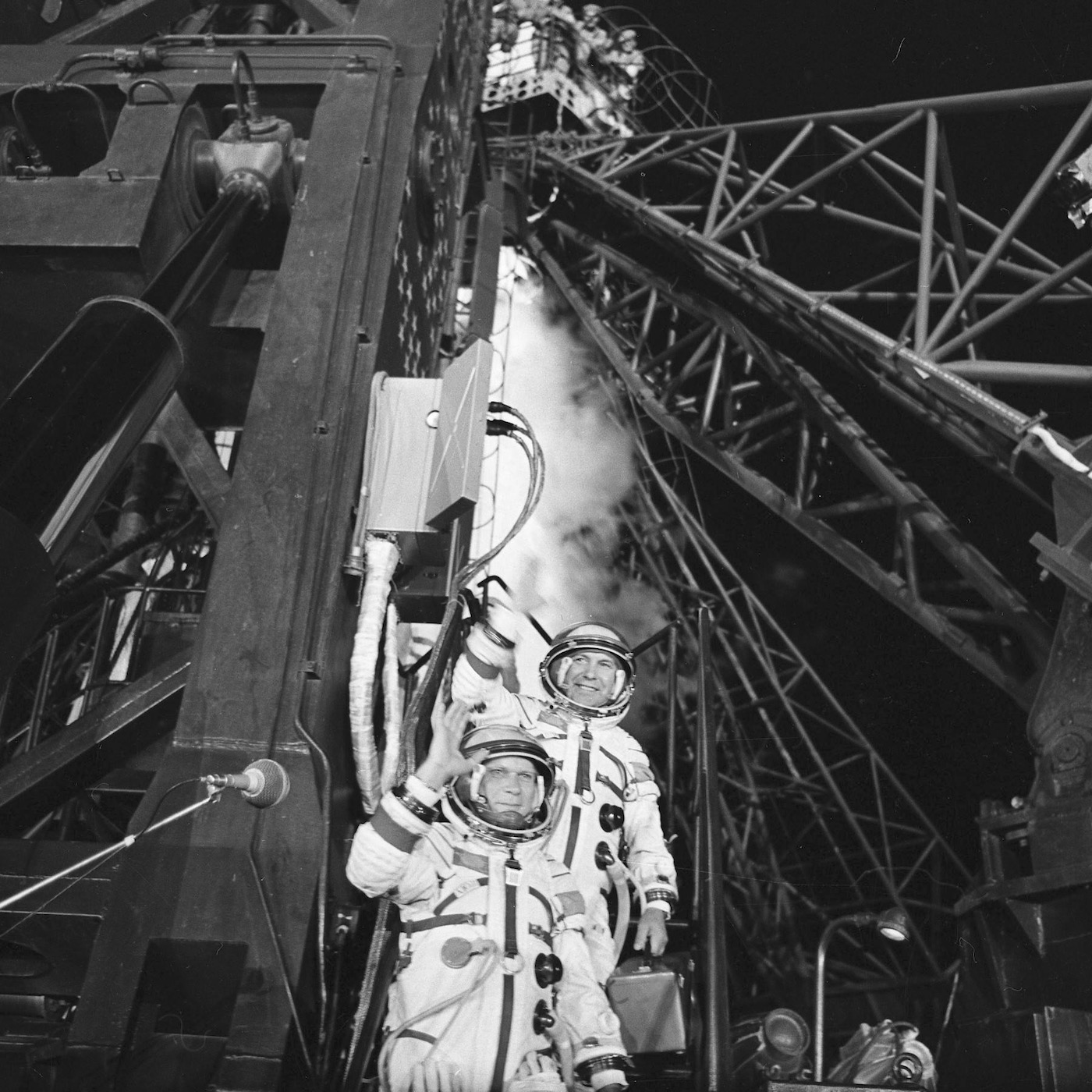
Pavel Popovich and Yuri Artyukhin boarding the Soyuz-14 spacecraft on July 3rd 1974 with 3rd generation black dial caliber 3017 chronographs.
Every model in the first generation will have straight brushing on the caseback and a pentagonal or rhombus logo on the movement. The lugs aren’t as useful an indicator as they can be either faceted or straight. It is a popular theory among collectors that Strela on the dial is always associated with faceted lugs, but we have seen early examples with straight lugs. Although the case was slightly different than the straight lug case from later 2nd and 3rd generations of 3017 watches. To put it simply – don’t immediately dismiss a 1st generation Strela with straight lugs!
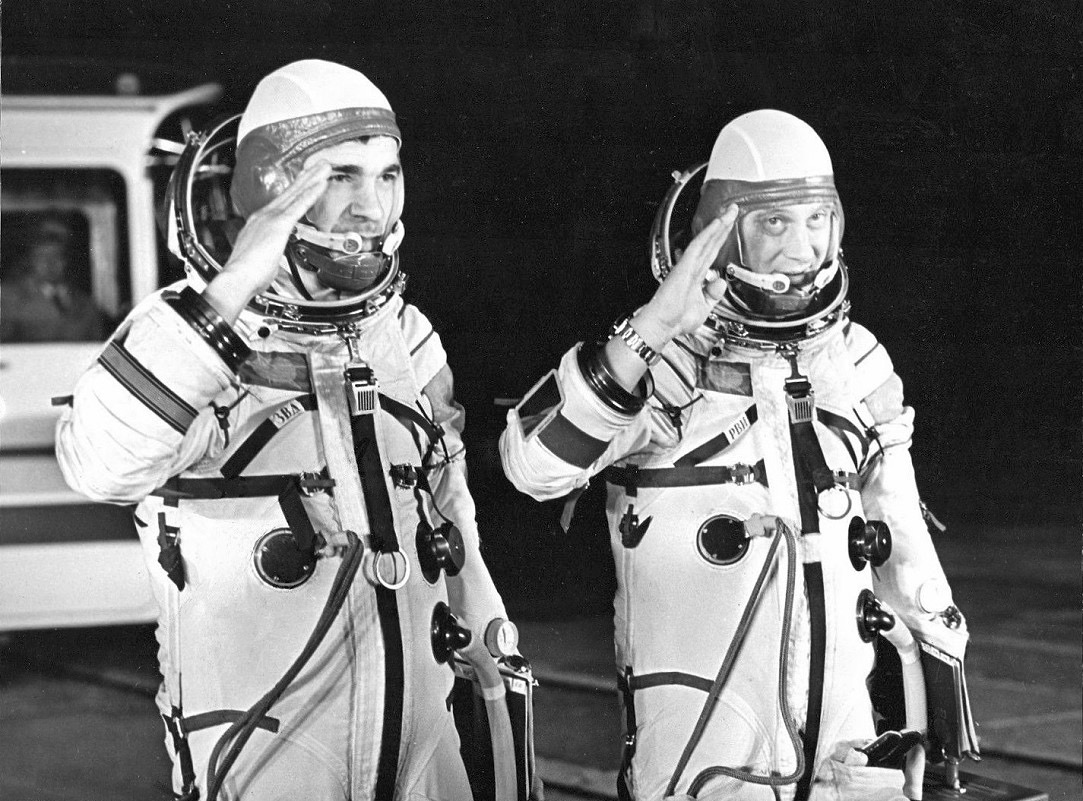
Cosmonauts Vyacheslav Zoudov and Valeriy Rozhdestvenskiy preparing for the Soyuz-23 spacecraft mission on Oct 14th, 1976. Both are wearing 3rd generation black dial caliber 3017 chronographs strapped to their left wrists.
2nd generation: Beginning in the late 1960s and lasting for approximately 10 years, the second generation introduced some new features (aside from just the brushing on the caseback and straight lugs), most prominently on the dial. The second generation added a tachymeter scale to the dial of all the watches and the watches continued to be branded as Strela, Poljot, or Sekonda.
3rd generation: The final generation of 3017 chronographs, these watches were made throughout the 1970s, with production finally ceasing in 1979. With the 3rd generation, things take a major turn aesthetically. Featuring luminous markers and hands and futuristic details, these watches were nothing if not on-trend for the 1970s. Nicknamed the “paddle hands 3017”, these watches all feature straight lugs, circular brushed caseback, the Poljot crown logo under the balance, and a full intermediate chronograph wheel. At this point, the Strela brand name was completely abandoned, along with the KL 1 designation (presumably because all the watches now met these requirements). Another major departure with this generation was the fact that these watches came in both black and white dial versions. At this point, Pojot also added a new brand variation, Exacta, intended for the German market and other parts of Central Europe. The Exacta versions were available only in black and are decidedly more rare than the others.
If you’re on the hunt for a Strela chronograph, be warned, there are plenty of fakes and franken watches to lead you astray. Follow the common adage of “buy the seller” and be prepared to pay a bit extra for a quality example from a trusted seller.
Special thanks to (Dmitry Troshin aka rastafar80), David Abishov (@authentic_soviet_watches on Instagram), Yury (aka feindselig), and (Ollie Halls @the_second_hand_ on Instagram) for help with photos and fact checking.

